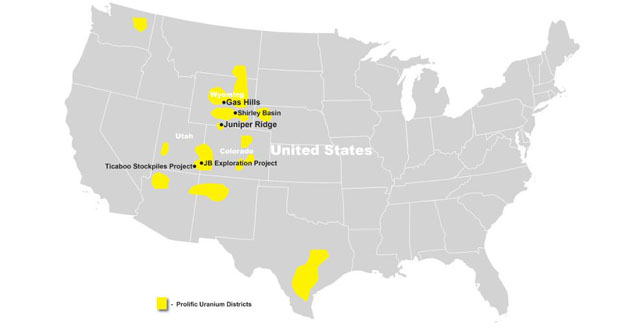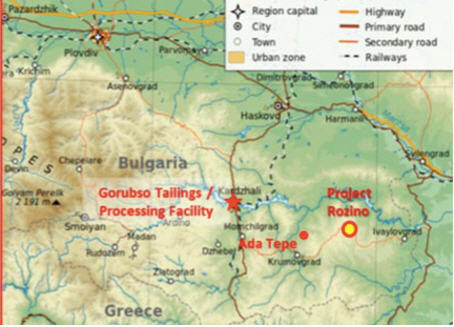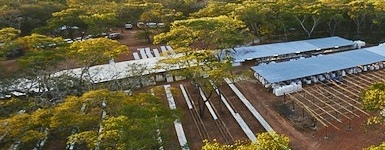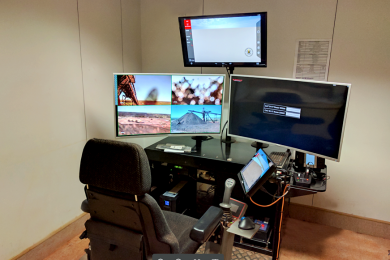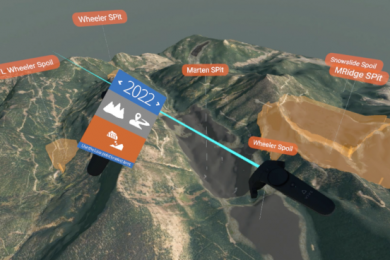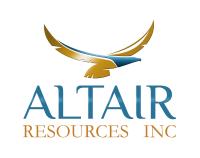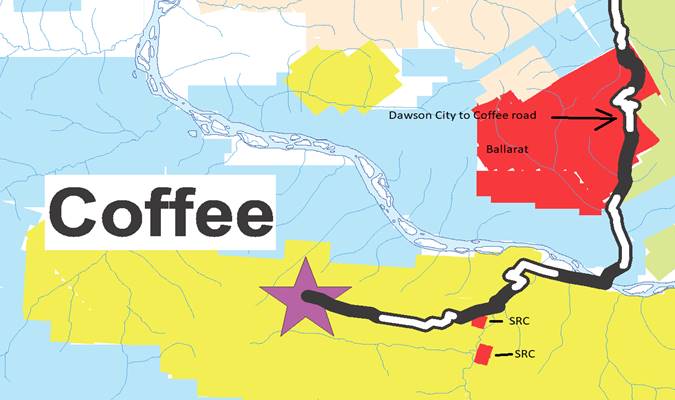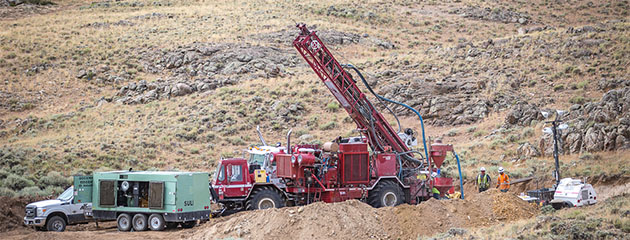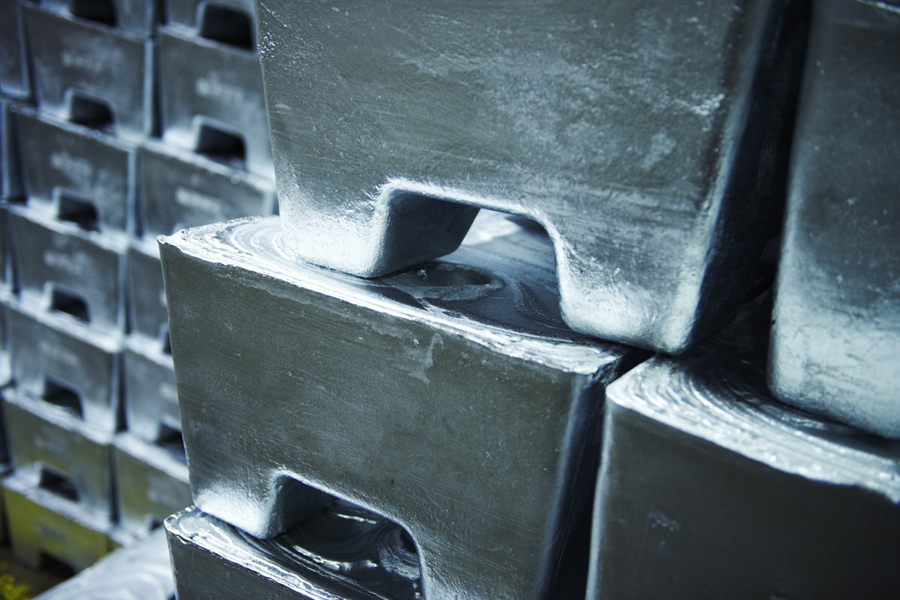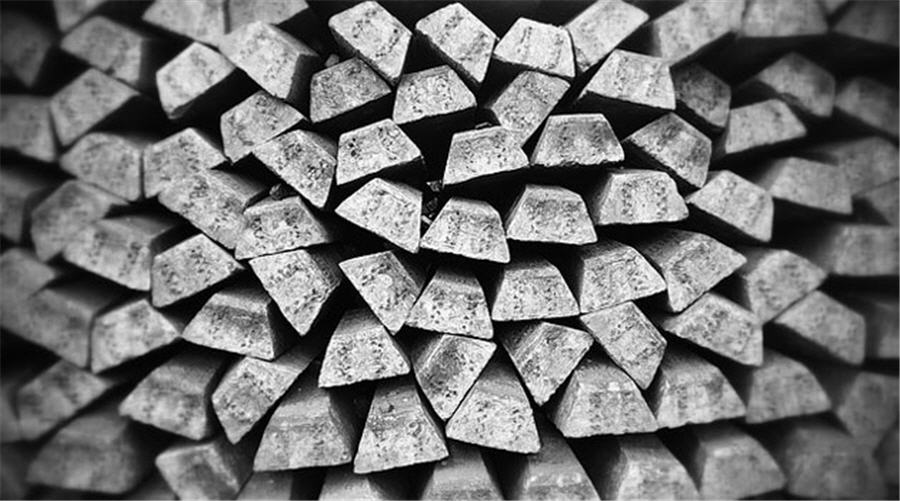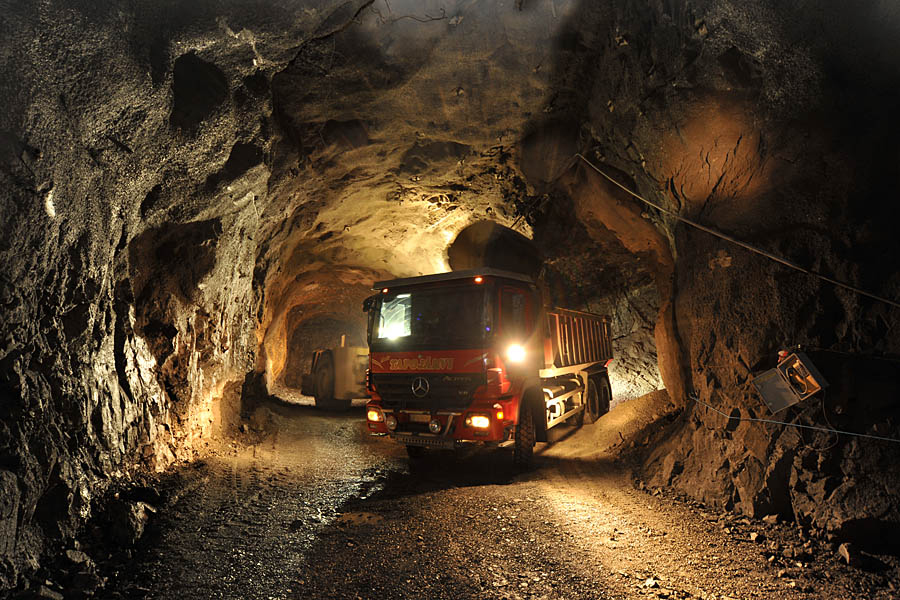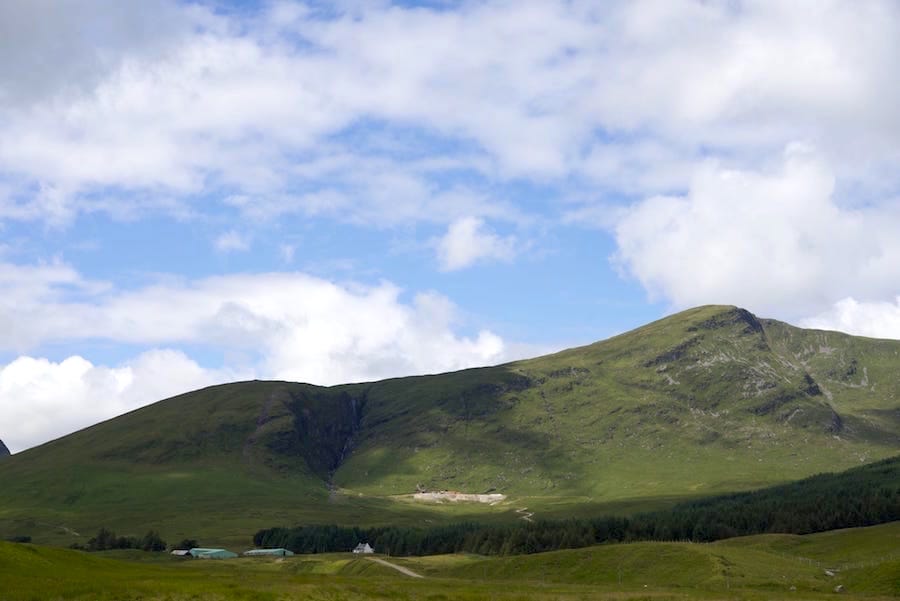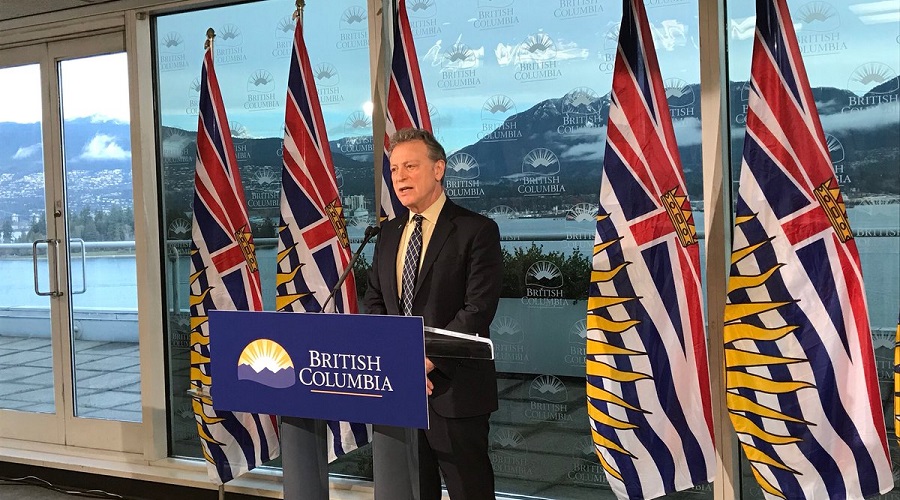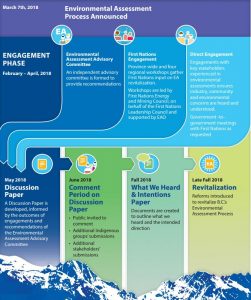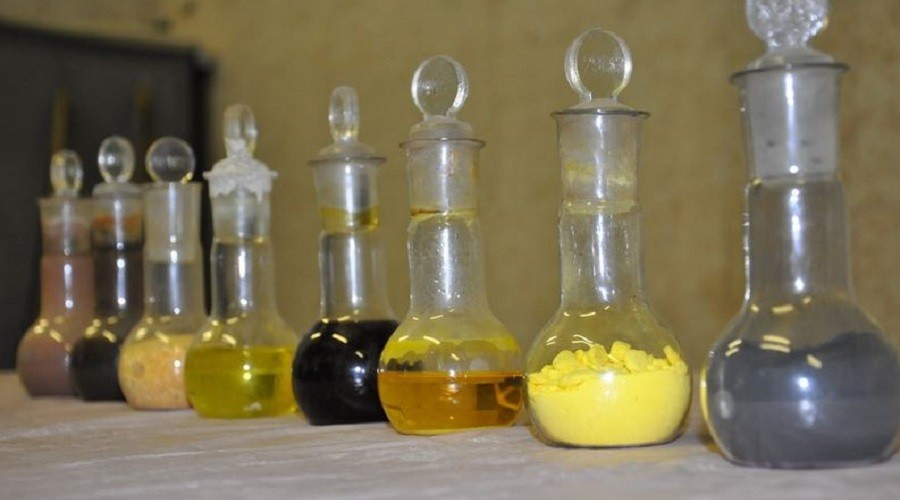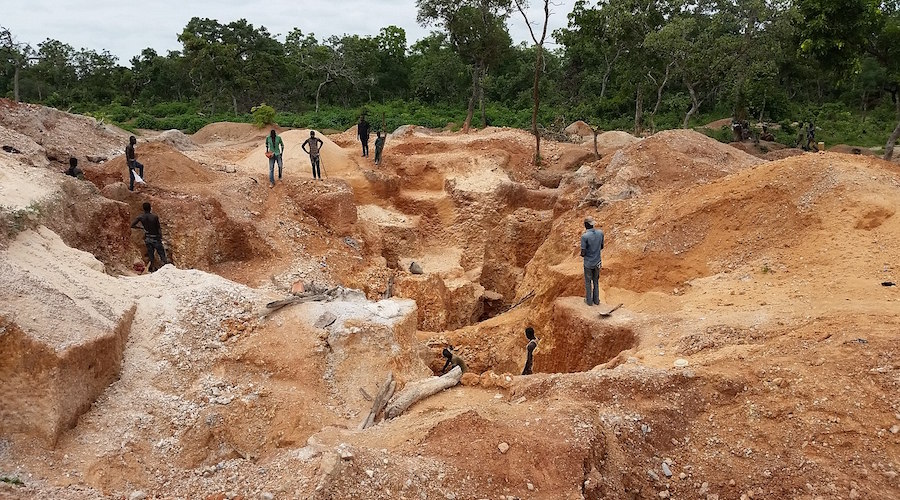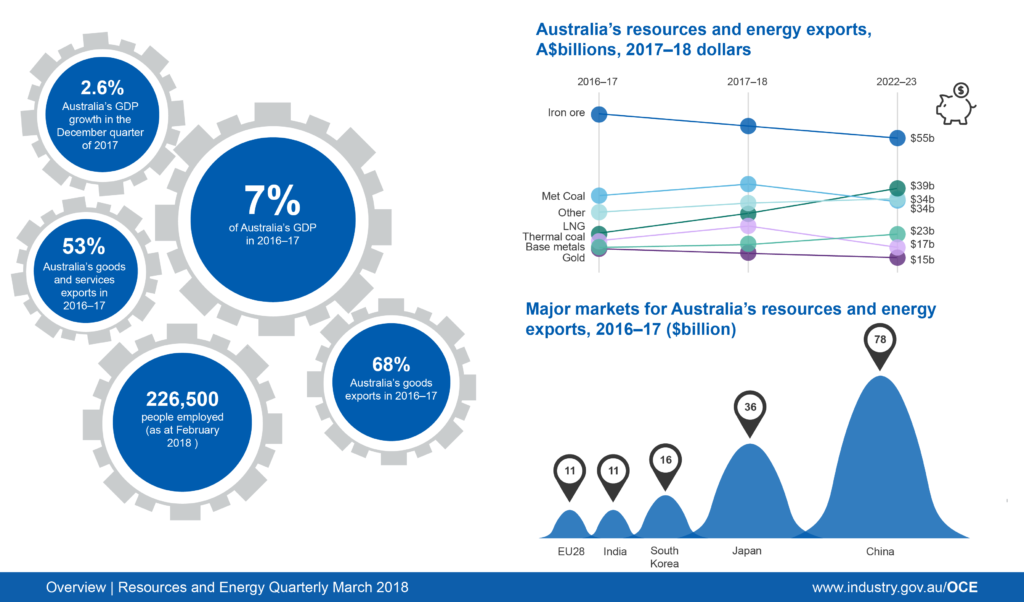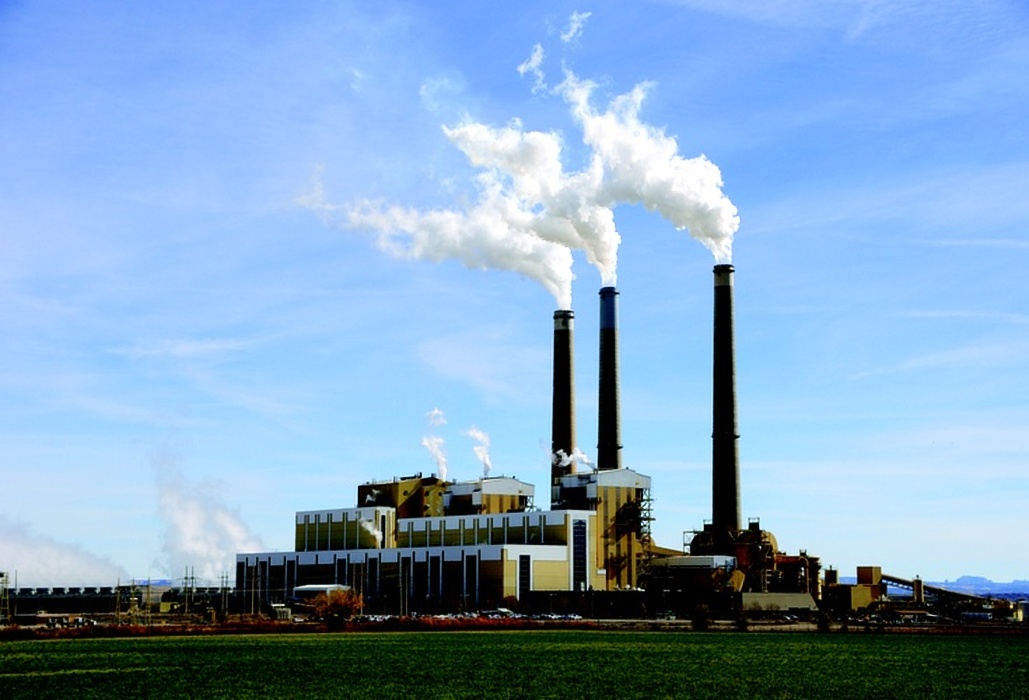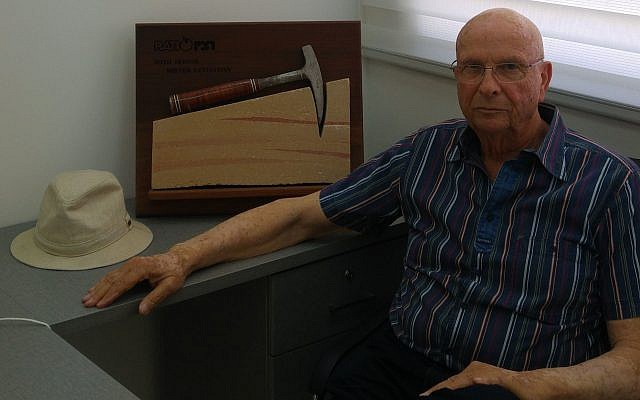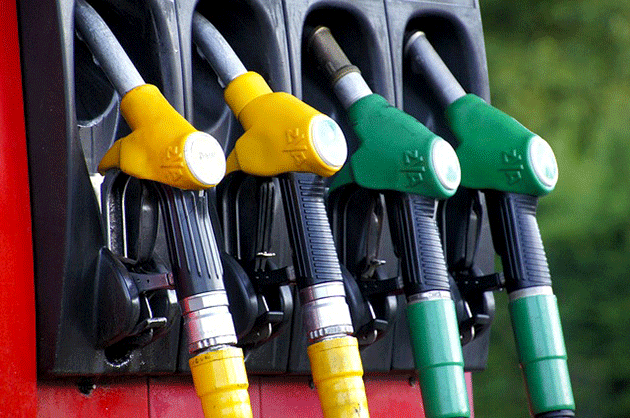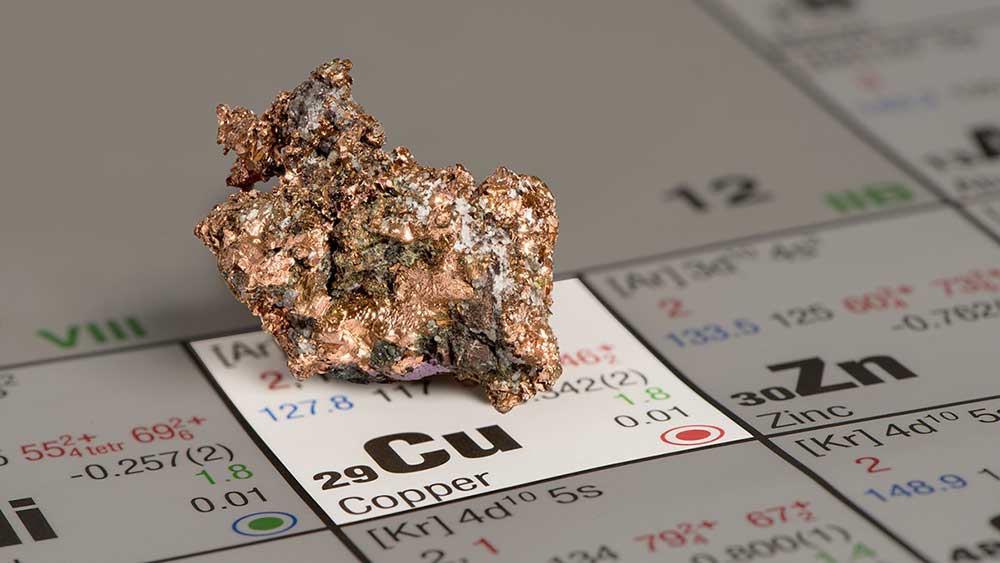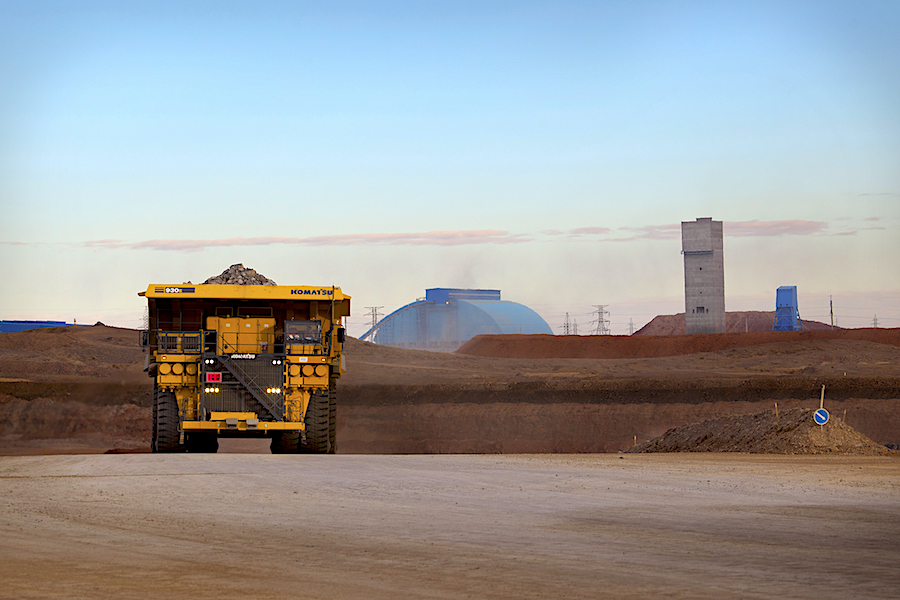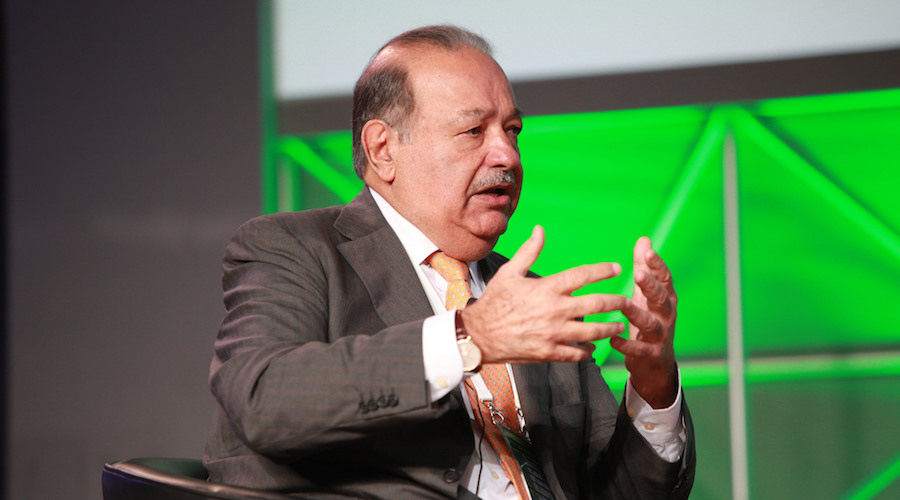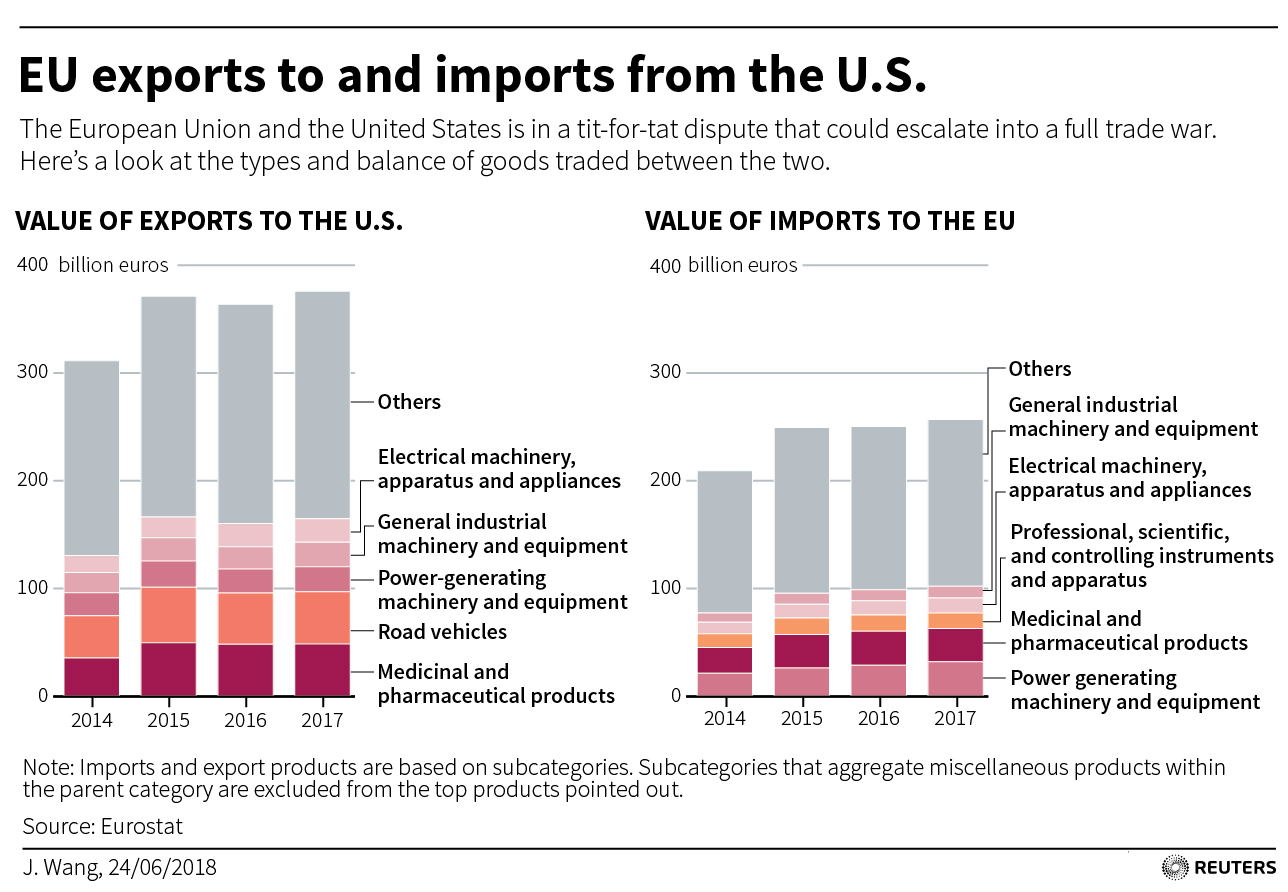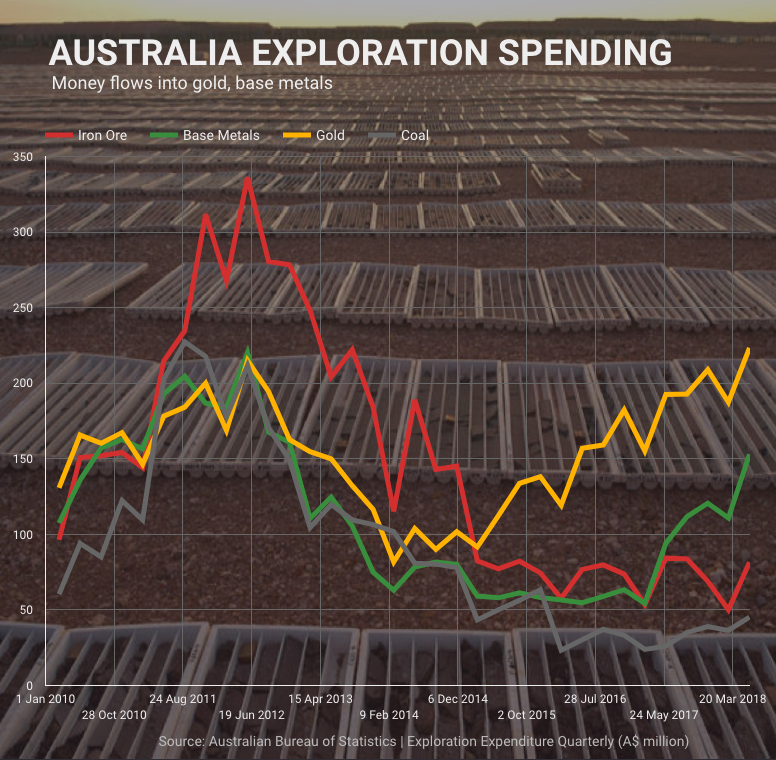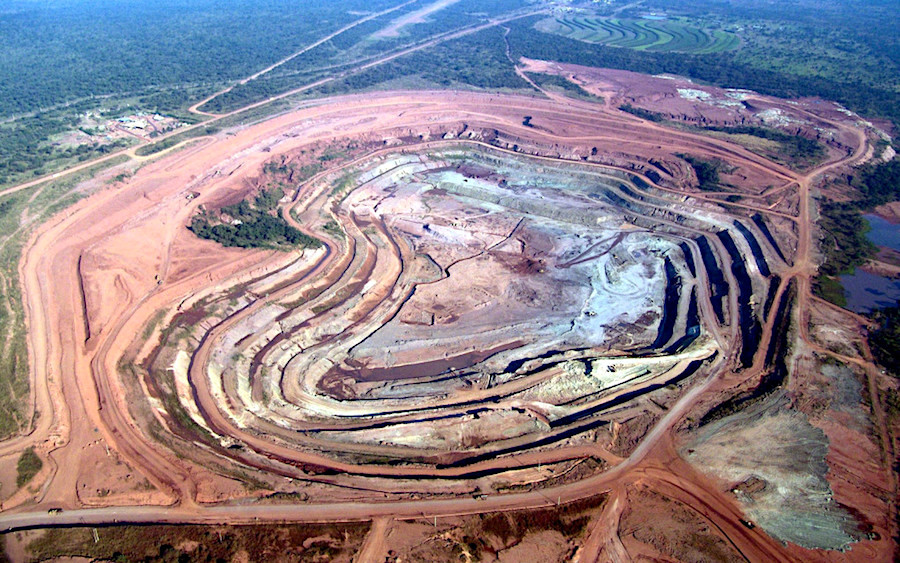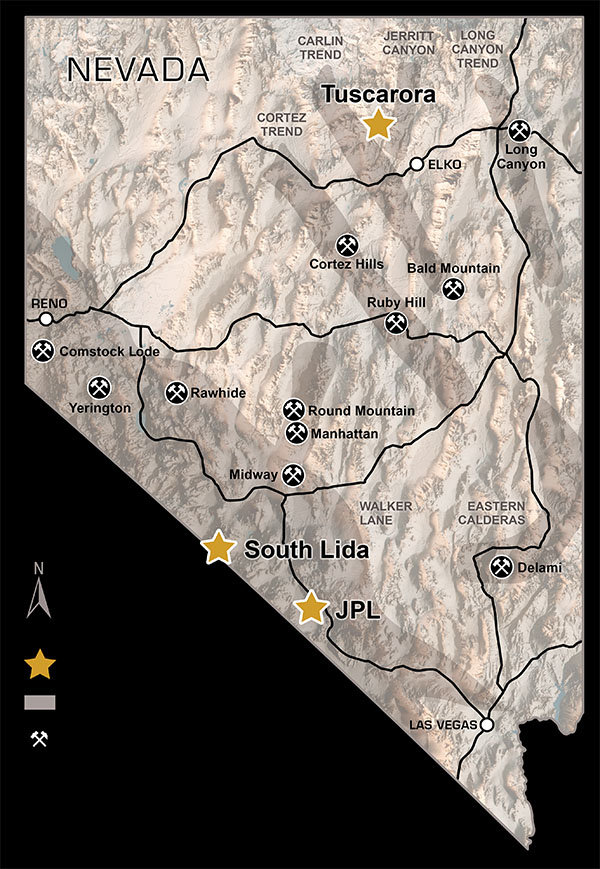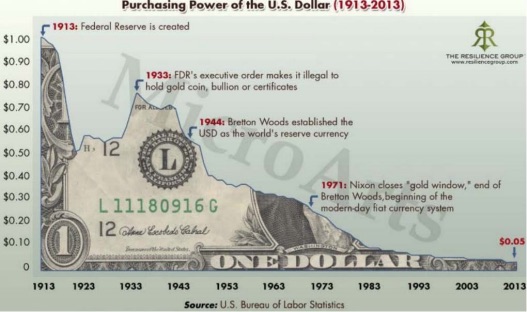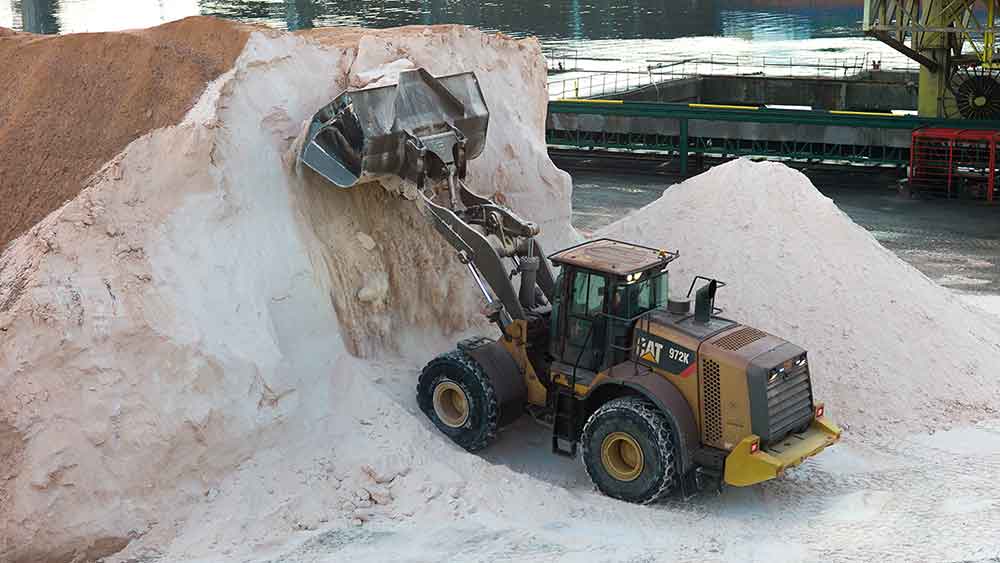Rohstoffe, Angebot/Nachfrage - 500 Beiträge pro Seite (Seite 4)
eröffnet am 11.09.14 08:32:17 von
neuester Beitrag 02.11.19 22:08:46 von
neuester Beitrag 02.11.19 22:08:46 von
Beiträge: 2.052
ID: 1.198.959
ID: 1.198.959
Aufrufe heute: 0
Gesamt: 67.810
Gesamt: 67.810
Aktive User: 0
Top-Diskussionen
| Titel | letzter Beitrag | Aufrufe |
|---|---|---|
| vor 18 Minuten | 10970 | |
| vor 44 Minuten | 8118 | |
| vor 20 Minuten | 5015 | |
| heute 21:42 | 4159 | |
| vor 1 Stunde | 3769 | |
| vor 45 Minuten | 3617 | |
| vor 1 Stunde | 2846 | |
| vor 38 Minuten | 2727 |
Meistdiskutierte Wertpapiere
| Platz | vorher | Wertpapier | Kurs | Perf. % | Anzahl | ||
|---|---|---|---|---|---|---|---|
| 1. | 1. | 18.075,00 | +0,33 | 239 | |||
| 2. | 34. | 1,3800 | -1,43 | 102 | |||
| 3. | 4. | 0,1890 | -2,58 | 81 | |||
| 4. | 3. | 172,21 | +6,22 | 78 | |||
| 5. | 2. | 9,3325 | -3,69 | 77 | |||
| 6. | 14. | 7,0010 | +4,17 | 53 | |||
| 7. | 18. | 22,240 | -3,22 | 40 | |||
| 8. | 6. | 0,0160 | -24,17 | 38 |
Antwort auf Beitrag Nr.: 55.951.862 von Popeye82 am 14.10.17 06:18:11
Antwort auf Beitrag Nr.: 55.951.868 von Popeye82 am 14.10.17 06:29:10Largest Gold Discovery in >133 Years


"The Chinese government has actively launched numerous policies to guide and support the development of the non-ferrous
metals industry. The “One Belt and One Road” Summit Forum for International Cooperation was held in Beijing in May this
year, which is expected to create new development opportunities for the non-ferrous metals industry. Many countries
participating in the “One Belt and One Road” initiative are rich in mineral resources, which is strongly complementary with
China as the major consuming country. Strengthening investments in mineral resources exploration and development and
cooperation with countries within the “One Belt and One Road” sphere would play a vital role in strengthening China’s
diversified supply sourcing and enhancing its risk protection capabilities. Furthermore, “One Belt and One Road” would
promote the trade development of bulk commodities, thus potentially driving up commodity prices from the import and
export perspective.
As an important participant of China’s “One Belt and One Road” initiative, Myanmar has a strategic geographical location
and is the largest neighbor of China in terms of size, with a long border between the two countries. In April, Htin Kyaw,
President of Myanmar who has taken office for more than a year, visited China for the first time. During the visit, he
proclaimed that the participation in “One Belt and One Road” would strengthen Myanmar’s cooperation with other countries,
and also provide development opportunities for the country in trade, investment and infrastructure construction. Cooperation
in the field of mineral resources is an important integral part of the “One Belt and One Road” strategy. Myanmar has rich
mineral resources. However, its mineral resource exploration, development, and mining capabilities are relatively antiquated,
and its infrastructure is lacking. By making use of China’s strength in equipment, technology and capital, Myanmar could
develop the mining industry and its economy, and at the same time, help optimize China’s mining industry structure.
Looking forward to the second half of 2017 at the international market, the basic metal market is expected to experience
some adjustment fluctuations. In terms of LME copper, as the anticipated impact of U.S. interest rate increase is falling, the
LME copper setback would stabilize. Conversely, copper demand may stall because of the upcoming consumption decline
during the off season, so the LME copper is expected to experience some adjustments. For LME zinc, cancelled warehouse
warrants for LME zinc have increased apparently, indicating that the zinc stock is in decline. Couple that with the anticipated
tight supply should lend support to the zinc price, experiencing some fluctuations.
In the domestic market, the development of the non-ferrous metal industry will face both challenges and opportunities in the
second half of 2017. The commodity market will be subject to a cautiously-optimistic environment and continue to be slightly
fluctuative. Being an important development sector in the “One Belt and One Road” strategy, the non-ferrous metal industry
should seek opportunities to make positive reforms on the supply side,
and increase profitability and stabilize development
simultaneously."
www.internet.com
metals industry. The “One Belt and One Road” Summit Forum for International Cooperation was held in Beijing in May this
year, which is expected to create new development opportunities for the non-ferrous metals industry. Many countries
participating in the “One Belt and One Road” initiative are rich in mineral resources, which is strongly complementary with
China as the major consuming country. Strengthening investments in mineral resources exploration and development and
cooperation with countries within the “One Belt and One Road” sphere would play a vital role in strengthening China’s
diversified supply sourcing and enhancing its risk protection capabilities. Furthermore, “One Belt and One Road” would
promote the trade development of bulk commodities, thus potentially driving up commodity prices from the import and
export perspective.
As an important participant of China’s “One Belt and One Road” initiative, Myanmar has a strategic geographical location
and is the largest neighbor of China in terms of size, with a long border between the two countries. In April, Htin Kyaw,
President of Myanmar who has taken office for more than a year, visited China for the first time. During the visit, he
proclaimed that the participation in “One Belt and One Road” would strengthen Myanmar’s cooperation with other countries,
and also provide development opportunities for the country in trade, investment and infrastructure construction. Cooperation
in the field of mineral resources is an important integral part of the “One Belt and One Road” strategy. Myanmar has rich
mineral resources. However, its mineral resource exploration, development, and mining capabilities are relatively antiquated,
and its infrastructure is lacking. By making use of China’s strength in equipment, technology and capital, Myanmar could
develop the mining industry and its economy, and at the same time, help optimize China’s mining industry structure.
Looking forward to the second half of 2017 at the international market, the basic metal market is expected to experience
some adjustment fluctuations. In terms of LME copper, as the anticipated impact of U.S. interest rate increase is falling, the
LME copper setback would stabilize. Conversely, copper demand may stall because of the upcoming consumption decline
during the off season, so the LME copper is expected to experience some adjustments. For LME zinc, cancelled warehouse
warrants for LME zinc have increased apparently, indicating that the zinc stock is in decline. Couple that with the anticipated
tight supply should lend support to the zinc price, experiencing some fluctuations.
In the domestic market, the development of the non-ferrous metal industry will face both challenges and opportunities in the
second half of 2017. The commodity market will be subject to a cautiously-optimistic environment and continue to be slightly
fluctuative. Being an important development sector in the “One Belt and One Road” strategy, the non-ferrous metal industry
should seek opportunities to make positive reforms on the supply side,
and increase profitability and stabilize development
simultaneously."
www.internet.com
Antwort auf Beitrag Nr.: 55.966.428 von Popeye82 am 17.10.17 15:34:44er kann SPRECHEN
(muss wohl studiert haben)
(muss wohl studiert haben)
Antwort auf Beitrag Nr.: 55.966.629 von Popeye82 am 17.10.17 15:57:06er kann auch noch SEHEN
(wohl hochbegabt)
(wohl hochbegabt)
Antwort auf Beitrag Nr.: 55.999.827 von Popeye82 am 22.10.17 01:07:42HISTORIC shift of risks

http://www.ey.com/Publication/vwLUAssets/ey-top-10-business-…
http://www.ey.com/gl/en/industries/mining---metals/business-…

http://www.ey.com/Publication/vwLUAssets/ey-top-10-business-…
http://www.ey.com/gl/en/industries/mining---metals/business-…
Dieses Bild ist nicht SSL-verschlüsselt: [url]http://arizonasonoranewsservice.com/wordpress/wp-content/uploads/2017/09/queen-mine-3-500x333.jpg
[/url]http://arizonasonoranewsservice.com/arizona-looks-to-make-a-…
Antwort auf Beitrag Nr.: 56.053.403 von Popeye82 am 29.10.17 18:18:50
aussie hunters
Antwort auf Beitrag Nr.: 56.067.638 von Popeye82 am 31.10.17 19:21:06
Approximately 98% of the world’s supply of cobalt comes from copper and nickel production, with 15 mines representing half of the world’s supply. This makes the supply stream for cobalt highly sensitive to disruptions caused by mine related issues. A recent example was the shutdown of copper mining in the Katanga Province in the DRC due low copper prices, which cut 3% of the world’s cobalt supply.
http://benchmarkminerals.com/where-is-new-lithium-ion-batter…
"Rise of the lithium ion battery megafactories: what does 2018 hold?
11th December 2017Announcements, Batteries, Benchmark, Gigafactory, Megafactory, TeslaBenchmark Mineral Intelligence
Since Benchmark Mineral Intelligence coined the term Battery Megafactory in 2014 the landscape of the lithium ion battery industry has changed significantly.
Early on, Benchmark noticed a step change in the way battery supply and demand was developing and the corresponding growth in the size of planned cell production plants on a multi-gigawatt scale. These larger facilities, with a capacity of producing 1GWh or more of cells per year (megafactories) were to become the new standard for the industry.
At the time, there were only three planned plants, Tesla’s Gigafactory in the US, LG Chem’s plant in Nanjing, China and Foxconn’s plant in Anhui, China which didn’t make it off the drawing board.
Today the Benchmark Mineral Intelligence megafactory tracker includes 26 battery cell plants that are either in production and due to expand capacity or new operations due to be in production by 2021.
The combined planned capacity of these plants is 344.5GWh. To put that into perspective total lithium ion cell demand in 2017 is estimated at 100GWh.
In the past 3 years China has been leading the way in investment for these megafactories, but more recently the rest of the world – most notably Europe – has woken up to the energy storage revolution and the need for locally produced cells.
China is still by far the dominant force in the industry with 49% of planned capacity totalling 169 GWh, the most recently added Chinese megafactory to the tracker was number 24, Great Power’s planned 10GWh plant in Guangzhou.
Following China is the EU, totalling 23% of planned capacity or 78.5GWh. Prior to 2017, the EU was falling far behind the rest of the world, with just one plant planned by LG Chem in Poland with 5GWh capacity.
The acceleration of activity in the European market was driven by two facilities – TerraE’s 34GWh facility in Germany and Northvolt’s 32GWh offering in Sweden. Europe is also the home for megafactory number 25, SK Innovations plant in Hungary with a capacity of 7.5 GWh.
Whilst the US is third on the list, with 53GWh and 15% of capacity it is worth noting that Tesla has further expansions planned for the Gigafactory beyond 2021 and have stated publicly that they expect to be able to achieve 150GWh out of the plant, no small feat as they get to grips with the mass market scale of production of the Model 3.
Lithium ion in 2018? More of the same
So what does the future hold? Benchmark expects the trend to continue into 2018 with new plant announcements likely.
Tesla is still to release official details of the planned facility in Shanghai , China which we fully expect to become a vertically integrated battery facility, and there will likely be further offerings (or joint ventures) from other auto manufacturers looking to build the foundations to become leaders in the EV space.
Raw material security is now firmly on the agenda of many major auto manufacturers – VW and China’s Great Wall Motor have been the most active in trying to secure lithium and cobalt of late.
However, the question remains whether auto majors are fully comfortable with their lithium ion battery supply of which the vast majority of near term new capacity is being build in China.
Europe, especially, is some way behind in the race to build out new cell capacity while North America is still heavily reliant on a successful Tesla Gigafactory ramp up and if successful will still be captive supply for world’s highest profile EV manufacturer.
And while many megafactories are being announced, how many will be realised, at what capacity and by when? This is one of the biggest risks the auto manufacturers face in the next 5 years.
Further battery supply growth expectations may seem excessive considering the new lithium ion battery pipeline is at the 344.5GWh mark… but the industry needs it.
Benchmark forecasts world lithium ion battery demand to grow by between 6 and 7 times by 2026 which will require a battery pipeline of nearly double what we have today.
Constructing the plants is relatively easy if the funding and drive is there from the battery manufacturers, but if and when that problem is solved an even bigger one is faced: sourcing the raw materials to feed them and building out the supply chains for the 21st century energy storage revolution.
Benchmark Mineral Intelligence is the industry’s leading source of lithium ion battery market data and analysis. We publish monthly price assessments for lithium, graphite and cobalt.
Each year we also host the Benchmark World Tour investment seminars and industry conferences, Cathodes Conference and Graphite + Anodes.
To subscribe or for more email: info@benchmarkminerals.com
WATCH: Star appeal: Elon Musk shows Leo DiCaprio the Tesla Gigafactory"
"Rise of the lithium ion battery megafactories: what does 2018 hold?
11th December 2017Announcements, Batteries, Benchmark, Gigafactory, Megafactory, TeslaBenchmark Mineral Intelligence
Since Benchmark Mineral Intelligence coined the term Battery Megafactory in 2014 the landscape of the lithium ion battery industry has changed significantly.
Early on, Benchmark noticed a step change in the way battery supply and demand was developing and the corresponding growth in the size of planned cell production plants on a multi-gigawatt scale. These larger facilities, with a capacity of producing 1GWh or more of cells per year (megafactories) were to become the new standard for the industry.
At the time, there were only three planned plants, Tesla’s Gigafactory in the US, LG Chem’s plant in Nanjing, China and Foxconn’s plant in Anhui, China which didn’t make it off the drawing board.
Today the Benchmark Mineral Intelligence megafactory tracker includes 26 battery cell plants that are either in production and due to expand capacity or new operations due to be in production by 2021.
The combined planned capacity of these plants is 344.5GWh. To put that into perspective total lithium ion cell demand in 2017 is estimated at 100GWh.
In the past 3 years China has been leading the way in investment for these megafactories, but more recently the rest of the world – most notably Europe – has woken up to the energy storage revolution and the need for locally produced cells.
China is still by far the dominant force in the industry with 49% of planned capacity totalling 169 GWh, the most recently added Chinese megafactory to the tracker was number 24, Great Power’s planned 10GWh plant in Guangzhou.
Following China is the EU, totalling 23% of planned capacity or 78.5GWh. Prior to 2017, the EU was falling far behind the rest of the world, with just one plant planned by LG Chem in Poland with 5GWh capacity.
The acceleration of activity in the European market was driven by two facilities – TerraE’s 34GWh facility in Germany and Northvolt’s 32GWh offering in Sweden. Europe is also the home for megafactory number 25, SK Innovations plant in Hungary with a capacity of 7.5 GWh.
Whilst the US is third on the list, with 53GWh and 15% of capacity it is worth noting that Tesla has further expansions planned for the Gigafactory beyond 2021 and have stated publicly that they expect to be able to achieve 150GWh out of the plant, no small feat as they get to grips with the mass market scale of production of the Model 3.
Lithium ion in 2018? More of the same
So what does the future hold? Benchmark expects the trend to continue into 2018 with new plant announcements likely.
Tesla is still to release official details of the planned facility in Shanghai , China which we fully expect to become a vertically integrated battery facility, and there will likely be further offerings (or joint ventures) from other auto manufacturers looking to build the foundations to become leaders in the EV space.
Raw material security is now firmly on the agenda of many major auto manufacturers – VW and China’s Great Wall Motor have been the most active in trying to secure lithium and cobalt of late.
However, the question remains whether auto majors are fully comfortable with their lithium ion battery supply of which the vast majority of near term new capacity is being build in China.
Europe, especially, is some way behind in the race to build out new cell capacity while North America is still heavily reliant on a successful Tesla Gigafactory ramp up and if successful will still be captive supply for world’s highest profile EV manufacturer.
And while many megafactories are being announced, how many will be realised, at what capacity and by when? This is one of the biggest risks the auto manufacturers face in the next 5 years.
Further battery supply growth expectations may seem excessive considering the new lithium ion battery pipeline is at the 344.5GWh mark… but the industry needs it.
Benchmark forecasts world lithium ion battery demand to grow by between 6 and 7 times by 2026 which will require a battery pipeline of nearly double what we have today.
Constructing the plants is relatively easy if the funding and drive is there from the battery manufacturers, but if and when that problem is solved an even bigger one is faced: sourcing the raw materials to feed them and building out the supply chains for the 21st century energy storage revolution.
Benchmark Mineral Intelligence is the industry’s leading source of lithium ion battery market data and analysis. We publish monthly price assessments for lithium, graphite and cobalt.
Each year we also host the Benchmark World Tour investment seminars and industry conferences, Cathodes Conference and Graphite + Anodes.
To subscribe or for more email: info@benchmarkminerals.com
WATCH: Star appeal: Elon Musk shows Leo DiCaprio the Tesla Gigafactory"
http://www.australianmining.com.au/news/resources-industry-r…
"Resources industry recovery to gather momentum in 2018: analysts
December 11, 2017News Australian Mining
Mining’s recovery in Australia has been forecast to accelerate into 2018 and beyond.
According to BIS Oxford Economics’ Mining in Australia 2017 to 2032 report, mining exploration, production and maintenance are all expected to lift significantly through 2018.
BIS has forecast the industry to track even higher in subsequent years as strengthening global economic growth supports commodity prices and underwrites new investment and mining operations expenditure.
Mining production only grew 2.5 per cent in 2016/17, according to Australian Bureau of Statistics (ABS) data, but BIS expects growth to accelerate to 5.5 per cent in 2017/18, with even stronger growth over the remainder of the decade.
“The enormous investment boom is now translating into production, particularly within oil and gas, where Australia is expected to become the leading LNG (liquefied natural gas) exporter by 2022,” BIS Oxford Economics Economist Rubhen Jeya said.
“Growth in mining production will be roughly double the pace of the national economy over the next five years.”
According to BIS, the completion of a $200 billion wave of LNG projects over the coming year will see aggregate investment decline further over the next two years.
The forecaster added, however, that this masked the start of a new cycle of investment across a range of commodities including copper, gold, coal and iron ore.
“The completion of the Wheatstone, Ichthys and Prelude projects will subtract a further $20 billion in mining investment over the next two years,” BIS Oxford Economics construction, maintenance and mining associate director Adrian Hart said.
“But excluding oil and gas, mining investment elsewhere is expected to grow at a double-digit pace over 2017/18 and 2018/19 – and will also continue to grow robustly through the subsequent three years.
“Considering that most LNG investment from here represents imports in any case, the time has come to stop blaming the mining investment bust as the reason behind sluggish Australian economic growth.”
The stronger investment outlook does not include Adani’s $16 billion Carmichael coal project in the Galilee Basin, which has not been included in BIS’s base case scenario for the next five years.
Hart said the Carmichael project was unlikely to proceed given long-term steaming coal price projections, relatively high development costs and risks to finance.
“But there are other coal projects which have re-opened or been put back into development because of stronger coal prices compared to the trough in early 2016. The outlook for coal remains positive, although prices may slip back a little in 2018,” Hart said.
“If the Adani coal project did eventuate, there would be significant upside to Queensland’s coal production forecasts, but not until the 2020s.
“In the meantime, such a large investment would likely erode confidence to invest in coal elsewhere, with negative implications for investment and production in the Hunter region, traditionally Australia’s largest thermal coal exporter.”
Higher prices for most commodities over the past year have led to a turnaround in exploration activity, BIS reported. The forecaster estimates exploration activity to rise 8.7 per cent in 2017/18 – and nearly 40 per cent over the next five years."
"Resources industry recovery to gather momentum in 2018: analysts
December 11, 2017News Australian Mining
Mining’s recovery in Australia has been forecast to accelerate into 2018 and beyond.
According to BIS Oxford Economics’ Mining in Australia 2017 to 2032 report, mining exploration, production and maintenance are all expected to lift significantly through 2018.
BIS has forecast the industry to track even higher in subsequent years as strengthening global economic growth supports commodity prices and underwrites new investment and mining operations expenditure.
Mining production only grew 2.5 per cent in 2016/17, according to Australian Bureau of Statistics (ABS) data, but BIS expects growth to accelerate to 5.5 per cent in 2017/18, with even stronger growth over the remainder of the decade.
“The enormous investment boom is now translating into production, particularly within oil and gas, where Australia is expected to become the leading LNG (liquefied natural gas) exporter by 2022,” BIS Oxford Economics Economist Rubhen Jeya said.
“Growth in mining production will be roughly double the pace of the national economy over the next five years.”
According to BIS, the completion of a $200 billion wave of LNG projects over the coming year will see aggregate investment decline further over the next two years.
The forecaster added, however, that this masked the start of a new cycle of investment across a range of commodities including copper, gold, coal and iron ore.
“The completion of the Wheatstone, Ichthys and Prelude projects will subtract a further $20 billion in mining investment over the next two years,” BIS Oxford Economics construction, maintenance and mining associate director Adrian Hart said.
“But excluding oil and gas, mining investment elsewhere is expected to grow at a double-digit pace over 2017/18 and 2018/19 – and will also continue to grow robustly through the subsequent three years.
“Considering that most LNG investment from here represents imports in any case, the time has come to stop blaming the mining investment bust as the reason behind sluggish Australian economic growth.”
The stronger investment outlook does not include Adani’s $16 billion Carmichael coal project in the Galilee Basin, which has not been included in BIS’s base case scenario for the next five years.
Hart said the Carmichael project was unlikely to proceed given long-term steaming coal price projections, relatively high development costs and risks to finance.
“But there are other coal projects which have re-opened or been put back into development because of stronger coal prices compared to the trough in early 2016. The outlook for coal remains positive, although prices may slip back a little in 2018,” Hart said.
“If the Adani coal project did eventuate, there would be significant upside to Queensland’s coal production forecasts, but not until the 2020s.
“In the meantime, such a large investment would likely erode confidence to invest in coal elsewhere, with negative implications for investment and production in the Hunter region, traditionally Australia’s largest thermal coal exporter.”
Higher prices for most commodities over the past year have led to a turnaround in exploration activity, BIS reported. The forecaster estimates exploration activity to rise 8.7 per cent in 2017/18 – and nearly 40 per cent over the next five years."
"Der grösste Absatzmarkt für REEs ist ebenfalls China and sie erhöhen weiterhin ihre Importe an REE-Feedstock (Rohmaterial), um ihre stets wachsende Downstream-Produktionsindustrie zu stillen.“
Ryan Castilloux: „Wird ein westliches Unternehmen, das einen Deal mit einem chine- sischen Unternehmen hat, unat- traktiver für andere Länder und Unternehmen?
Ich denke nicht. Am Ende des Tages ist China der weltweit grösste Nachfrage- markt für REEs und dieses Nachfrage- niveau wächst schneller als jede ande- re Region. Darüberhinaus gibt es in der Welt ausserhalb Chinas (mit Ausnahme von Japan) einen Mangel an Produk- tionskapazität zur Umwandlung von REE-Feedstock und REO (“Rare Earth Oxides“) zu Metallen, Legierungen, Magneten und anderen Mehrwert- produkten, die globale Konsumenten wollen. Daher macht es Sinn, dass aufstrebende Produzenten im Westen erwarten sollten, wenigstens etwas von ihrem Output an Käufer in China zu verkaufen.“
Rockstone Research: „Auf der diesjährigen REE-Konferenz in Hongkong wurde argumentiert, dass China viel mehr an der Wertschöpfung interessiert sei, die sich aus der Weiterverabeitung mit REEs ergibt, anstatt nur die Feedstock-Kornkammer für sich und den Rest der Welt zu sein. In dieser Hinsicht haben einige Redner argumentiert – allerdings am überzeugendsten Ryan Castilloux von Adamas Intelligence – dass China mit aller Wahrscheinlichkeit in absehbarer Zukunft ein Netto-Importeur von REE-Feedstock wird!“ "
Ryan Castilloux: „Wird ein westliches Unternehmen, das einen Deal mit einem chine- sischen Unternehmen hat, unat- traktiver für andere Länder und Unternehmen?
Ich denke nicht. Am Ende des Tages ist China der weltweit grösste Nachfrage- markt für REEs und dieses Nachfrage- niveau wächst schneller als jede ande- re Region. Darüberhinaus gibt es in der Welt ausserhalb Chinas (mit Ausnahme von Japan) einen Mangel an Produk- tionskapazität zur Umwandlung von REE-Feedstock und REO (“Rare Earth Oxides“) zu Metallen, Legierungen, Magneten und anderen Mehrwert- produkten, die globale Konsumenten wollen. Daher macht es Sinn, dass aufstrebende Produzenten im Westen erwarten sollten, wenigstens etwas von ihrem Output an Käufer in China zu verkaufen.“
Rockstone Research: „Auf der diesjährigen REE-Konferenz in Hongkong wurde argumentiert, dass China viel mehr an der Wertschöpfung interessiert sei, die sich aus der Weiterverabeitung mit REEs ergibt, anstatt nur die Feedstock-Kornkammer für sich und den Rest der Welt zu sein. In dieser Hinsicht haben einige Redner argumentiert – allerdings am überzeugendsten Ryan Castilloux von Adamas Intelligence – dass China mit aller Wahrscheinlichkeit in absehbarer Zukunft ein Netto-Importeur von REE-Feedstock wird!“ "
"Ucore Applauds Signing
of 2018 National Defense Authorization Act
December 13, 2017 - HALIFAX, NOVA SCOTIA - Ucore Rare Metals, Inc. (TSXV:UCU) (OTCQX:UURAF) ("Ucore" or the "Company") is pleased to comment on the signing yesterday of the 2018 National Defense Authorization Act by President Trump. The Act features a number of initiatives of strategic importance to Ucore, including the authorization for $5 million in funding for the development of strategic materials technologies at the Army Research Laboratory ("ARL") during the coming fiscal year.
The $5 million program has direct import to Ucore, as the funds have been set aside for the "development of improved manufacturing technology for separation, extraction, smelter, sintering, leaching, processing, beneficiation, or production of specialty metals such as lanthanide elements..." The lanthanide elements comprise the suite of metals more commonly referred to as the Rare Earth Elements. As previously stated in a report by the Senate Armed Services Committee, this significant funding is allocated for domestic producers that the Department believes are likely to initiate commercial production of such materials within the next five years.
"This historic legislation demonstrates our unwavering commitment to our men and women in uniform -- the greatest fighting force in the history of the world," commented President Trump. "The National Defense Authorization Act could not come at a more opportune or important time. In recent years, our military has undergone a series of deep budget cuts that have severely impacted our readiness, shrunk our capabilities, and placed substantial burdens on our warfighters. Today, with the signing of this defense bill, we accelerate the process of fully restoring America's military might."
"This is an important step towards promoting a secure supply of critical materials such as rare earth elements," said Jim McKenzie, President & CEO of Ucore. "By authorizing this funding, Congress has reaffirmed the importance of strengthening supply chains for strategic and critical materials. Ucore enthusiastically looks forward to competing for the Army Research Lab's funding."
"As an industry leader in extraction and beneficiation technologies, we are ideally suited to assist the US Department of Defense in promoting supply chain security for strategic and critical materials," said Steve Izatt, President and CEO of IBC Advanced Technologies. "Molecular Recognition Technology ("MRT") provides a domestic platform for the technical capabilities needed to safely and sustainably create a stable U.S. supply chain for these strategic materials."
The House of Representatives and the Senate passed the $700 billion bill for fiscal year 2018 in mid-November, and the 2018 National Defense Authorization Act approving spending levels for U.S. military efforts was signed into law by the President Tuesday afternoon at the White House.
About IBC
IBC Advanced Technologies, Inc. is an award-winning, green chemistry selective separations company based on innovative MRT products. IBC is headquartered in American Fork, Utah, with manufacturing facilities in Utah and Houston, Texas. IBC has supplied industrial, governmental and academic customers worldwide with environmentally friendly products, processes and services for over 29 years. IBC specializes in MRT, utilizing green chemistry to achieve highly selective separations of metal ions in complex matrices. Based on Nobel Prize-winning technology (1987), IBC's proprietary products and processes are used worldwide by premier metals refining and mining companies such as Tanaka Kikinzoku K.K. (Japan), Asarco Grupo Mexico (USA), Impala Platinum Ltd. (South Africa), and Sino Platinum (China). In 2014, the Japanese Government (Mitsubishi Research, Inc.) awarded to IBC a highly competitive subsidy grant, "Demonstration Project for Seawater Purification Technologies", concerning the selective separation of the radionuclides strontium and cesium from contaminated seawater at Fukushima, Japan.
IBC's expertise is illustrated by its extensive development and commercialization of separations systems for platinum group metals ("PGM's") at a world level. PGM's are analogous to REE, in that they are considered difficult to selectively separate due to their constituent chemical similarities. The Ucore-IBC alliance builds on IBC's proven capabilities to develop, scale-up and commercialize selective separations systems for a number of diverse and complex applications. See www.ibcmrt.com for additional information.
About Ucore
Ucore Rare Metals is a development-phase company focused on rare metals resources, extraction and beneficiation technologies with near term potential for production, growth and scalability. On March 3, 2015, Ucore announced the development of a joint venture with IBC for the deployment of Molecular Recognition Technology for REE and multi-metallic tailings processing applications in North America and associated world markets. The Company has a 100% ownership stake in the Bokan project. On March 31, 2014, Ucore announced the unanimous support of the Alaska State Legislature for the investment of up to USD $145 Million in the Bokan project at the discretion of the Alaska Import Development and Export Agency ("AIDEA").
For further information, please contact Mr. Jim McKenzie, President and Chief Executive Officer of Ucore Rare Metals Inc. at: +1 (902) 482-5214 or visit <http://www.ucore.com>."
of 2018 National Defense Authorization Act
December 13, 2017 - HALIFAX, NOVA SCOTIA - Ucore Rare Metals, Inc. (TSXV:UCU) (OTCQX:UURAF) ("Ucore" or the "Company") is pleased to comment on the signing yesterday of the 2018 National Defense Authorization Act by President Trump. The Act features a number of initiatives of strategic importance to Ucore, including the authorization for $5 million in funding for the development of strategic materials technologies at the Army Research Laboratory ("ARL") during the coming fiscal year.
The $5 million program has direct import to Ucore, as the funds have been set aside for the "development of improved manufacturing technology for separation, extraction, smelter, sintering, leaching, processing, beneficiation, or production of specialty metals such as lanthanide elements..." The lanthanide elements comprise the suite of metals more commonly referred to as the Rare Earth Elements. As previously stated in a report by the Senate Armed Services Committee, this significant funding is allocated for domestic producers that the Department believes are likely to initiate commercial production of such materials within the next five years.
"This historic legislation demonstrates our unwavering commitment to our men and women in uniform -- the greatest fighting force in the history of the world," commented President Trump. "The National Defense Authorization Act could not come at a more opportune or important time. In recent years, our military has undergone a series of deep budget cuts that have severely impacted our readiness, shrunk our capabilities, and placed substantial burdens on our warfighters. Today, with the signing of this defense bill, we accelerate the process of fully restoring America's military might."
"This is an important step towards promoting a secure supply of critical materials such as rare earth elements," said Jim McKenzie, President & CEO of Ucore. "By authorizing this funding, Congress has reaffirmed the importance of strengthening supply chains for strategic and critical materials. Ucore enthusiastically looks forward to competing for the Army Research Lab's funding."
"As an industry leader in extraction and beneficiation technologies, we are ideally suited to assist the US Department of Defense in promoting supply chain security for strategic and critical materials," said Steve Izatt, President and CEO of IBC Advanced Technologies. "Molecular Recognition Technology ("MRT") provides a domestic platform for the technical capabilities needed to safely and sustainably create a stable U.S. supply chain for these strategic materials."
The House of Representatives and the Senate passed the $700 billion bill for fiscal year 2018 in mid-November, and the 2018 National Defense Authorization Act approving spending levels for U.S. military efforts was signed into law by the President Tuesday afternoon at the White House.
About IBC
IBC Advanced Technologies, Inc. is an award-winning, green chemistry selective separations company based on innovative MRT products. IBC is headquartered in American Fork, Utah, with manufacturing facilities in Utah and Houston, Texas. IBC has supplied industrial, governmental and academic customers worldwide with environmentally friendly products, processes and services for over 29 years. IBC specializes in MRT, utilizing green chemistry to achieve highly selective separations of metal ions in complex matrices. Based on Nobel Prize-winning technology (1987), IBC's proprietary products and processes are used worldwide by premier metals refining and mining companies such as Tanaka Kikinzoku K.K. (Japan), Asarco Grupo Mexico (USA), Impala Platinum Ltd. (South Africa), and Sino Platinum (China). In 2014, the Japanese Government (Mitsubishi Research, Inc.) awarded to IBC a highly competitive subsidy grant, "Demonstration Project for Seawater Purification Technologies", concerning the selective separation of the radionuclides strontium and cesium from contaminated seawater at Fukushima, Japan.
IBC's expertise is illustrated by its extensive development and commercialization of separations systems for platinum group metals ("PGM's") at a world level. PGM's are analogous to REE, in that they are considered difficult to selectively separate due to their constituent chemical similarities. The Ucore-IBC alliance builds on IBC's proven capabilities to develop, scale-up and commercialize selective separations systems for a number of diverse and complex applications. See www.ibcmrt.com for additional information.
About Ucore
Ucore Rare Metals is a development-phase company focused on rare metals resources, extraction and beneficiation technologies with near term potential for production, growth and scalability. On March 3, 2015, Ucore announced the development of a joint venture with IBC for the deployment of Molecular Recognition Technology for REE and multi-metallic tailings processing applications in North America and associated world markets. The Company has a 100% ownership stake in the Bokan project. On March 31, 2014, Ucore announced the unanimous support of the Alaska State Legislature for the investment of up to USD $145 Million in the Bokan project at the discretion of the Alaska Import Development and Export Agency ("AIDEA").
For further information, please contact Mr. Jim McKenzie, President and Chief Executive Officer of Ucore Rare Metals Inc. at: +1 (902) 482-5214 or visit <http://www.ucore.com>."
Antwort auf Beitrag Nr.: 56.507.675 von Popeye82 am 20.12.17 18:22:08

http://www.mining-technology.com/news/national-australia-ban…
"National Australia Bank to stop funding new thermal coal projects
Share
The National Australia Bank (NAB) has opted to stop extending financial support to future thermal coal mining operations.
According to the banking institution, the decision is intended to ensure an orderly transition to a low-carbon economy.
However, NAB will continue to support its existing customers across the mining and energy sectors, including those with existing coal assets.
In a statement, NAB said: “An orderly approach to the low-carbon transition is critical to ensure Australians can continue to have access to secure, reliable and affordable energy and support our economy.”
Last month, Commonwealth Bank indicated to its shareholders that there would be a likely decline in its financial support for the coal industry.
Welcoming NAB’s decision, Greenpeace campaigner Jonathan Moylan said: “This is a market-leading position for an Australian bank and is even stronger than the position taken by Commonwealth Bank last month because it is formal policy.”
“All over the world, financial institutions are turning their backs on coal after realising its contribution to climate change.”
“All over the world, financial institutions are turning their backs on coal


 after realising its contribution to climate change and the damage it does to the health of communities and the planet.”
after realising its contribution to climate change and the damage it does to the health of communities and the planet.”The decision comes at a time when companies worldwide from several industries are taking steps to ensure the rise in temperate is limited to 1.5°C, in accordance with the Paris agreement.
Earlier this month, Dutch multinational banking and financial services firm ING revealed its policy initiative to nearly eliminate exposure to coal power generation by 2025.
The firm will stop funding utility companies that are dependent on coal for more than 5% of their energy.
In 2015, Rio Tinto chose to extend its greenhouse gas emissions reduction programme to 2020."
Antwort auf Beitrag Nr.: 56.507.675 von Popeye82 am 20.12.17 18:22:08
http://investor-magazin.de/2631hannan-metals-zink-in-irland-…

http://investor-magazin.de/2631hannan-metals-zink-in-irland-…
http://www.businesslive.co.za/bd/companies/mining/2017-12-28…
"Kinshasa — Mining companies in the Democratic Republic of Congo have urged legislators to rethink new legislation that could lead to acrimony between the government and the industry.
Local subsidiaries of Glencore, China Molybdenum, Randgold Resources, Ivanhoe Mines and MMG sent a letter, which has been seen by Bloomberg, to Leon Kengo wa Dondo and Aubin Minaku, respectively the presidents of the senate and national assembly.
They asked them to "suspend the process of adopting the text in its current version" and to "organise a true consultation of the mining industry".
On December 8, the national assembly approved legislation that increases royalties on copper, cobalt and gold to 3.5%, introduces a profit-windfall tax and doubles the state’s free share to 10%. It also reduces the period during which contract stability is guaranteed to five years from 10 years.
The bill has been transferred to the senate and, if passed, will be sent to President Joseph Kabila to be signed into law.
While parliament closed on December 15 and its regular business resumes only in mid-March, an extraordinary session of both chambers is scheduled to start on January 2.
The senate is due to examine the mining legislation, according to a statement signed by Minaku on December 17.
The new law would "significantly lessen the confidence of investors in the regulatory environment" of Congo and discourage investment, according to the letter. It would reduce the state’s tax receipts from mining and also threaten jobs, social programmes and infrastructure projects, the companies said.
Mining Minister Martin Kabwelulu did not respond to calls and text messages.
‘Lasting dispute’
Congo is Africa’s biggest copper producer and the world’s largest source of cobalt. The current mining law, which was promoted by the World Bank and adopted in 2002, attracted billions of dollars of investment from mining companies including the letter’s signatories, as well as Freeport McMoRan.
While the economy has grown, two-thirds of the population of about 80-million people live on less than $2 a day and the annual budget has never exceeded $10bn.
The government first introduced the revised mining code to parliament in 2015 and withdrew it before it was debated on account of a slump in metal prices and fierce industry opposition.
The state-owned mining company Gecamines has claimed that revenue generated by its partnerships with major mining companies have been lower than expected and the government hopes to take a larger share following the resurgence of key commodities.
The price of copper has risen 31% so far in 2017 while cobalt is up 130% in the year.
Last year, Congo produced 1.02-million tonnes of copper and 68,822 tonnes of cobalt, the key battery component of electric vehicles.
The mining industry’s concerns have not been heard and proposed modifications have been "largely ignored", according to the letter.
Such an approach is likely to cause "a lasting dispute" as the companies and their shareholders will "protect their investments by all domestic and international means at their disposal", it says.
The signatories offered to support a consultation to come up with another mining code during 2018.
The dispute echoes the South African Chamber of Mines’ battle with the Department of Mineral Resources and minister Mosebenzi Zwane over the third iteration of the Mining Charter.
Bloomberg"

http://www.kitco.com/news/2017-12-29/These-Are-The-3-Compani…
"Editor's Note: View Kitco News' full 2018 outlook coverage
(Kitco News) - Known as a fan favorite, the Expert Series brings together well-known investors and Kitco regulars to find out where they will be putting their money in 2018.
This year, in a new twist to the feature Kitco News has asked some of the most influential mining sector newsletter writers how they would invest $100K in the mining sector.
While the mining sector has struggled to maintain momentum, 2017 has been anything but boring with new assets like cryptocurrencies making waves in financial markets. What does 2018 have in store? Check out what the mining experts have to say!
Experts: Brent Cook & Joe Mazumdar
Claim to Fame: creator and co-editor of Exploration Insights
1. How would you invest $100k in the mining sector in 2018?
We will continue to invest in junior mining companies whose upside potential is underpinned by exploration success. Given the a dearth of quality, high margin projects held by major and mid-tier producers, our focus will be on early stage exploration projects seeking these projects. This is especially true in the gold sector where the gold price is range bound with a strong resistance level at US$1,300 per ounce and marginal resources are the norm. Given the poor financing environment for non-cash flowing junior explorers, we will have a certain portion of our portfolio invested in active prospect generators that are signing deals with major producers who are ‘running to stand still’ with respect to their reserve and production growth opportunities.
Our commodity focus will be on precious metals such as gold and silver, base metals such as copper and zinc, and battery metals such as lithium. Assets in mining friendly jurisdictions, with progressive tax and royalty structures that allow companies to generate a return that is commensurate with the risks they absorb, will also be an important investment criteria.
2. What will affect gold most in 2018?
Given the current global geopolitical environment, the number of potential scenarios for 2018 are almost infinite. In our view the extended bull market run is long in the tooth and we suspect that the underlying risks pose the potential for several black swan events that could very well come to the forefront in 2018. Higher interest rates are coming; however, the number of rate hikes are the question and some are already baked into the current gold price, so any changes to the forecast is critical. The consensus forecast is for three rate hikes in the New Year but a new head of the Federal Reserve will be appointed, so we are not sure what impact this will have.
The reforms in the US tax code and low interest rates have supported the US equity markets suggesting that greed eclipses fear at this stage. This is reflected in the low volatility rates (VIX<10) and high valuations of very risky speculations across the board. The lack of fear has curtailed the demand for safe haven assets. In 2017, the surge in cryptocurrencies such as Bitcoin, which was up ~19x to a mid-December peak, has hived off some of the safe haven and ‘store of value’ demand from gold.
Gold prices have been supported predominantly by investment demand, specifically ETFs, over the past year hence any changes on this source of demand would have a significant near term impact on it. Although inflows have slowed, they remained net positive in 2017. Any combination of additional interest rate hikes than forecast, strong equity markets, and a continued expansion of investor interest in cryptocurrencies would be negative for gold in 2018.
3. What do you see as 3 top mining companies for 2018? Why?
Our choices for top companies in 2018 are all involved in exploration or prospect generating and provide exposure to gold, silver, copper, zinc, and lithium.
Advantage Lithium (AAL.V)- An explorer in the ‘Lithium Triangle’ of northwest Argentina in a joint venture with Orocobre (ORL.T, ORE.ASX)—the only lithium producer in the Salar de Olaroz-Cauchari. AAL’s property package straddles a lithium development play operated by a joint venture between a major producer, Sociedad Quimica y Minera SA (SQM.NYSE), and Lithium Americas (LAC.T).
Tinka Resources (TK.V)- The zinc explorer achieved its goal of expanding the Ayawilca resource through the discovery of South Ayawilca in 2017, and both the market (+265% year to date at Nov 11, 2017 peak) and the industry (Winner of the 2017 Mining Journal Explorer of the Year Award) have recognized its efforts. The company delineated a high grade zinc resource containing 5.6 billion pounds grading 7.3% zinc equivalent at its wholly-owned Ayawilca project in a prolific belt of central Peru in November 2017, and continues to drill to infill and expand the resource outline and quantify the potential of its land package. We have owned Tinka since PDAC 2017 and continue to recommend the stock due to the paucity of high quality zinc projects in mining friendly jurisdictions.
Evrim Resources (EVM.V)- This Americas focused prospect generator has recently signed significant project earn-ins for different projects, including a copper porphyry in eastern British Columbia (Axe project) with a major copper producer, Antofagasta Minerals (ANTO.LSE). EVM is taking full advantage of the lack of grassroots exploration projects generated by major precious and base metal producers and has planned a grand total of 24,000 to 34,000 meters of drilling for 2018; therefore, plenty of newsflow to come. It also has five active joint ventures and a regional exploration alliance in its assets.
4. What 3 investments would you avoid in 2018? Why?
We will most likely avoid adding uranium producers, leveraged gold plays, and primary cobalt explorers to our portfolio in 2018. We think that the uranium inventory overhang on the market is significant and will require a few years before it becomes manageable. In the interim producers are looking at spot prices of US$20-25 per pound of U3O8 with no significant long term contracts being signed at higher levels. More curtailments by major uranium producers will help, along with a faster rise in global demand.
As gold producers have been writing off millions of ounces of reserves due to the challenging economics of high cost gold production at reserve prices levels closer to current spot levels, we don’t think that marginal gold assets will catch a bid in 2018 with respect to M&A.
Primary cobalt producers will be on the high end of the cost curve as the vast majority of production is as a by-product from copper and nickel production. Also, we are concerned that evolving battery technology may require less cobalt. We prefer to gain exposure to the growth in electric vehicles’ production via the sector’s demand for lithium and copper.
5. If you could describe 2017 in one word, what would it be?
“Twilight-Zone” - We had anticipated a ‘Twilight-Zone’ scenario for 2017 and we think the description remains appropriate. On the global front an emotionally unstable narcissist became the most powerful man in the world, a mentally unstable man gained nuclear capabilities, Brexit lumbered forward, facts became illusory, the Mid-east splintered even more and stock markets and speculative assets surged.
Within the mining sector, the flow of funds dwindled as institutional money dried up, yet a very few exploration stories headed to the moon (at least temporarily). We witnessed individual junior exploration companies stocks gaining 100’s to 1,000’s of percent based on visual descriptions of core, geophysical anomalies and big concept ideas, but minimal hard data. We think this is a another indication that reality, facts and science took a back seat to hype, ignorance and greed in 2017. This can’t continue indefinitely and we expect (hope) that hard data and reality will gain credence in 2018.
6. What are your thoughts on bitcoin in 2018?
Although we recognize the value of blockchain technology, in our opinion cryptocurrencies are the poster child of the “twilight-zone” speculative world of 2017. These are complex algorithms requiring massive amounts of energy to produce something with a cost of mining that is unpredictable and, that only exists on your hard-drive and in the minds of those who own them.
Exploration Insights intends to stick with what we know best--mining and exploration with the confidence that quality mineral deposits will always be valuable.
7. Any additional comments
We think 2018 will be a volatile year for nearly all investment classes with uncertainty and greed being the driving force. This means that in the mining and exploration sector one will not be able to rely on a “greater fool” buying your mistakes. Due diligence with regard to geological, resource, social and political aspects of any metal project will be critical to winning or losing on investments in this sector.
By Neils Christensen
For Kitco News "
Setting Up a Canadian 'Supercluster'; the Canadian Government is offering C$950,000,000, to five 'superclusters', that serve as innovation hubs for their respective industries. The Ontario mining submission proposes to reduce Canadian mining's energy +water use, +environmental footprint. Julian Turner examines the project's feasibility


http://www.nridigital.com/mine-digital-magazine/january-2018…

http://www.nridigital.com/mine-digital-magazine/january-2018…
"Coal should be replaced with clean technologies, well before the 2025 deadline"; the UK government has published its plan to phase out unabated coal use by 2025 after consulting on proposals on how to achieve this target

http://www.mining-journal.com/politics/news/1310453/-coal-re…
"The prime minister announced in September last year that the government would proceed with regulating the closure of coal power generation units after already cutting emissions by over 40% since 1990.
Through the consulting, the department for business, energy and industrial strategy has decided to introduce an emissions intensity limit of 450g of CO2 per kilowatt-hour on, or from, October 1, 2025. The limit will be applied to units that burn any solid fossil fuel, but not to those that convert fully to other fuels.
"We consider that the appropriate means to guarantee the closure of unabated coal by 2025 will be to set a new emissions intensity limit to generating units, which provides coal generators with more flexible options of investing to reduce emissions to a level in line with our decarbonisation pathway," the department said in a document on government response to the consultations.
By the government's assessment, the closures of unabated coal would yield guaranteed reductions of 15 million tonnes of carbon dioxide, which in turn would guarantee lower harmful air pollution such as sulphur dioxide, nitrogen oxides and particulate matter.
"The UK has been at the forefront of encouraging the world to move towards clean growth and is proud to have been one of the first countries to commit to ending unabated coal generation," it said.
Greenpeace UK head of energy Hannah Martin praised the plan as "significant progress on making coal history," adding that the government shared credit for this with millions of UK citizens who had supported the move.
"But it is important that this is carried through, and the government must provide enough parliamentary time to do it properly. Coal should be replaced with clean technologies well before the 2025 deadline if we are to stay global leaders in tackling climate change," she said.
The department said in the document that it had considered bringing the date forward, but had assessed 2025 as appropriate, taking into account the need to ensure security of electricity supplies, maintain affordability and the benefits of emissions reductions.
The majority of remaining coal power stations are expected to close by the early 2020s, with only around 1.3 gigawatts of unabated coal capacity likely to still remain by 2025. These closures will be supported by the relatively poor economics for coal generation and the effects of carbon pricing.
The country has been lowering the use of coal generation in the electricity system since it launched the consultation in November 2016, largely driven by the country's carbon price support and the increase in low carbon generation on the system.
The department noted that the level of coal generation in 2016 fell to 9% of overall power generation, from 22% in 2015, and, in the June quarter of 2017, it fell to a record low of 2%.
Over the same period, low-carbon generation supplied more than 53% of electricity and, in April 2017, it had the first 24-hour period without coal on the system since 1882."
http://www.mining-journal.com/politics/news/1310453/-coal-re…
"The prime minister announced in September last year that the government would proceed with regulating the closure of coal power generation units after already cutting emissions by over 40% since 1990.
Through the consulting, the department for business, energy and industrial strategy has decided to introduce an emissions intensity limit of 450g of CO2 per kilowatt-hour on, or from, October 1, 2025. The limit will be applied to units that burn any solid fossil fuel, but not to those that convert fully to other fuels.
"We consider that the appropriate means to guarantee the closure of unabated coal by 2025 will be to set a new emissions intensity limit to generating units, which provides coal generators with more flexible options of investing to reduce emissions to a level in line with our decarbonisation pathway," the department said in a document on government response to the consultations.
By the government's assessment, the closures of unabated coal would yield guaranteed reductions of 15 million tonnes of carbon dioxide, which in turn would guarantee lower harmful air pollution such as sulphur dioxide, nitrogen oxides and particulate matter.
"The UK has been at the forefront of encouraging the world to move towards clean growth and is proud to have been one of the first countries to commit to ending unabated coal generation," it said.
Greenpeace UK head of energy Hannah Martin praised the plan as "significant progress on making coal history," adding that the government shared credit for this with millions of UK citizens who had supported the move.
"But it is important that this is carried through, and the government must provide enough parliamentary time to do it properly. Coal should be replaced with clean technologies well before the 2025 deadline if we are to stay global leaders in tackling climate change," she said.
The department said in the document that it had considered bringing the date forward, but had assessed 2025 as appropriate, taking into account the need to ensure security of electricity supplies, maintain affordability and the benefits of emissions reductions.
The majority of remaining coal power stations are expected to close by the early 2020s, with only around 1.3 gigawatts of unabated coal capacity likely to still remain by 2025. These closures will be supported by the relatively poor economics for coal generation and the effects of carbon pricing.
The country has been lowering the use of coal generation in the electricity system since it launched the consultation in November 2016, largely driven by the country's carbon price support and the increase in low carbon generation on the system.
The department noted that the level of coal generation in 2016 fell to 9% of overall power generation, from 22% in 2015, and, in the June quarter of 2017, it fell to a record low of 2%.
Over the same period, low-carbon generation supplied more than 53% of electricity and, in April 2017, it had the first 24-hour period without coal on the system since 1882."
Antwort auf Beitrag Nr.: 56.637.881 von Popeye82 am 06.01.18 16:41:55WHAAAT is coal 
http://www.worldcoal.org/sites/default/files/resources_files…
http://www.worldcoal.org/sites/default/files/resources_files…
ONE step closer
(eventual colonization of outer space)

http://www.mining.com/planetary-resources-step-closer-mining…
(eventual colonization of outer space)
http://www.mining.com/planetary-resources-step-closer-mining…
Antwort auf Beitrag Nr.: 56.708.696 von Popeye82 am 13.01.18 19:18:41the truth will ALWAYS win



https://ceo.ca/@ocotilloredux/zinc-mining-ramblings-the-summ…
https://ceo.ca/@ocotilloredux/zinc-mining-ramblings-the-summ…

- The diamond blockchain will be open to everyone in the industry, offering the potential for monitoring each and every stone. (Image: Copacabana | Shutterstock.) -
http://www.mining.com/de-beers-readies-technology-aimed-remo…
http://www.debeersgroup.com/en/news/company-news/company-new…
"De Beers readies technology aimed at eliminating ‘conflict diamonds’
Firm is developing open platform that traces rocks from mine to buyer
Anglo American’s De Beers, the world’s largest rough diamond producer by value, plans to launch this year the first industry-wide blockchain platform, which will enable greater tracking of gems being traded worldwide.
The technology, which De Beers began developing last year, allows tracing each diamond throughout the entire value chain — from mine to buyer. It would make of the company an industry leader in terms of ensuring both that gems don’t come from war zones where they could be used to finance violence, and their authenticity.
"The open platform will trace the diamonds’ route through the value chain, from mine to consumer, ensuring their authenticity and that they are not from conflict zones."
Despite the establishment of the Kimberley Process in 2003, aimed at removing those so-called conflict diamonds from the supply chain, experts say trafficking of precious rocks is still ongoing.
De Beers believes its development should help solve that problem. “Diamonds hold enduring value and represent some of life’s most meaningful moments, so it’s essential to provide assurance that a diamond is conflict-free and natural,” chief executive Bruce Cleaver said in a statement.
“We are very excited about this initiative and the benefits it could deliver across the diamond value chain, from producers through to retailers and consumers,” he added.
Blockchain is a shared database of transactions maintained by a network of computers on the Internet, currently being employed in the bitcoin sector.
De Beers decided to develop its diamond blockchain platform following mounting concerns from customers, who wanted proof the diamonds they were acquiring had not been used to fund conflicts.
The company sells its diamonds mostly to authorized buyers at a series of so-called “sights” in Botswana, Namibia and South Africa. Then, they are normally sent to be polished or cut before ending up with retailers."
Antwort auf Beitrag Nr.: 56.637.881 von Popeye82 am 06.01.18 16:41:55http://www.thebull.com.au/articles/a/71460-bhp-to-exit-globa…
"BHP to exit global coal body over climate change policy
Share
19.12.2017 03:33 PM
The world's biggest miner BHP said Tuesday it would leave the World Coal Association and review its membership of the US Chamber of Commerce membership to show support for action on climate change.
The Anglo-Australia giant has been undertaking a review of its industry group memberships to see if their stances aligned with the firm's view that climate change had to be tackled with emissions reductions and the use of renewable energy.
The 22-page report, released Tuesday, found the organisations as well as the Minerals Council of Australia held different positions from BHP.
It said it was making a preliminary decision to part ways with the WCA, which would be reviewed by March next year.
The global lobby group had favoured the dumping of a clean energy target, which supports investment in renewables in Australia, as it preferred the use of cleaner coal technologies instead.
In contrast, BHP said it held a policy of tackling climate change through encouraging both the use of renewable energy and cleaner technologies.
BHP said it also disagreed with the US Chamber of Commerce's rejection of the Paris Agreement and a carbon-pricing policy, and would decide on whether to leave the organisation by March.
"Emissions reductions are necessary to mitigate climate change," the report said, outlining BHP's stance in support of the Paris pact.
"An effective global framework to reduce emissions should use a portfolio of complementary measures, including a price signal on carbon."
The Paris deal was sealed under previous US president Barack Obama, but his successor and climate sceptic Donald Trump pulled out of it in June.
The miner said it would remain in the MCA as the firm was still benefiting from its membership, but threatened to quit the Australian group if it did not refrain from lobbying in favour of coal power.
The decision to exit the WCA came as some governments look move away from coal-fired power, a key driver of global warming and air pollution.
Global demand for the fossil fuel is forecast to remain flat between 2017 and 2022, resulting in a "decade of stagnation for coal consumption", the International Energy Agency said Monday.
Rio Tinto, the world's second-largest miner, in September completed the sale of most of its Australian coal assets to China-backed Yancoal.
Rio's divestment drive is expected to lead to a complete exit from the coal sector."
"BHP to exit global coal body over climate change policy
Share
19.12.2017 03:33 PM
The world's biggest miner BHP said Tuesday it would leave the World Coal Association and review its membership of the US Chamber of Commerce membership to show support for action on climate change.
The Anglo-Australia giant has been undertaking a review of its industry group memberships to see if their stances aligned with the firm's view that climate change had to be tackled with emissions reductions and the use of renewable energy.
The 22-page report, released Tuesday, found the organisations as well as the Minerals Council of Australia held different positions from BHP.
It said it was making a preliminary decision to part ways with the WCA, which would be reviewed by March next year.
The global lobby group had favoured the dumping of a clean energy target, which supports investment in renewables in Australia, as it preferred the use of cleaner coal technologies instead.
In contrast, BHP said it held a policy of tackling climate change through encouraging both the use of renewable energy and cleaner technologies.
BHP said it also disagreed with the US Chamber of Commerce's rejection of the Paris Agreement and a carbon-pricing policy, and would decide on whether to leave the organisation by March.
"Emissions reductions are necessary to mitigate climate change," the report said, outlining BHP's stance in support of the Paris pact.
"An effective global framework to reduce emissions should use a portfolio of complementary measures, including a price signal on carbon."
The Paris deal was sealed under previous US president Barack Obama, but his successor and climate sceptic Donald Trump pulled out of it in June.
The miner said it would remain in the MCA as the firm was still benefiting from its membership, but threatened to quit the Australian group if it did not refrain from lobbying in favour of coal power.
The decision to exit the WCA came as some governments look move away from coal-fired power, a key driver of global warming and air pollution.
Global demand for the fossil fuel is forecast to remain flat between 2017 and 2022, resulting in a "decade of stagnation for coal consumption", the International Energy Agency said Monday.
Rio Tinto, the world's second-largest miner, in September completed the sale of most of its Australian coal assets to China-backed Yancoal.
Rio's divestment drive is expected to lead to a complete exit from the coal sector."
Antwort auf Beitrag Nr.: 56.760.552 von Popeye82 am 18.01.18 20:17:17http://www.bhp.com/media-and-insights/reports-and-presentati…
"Andrew Mackenzie, Chief Executive Officer
German-Australian Chamber of Industry and Commerce Asia-Pacific Regional Conference, Perth, 4 November 2017.
Check against delivery.
President Steinmeier, Prime Minister Turnbull, Prime Minister Alka-tiri, and visiting foreign dignitaries. Premier McGowan, Minister Cormann, other Government Ministers and parliamentarians, Dr Lienhard and ladies and gentlemen.
It is always good to be in Western Australia - home of our Pilbara iron ore operations, nickel business and half of our Petroleum division. We employ more than 16,000 people here and are proud of our many contributions to this great state. Our success has been, and will continue to be, made possible by our strong relations with the WA government and with the people and local communities they represent.
I am pleased that so many people from so many different backgrounds have come together at this conference. Though many of us are already connected by business, government and culture, we can deepen these relations over the weekend and make new ones.
As a research fellow in Aachen and Jülich from 2000 to 2002 I built many friendships and a love of Germany that remain strong today.
The diplomatic relations between Australia and Germany span decades and have led to partnerships on trade, investment and innovation. We share common values on open trade, beliefs in fairness, inclusion and cultural diversity, and a commitment to multilateral solutions to the world’s biggest challenges and opportunities.
Three years ago, the Australia-Germany Advisory Group, under my predecessor as President of the German-Australian Chamber of Commerce, Lucy Turnbull, developed a plan for more trade and investment between our countries and for greater cooperation in science and education. All designed to get the world and our countries on a higher growth path for the sake of those who feel left behind and of young people, and for the environment.
This plan is now affected by increased concerns about globalisation.
The America First policy of the Trump administration, the results of many European votes, and arguably the outcome of the NZ election, appear in conflict with the liberal multilateral consensus.
Although Kanzler Merkel won the most votes in Germany’s recent election, the increase in AfD’s share in a country that has invested so heavily in social infrastructure so its people benefit from a global connected economy confirms that these concerns about globalisation are widespread.
Globalisation is seen as the reason why many people have been left behind. And everyone here today is touched by this. For me the decisions by the United States to withdraw from the TPP and Paris are a big disappointment, as I campaigned hard for both of them.
No global company can afford to ignore the challenge of those who feel left behind.
I applaud the actions by the Australian and German governments, and Germany’s leadership in the margins of this year’s G20, to establish stronger bilateral frameworks and partnerships that allow business and governments to work and grow together.
I have three suggestions for business to get behind the Advisory Group’s agenda that Lucy Turnbull started.
First, business must work with governments to secure even greater bilateral and multilateral cooperation.
For example, the Australian-EU Free Trade Agreement will provide benefits to both. In my role as President of the German-Australian Chamber of Commerce I have promoted the use of German technology to keep Australian mining at the forefront of innovation.
In my recent conversations with the Mexican Foreign Affairs Minister I learnt that Mexico, where we are a major investor, now searches for ways (along with many others, including Australia) to resuscitate the TPP. I strongly endorse this and I encourage businesses here today to do the same.
But diplomacy and trade deals are only one part. We require an even more skilled workforce, equipped to compete and be more productive in the future.
This brings me to my second suggestion. Business has to invest more, alongside government, in research and development, in training and education, to make sure we have a workforce and society proficient in science, technology, engineering and maths (or STEM).
We can learn from Germany’s commitment to lifelong technical and vocational education through Technische Hochschulen, Berfusschulen, the dual apprenticeship system and vocational training on the job that I have experienced first hand.
At BHP we continue to invest in significant STEM initiatives. Our Foundation has a focus on joint projects with government and communities on education equity because we believe in the power of education to drive progress, and to lift people out of poverty and away from armed conflicts.
We also have commercial reasons for this investment. We want tomorrow’s workers to have the skills to tackle tomorrow’s challenges and opportunities. A talent pool attuned to the future.
Third, business and multinational companies must make a stronger case to the publics of Australia and Germany that we are a force for good in society and the world.
That we invest to create jobs (in the case of BHP, well-paid, rural jobs) and to renew our economies so that we share the benefits of globalisation with our communities and younger people.
So that voters, then politicians, are drawn to towards us to increase our power to do good.
For too long as businesses we have complained and blamed others for the opposition to globalisation. I believe now is the time for us to act, to defend with conviction our principles, to champion the values of multilateralism and of progress. So business and political leaders in Europe and the Asia-Pacific region have to promote fairness, free trade and globalisation, and the broader benefits that business and multinational companies bring to the World. And invest in research and development, education and training.
Germany and Australia start from a good place. Germany - a strong, influential and admired nation - has the opportunity to lead Europe and the Northern Hemisphere, while Australia continues to play a critical role in the Asia-Pacific and the Southern Hemisphere.
As the world pivots towards the Asia-Pacific to secure its economic future, we must make sure both our nations’ influence is felt.
China now enjoys new influence, in part from the size and growth of its economy.
In the long term, however, less will be possible in Asia-Pacific if the best of the China model is not combined, through our influence, with best practices from the liberal multilateral consensus.
The security and prosperity of our individual businesses, and our individual nations and populations, rely on our ability to work freely, innovatively and cooperatively with each other.
Our social licence depends on it. The future global economy requires it.
We will all benefit from a better educated and more skilled workforce, from more advances in science and engineering, from increased capital investment. Coupled to and enhanced by freer trade, open borders and global cooperation, and a greater sense of fairness in the world. All of which are at the heart of our democracies and our business communities.
Thank you."
"Andrew Mackenzie, Chief Executive Officer
German-Australian Chamber of Industry and Commerce Asia-Pacific Regional Conference, Perth, 4 November 2017.
Check against delivery.
President Steinmeier, Prime Minister Turnbull, Prime Minister Alka-tiri, and visiting foreign dignitaries. Premier McGowan, Minister Cormann, other Government Ministers and parliamentarians, Dr Lienhard and ladies and gentlemen.
It is always good to be in Western Australia - home of our Pilbara iron ore operations, nickel business and half of our Petroleum division. We employ more than 16,000 people here and are proud of our many contributions to this great state. Our success has been, and will continue to be, made possible by our strong relations with the WA government and with the people and local communities they represent.
I am pleased that so many people from so many different backgrounds have come together at this conference. Though many of us are already connected by business, government and culture, we can deepen these relations over the weekend and make new ones.
As a research fellow in Aachen and Jülich from 2000 to 2002 I built many friendships and a love of Germany that remain strong today.
The diplomatic relations between Australia and Germany span decades and have led to partnerships on trade, investment and innovation. We share common values on open trade, beliefs in fairness, inclusion and cultural diversity, and a commitment to multilateral solutions to the world’s biggest challenges and opportunities.
Three years ago, the Australia-Germany Advisory Group, under my predecessor as President of the German-Australian Chamber of Commerce, Lucy Turnbull, developed a plan for more trade and investment between our countries and for greater cooperation in science and education. All designed to get the world and our countries on a higher growth path for the sake of those who feel left behind and of young people, and for the environment.
This plan is now affected by increased concerns about globalisation.
The America First policy of the Trump administration, the results of many European votes, and arguably the outcome of the NZ election, appear in conflict with the liberal multilateral consensus.
Although Kanzler Merkel won the most votes in Germany’s recent election, the increase in AfD’s share in a country that has invested so heavily in social infrastructure so its people benefit from a global connected economy confirms that these concerns about globalisation are widespread.
Globalisation is seen as the reason why many people have been left behind. And everyone here today is touched by this. For me the decisions by the United States to withdraw from the TPP and Paris are a big disappointment, as I campaigned hard for both of them.
No global company can afford to ignore the challenge of those who feel left behind.
I applaud the actions by the Australian and German governments, and Germany’s leadership in the margins of this year’s G20, to establish stronger bilateral frameworks and partnerships that allow business and governments to work and grow together.
I have three suggestions for business to get behind the Advisory Group’s agenda that Lucy Turnbull started.
First, business must work with governments to secure even greater bilateral and multilateral cooperation.
For example, the Australian-EU Free Trade Agreement will provide benefits to both. In my role as President of the German-Australian Chamber of Commerce I have promoted the use of German technology to keep Australian mining at the forefront of innovation.
In my recent conversations with the Mexican Foreign Affairs Minister I learnt that Mexico, where we are a major investor, now searches for ways (along with many others, including Australia) to resuscitate the TPP. I strongly endorse this and I encourage businesses here today to do the same.
But diplomacy and trade deals are only one part. We require an even more skilled workforce, equipped to compete and be more productive in the future.
This brings me to my second suggestion. Business has to invest more, alongside government, in research and development, in training and education, to make sure we have a workforce and society proficient in science, technology, engineering and maths (or STEM).
We can learn from Germany’s commitment to lifelong technical and vocational education through Technische Hochschulen, Berfusschulen, the dual apprenticeship system and vocational training on the job that I have experienced first hand.
At BHP we continue to invest in significant STEM initiatives. Our Foundation has a focus on joint projects with government and communities on education equity because we believe in the power of education to drive progress, and to lift people out of poverty and away from armed conflicts.
We also have commercial reasons for this investment. We want tomorrow’s workers to have the skills to tackle tomorrow’s challenges and opportunities. A talent pool attuned to the future.
Third, business and multinational companies must make a stronger case to the publics of Australia and Germany that we are a force for good in society and the world.
That we invest to create jobs (in the case of BHP, well-paid, rural jobs) and to renew our economies so that we share the benefits of globalisation with our communities and younger people.
So that voters, then politicians, are drawn to towards us to increase our power to do good.
For too long as businesses we have complained and blamed others for the opposition to globalisation. I believe now is the time for us to act, to defend with conviction our principles, to champion the values of multilateralism and of progress. So business and political leaders in Europe and the Asia-Pacific region have to promote fairness, free trade and globalisation, and the broader benefits that business and multinational companies bring to the World. And invest in research and development, education and training.
Germany and Australia start from a good place. Germany - a strong, influential and admired nation - has the opportunity to lead Europe and the Northern Hemisphere, while Australia continues to play a critical role in the Asia-Pacific and the Southern Hemisphere.
As the world pivots towards the Asia-Pacific to secure its economic future, we must make sure both our nations’ influence is felt.
China now enjoys new influence, in part from the size and growth of its economy.
In the long term, however, less will be possible in Asia-Pacific if the best of the China model is not combined, through our influence, with best practices from the liberal multilateral consensus.
The security and prosperity of our individual businesses, and our individual nations and populations, rely on our ability to work freely, innovatively and cooperatively with each other.
Our social licence depends on it. The future global economy requires it.
We will all benefit from a better educated and more skilled workforce, from more advances in science and engineering, from increased capital investment. Coupled to and enhanced by freer trade, open borders and global cooperation, and a greater sense of fairness in the world. All of which are at the heart of our democracies and our business communities.
Thank you."
http://www.mining.com/copper-miners-challenged-water-supply/…
"Wood Mackenzie sees copper demand increasing significatively over global supply in the next decade and, together with it, miners’ need for reliable sources of water.
“As constant and high demand for copper leads to resources running out, copper grades will progressively diminish. As a result, water demand will increase because it will be necessary to process more material to obtain the same amount of copper,” the consultancy group wrote in a report made public this week.
Aware of this, some miners with projects in Chile are already taking steps to guarantee the continuity of their operations. In the document titled The awakening of a dormant challenge: water management in the copper-mining industry, Wood Mackenzie says that companies in the world’s top copper producer are starting to minimise their use of underground and surface water, and are gradually increasing their use of seawater and recirculated water.
Rivers, lakes, wetlands, and wells still provide 78 per cent of the water consumed by the mining industry, while seawater and recirculated water account for 15 per cent. However, according to the consultancy, the latter have seen considerable usage increases in recent years, with seawater usage growing by 250 per cent and recirculated water usage rising by 125 per cent.

Water consumption according to source and process (only surface water) 2012-2016. Source Cochilco and Wood Mackenzie.
Moving into this ‘new’ path has resulted in energy savings for many. “The operational cost is closely intertwined with the energy cost because not only it is necessary to consider the cost of water treatment but also its transportation to the operation site. On average, the cost of treating 1 m3 of water is around US$0.8. Taking into account water recirculation, the need for fresh water is roughly 0.35 m3/t ore and it must be transported between 100 and 200 kilometres and elevated between 1,000 and 4,000 metres at an average total cost of US$3-5/m3,” the report states.
In terms of capital expenditure, Wood Mackenzie says Chile’s examples have shown that desalination plants from seawater or brackish water have large operational and maintenance costs, but lower costs in terms of piping installation and fluid transport. Elevation plants that pump untreated water straight from the source to the operation site, on the other hand, have lower operational costs but higher capital costs, especially in terms of transport and piping installation.
Beyond the dollar figures, Wood Mackenzie found that mining companies have seen a major gain by tapping into seawater and recirculated water: social and political validation. “Companies such as Anglo American and BHP have previously shared the investment costs of desalination plants with the local community and the government. This has minimised their expenses, guaranteeing supply to the surrounding population and achieving a collaborative solution, such as coordinated and shared water monitoring and reporting,” the research firm says."
Antwort auf Beitrag Nr.: 56.760.552 von Popeye82 am 18.01.18 20:17:17LAAAAANGSAM blickenses
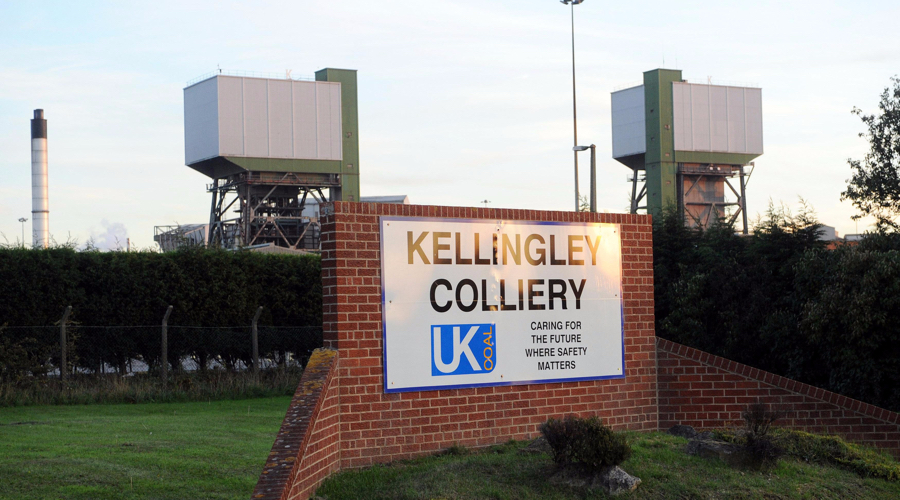
- Kellingley Colliery, once considered one of the most successful coal mines in the UK, was shut down in 2015. (Image from ITV News | Creative Commons.) -
http://www.theguardian.com/business/2018/jan/21/lloyds-of-lo…
"Lloyd's of London to divest from coal, over climate change; Firm follows other big UK and European insurers by excluding coal companies from 1 April; Lloyd’s of London, the world’s oldest insurance market, has become the latest financial firm to announce that it plans to stop investing in coal companies. Lloyd’s will start to exclude coal from its investment strategy from 1 April. The definition of what is a coal company and the criteria for divestment will be set over the coming months.
Lloyd’s of London, the world’s oldest insurance market, has become the latest financial firm to announce that it plans to stop investing in coal companies.
Lloyd’s will start to exclude coal from its investment strategy from 1 April. The definition of what is a coal company and the criteria for divestment will be set over the coming months.
The firm has long been vocal about the need to battle climate change, with insurance one of the worst affected industries by hurricanes, wildfires and flooding in recent years.
The insurance market decided last month to implement a coal exclusion policy as part of a responsible investment strategy for the central mutual fund that sits behind every insurance policy written by the Lloyd’s market.
Beyond Davos – in avalanche country – lies an inescapable fragility
Larry Elliott
Larry Elliott
Read more
Inga Beale, Lloyd’s of London chief executive, said: “That means that in the areas of our portfolio where we can directly influence investment decisions we will avoid investing in companies that are involved mainly in coal.
“Is there more the insurance sector could be doing to help the world transition to a low-carbon economy by choosing sustainable or low-carbon stocks?”
Lloyd’s does not underwrite operations directly, but offers a marketplace to almost 90 syndicates of other insurers.
Lloyd’s has been slower to take action than others. Other big UK and European insurance companies, including Aviva, Allianz, Axa, Legal & General, SCOR, Swiss Re and Zurich, have been shifting away from coal and other fossil fuels due to concerns about climate risks. About £15bn has been divested by insurers in the past two years, according to a recent report from Unfriend Coal Network, a global coalition of NGOs and campaigners including 350.org and Greenpeace. It said 15 companies – almost all in Europe – have fully or partially cut financial ties by selling holdings in coal companies and refusing to insure their operations.
France’s Axa was one of the first financial firms to reduce investments in coal in May 2015 and is still leading the way. It said last month it was ditching investments and ending insurance for controversial US oil pipelines. After being criticised by campaigners for applying a threshold of 50% of revenues to define coal companies, it lowered the threshold to 30%.
Lloyd’s of London starts paying out $4.5bn of Harvey and Irma claims
Read more
The Church of England has gone further, pulling out of investing in companies that make more than 10% of their revenues from thermal coal or oil from tar sands.
Analysis by the ClimateWise coalition of the world’s biggest insurers published in December 2016 found that more frequent extreme weather events were driving up uninsured losses and making some assets uninsurable. The report concluded that the “protection gap” – the difference between the costs of natural disasters and the amount insured – had quadrupled to $100bn (£79bn) a year since the 1980s.
Advertisement
Insurance companies are perhaps also mindful of the danger that they could suffer a huge loss if their investments in fossil fuel companies were rendered worthless by action on climate change, as the Bank of England warned in 2015. However, some banks are still investing in coal plants, according to research from campaign groups.
Beale told the Guardian that she would be discussing the group’s new investment strategy at the World Economic Forum’s annual meeting in Davos this week.
Climate change and what investors can do will feature prominently at the meeting of political and business leaders. Beale said: “It goes beyond climate change. The broader issue is how we clean up the planet.”
Investment companies and organisations divesting from coal
Allianz
Axa
Aviva
BMO Global Asset Management
Church of England
Generali
Legal & General
Munich Re
Natixis
SCOR
Storebrand
Swiss Re
Zurich
Follow Guardian Business on Twitter at @BusinessDesk, or sign up to the daily Business Today email here."

- Kellingley Colliery, once considered one of the most successful coal mines in the UK, was shut down in 2015. (Image from ITV News | Creative Commons.) -
http://www.theguardian.com/business/2018/jan/21/lloyds-of-lo…
"Lloyd's of London to divest from coal, over climate change; Firm follows other big UK and European insurers by excluding coal companies from 1 April; Lloyd’s of London, the world’s oldest insurance market, has become the latest financial firm to announce that it plans to stop investing in coal companies. Lloyd’s will start to exclude coal from its investment strategy from 1 April. The definition of what is a coal company and the criteria for divestment will be set over the coming months.
Lloyd’s of London, the world’s oldest insurance market, has become the latest financial firm to announce that it plans to stop investing in coal companies.
Lloyd’s will start to exclude coal from its investment strategy from 1 April. The definition of what is a coal company and the criteria for divestment will be set over the coming months.
The firm has long been vocal about the need to battle climate change, with insurance one of the worst affected industries by hurricanes, wildfires and flooding in recent years.
The insurance market decided last month to implement a coal exclusion policy as part of a responsible investment strategy for the central mutual fund that sits behind every insurance policy written by the Lloyd’s market.
Beyond Davos – in avalanche country – lies an inescapable fragility
Larry Elliott
Larry Elliott
Read more
Inga Beale, Lloyd’s of London chief executive, said: “That means that in the areas of our portfolio where we can directly influence investment decisions we will avoid investing in companies that are involved mainly in coal.
“Is there more the insurance sector could be doing to help the world transition to a low-carbon economy by choosing sustainable or low-carbon stocks?”
Lloyd’s does not underwrite operations directly, but offers a marketplace to almost 90 syndicates of other insurers.
Lloyd’s has been slower to take action than others. Other big UK and European insurance companies, including Aviva, Allianz, Axa, Legal & General, SCOR, Swiss Re and Zurich, have been shifting away from coal and other fossil fuels due to concerns about climate risks. About £15bn has been divested by insurers in the past two years, according to a recent report from Unfriend Coal Network, a global coalition of NGOs and campaigners including 350.org and Greenpeace. It said 15 companies – almost all in Europe – have fully or partially cut financial ties by selling holdings in coal companies and refusing to insure their operations.
France’s Axa was one of the first financial firms to reduce investments in coal in May 2015 and is still leading the way. It said last month it was ditching investments and ending insurance for controversial US oil pipelines. After being criticised by campaigners for applying a threshold of 50% of revenues to define coal companies, it lowered the threshold to 30%.
Lloyd’s of London starts paying out $4.5bn of Harvey and Irma claims
Read more
The Church of England has gone further, pulling out of investing in companies that make more than 10% of their revenues from thermal coal or oil from tar sands.
Analysis by the ClimateWise coalition of the world’s biggest insurers published in December 2016 found that more frequent extreme weather events were driving up uninsured losses and making some assets uninsurable. The report concluded that the “protection gap” – the difference between the costs of natural disasters and the amount insured – had quadrupled to $100bn (£79bn) a year since the 1980s.
Advertisement
Insurance companies are perhaps also mindful of the danger that they could suffer a huge loss if their investments in fossil fuel companies were rendered worthless by action on climate change, as the Bank of England warned in 2015. However, some banks are still investing in coal plants, according to research from campaign groups.
Beale told the Guardian that she would be discussing the group’s new investment strategy at the World Economic Forum’s annual meeting in Davos this week.
Climate change and what investors can do will feature prominently at the meeting of political and business leaders. Beale said: “It goes beyond climate change. The broader issue is how we clean up the planet.”
Investment companies and organisations divesting from coal
Allianz
Axa
Aviva
BMO Global Asset Management
Church of England
Generali
Legal & General
Munich Re
Natixis
SCOR
Storebrand
Swiss Re
Zurich
Follow Guardian Business on Twitter at @BusinessDesk, or sign up to the daily Business Today email here."
Antwort auf Beitrag Nr.: 56.724.792 von Popeye82 am 16.01.18 01:57:09
https://pdfs.semanticscholar.org/3616/dd9db704d285b027c13185…
https://pdfs.semanticscholar.org/3616/dd9db704d285b027c13185…
Antwort auf Beitrag Nr.: 56.602.592 von Popeye82 am 03.01.18 17:11:51
http://www.mining.com/zinc-price-will-vault-4000-within-mont…

http://www.mining.com/zinc-price-will-vault-4000-within-mont…
dieses Projekt habe ich sehr, sehr lange verfolgt.
Interesse Jetzt WIEDERerwacht.
brauche noch mehr Informationen.
mal sehen.


http://manhattancorp.com.au/upload/documents/investor/asx/20…
Interesse Jetzt WIEDERerwacht.
brauche noch mehr Informationen.
mal sehen.
http://manhattancorp.com.au/upload/documents/investor/asx/20…
Antwort auf Beitrag Nr.: 56.760.720 von Popeye82 am 18.01.18 20:28:03Daniel Malchuk, quote: Copper "is sooooooo cool, I take in in bed with. EVERY night"
http://www.bhp.com/media-and-insights/reports-and-presentati…
"Copper’s time has come
02 November 2017, 12:00 AM
Daniel Malchuk, President Operations, Minerals Americas
LME Week Bloomberg Forum, London, 1 November 2017.
Check against delivery
Thank you to Bloomberg for the opportunity to share our views on copper, it’s a pleasure to be here at LME week in London.
As a Dual Listed Company, London is one of our homes and a very important base for our European investors.
I personally have a strong affiliation with copper – my beginnings with BHP were in copper in the United States and since then I’ve gained over two decades of experience across different commodities around the world.
Even now (in my capacity as President Operations, Minerals Americas) I am responsible for many non-copper assets, I’ll have to admit that copper still has a special place in my heart!
Let me start by stating that Copper fits our strategy
For many years, we have been clear about our positive outlook for copper, and have worked extremely hard to make sure our assets are well placed to deliver copper to the world.
At BHP we think in decades and generations. Our ability to plan, work and invest for the long term is our advantage.
We choose commodities that will deliver returns through the cycle.
As you know, the theme of this forum is “East meets West” which is very appropriate for my discussion today, given that Asia is expected to remain the powerhouse of growth to fuel commodities demand such as copper for decades to come.
So, today I will focus on two things:
Why we like copper and the outlook for supply and demand; and secondly
How we will create value with our quality assets, through exploration and the application of technology.
So let me start, or rather remind you, of the market fundamentals.
Our historic positive outlook on copper – and I believe many of you will agree with me – is underpinned by strong demand drivers because of its relevance to each step of the development cycle, combined with characteristic ore quality depletion from the supply standpoint.
The world needs resources to grow – it needs them to help build new cities and provide cleaner – and ideally renewable – energy that can power whole communities.
I am telling you nothing new so far, these conditions have been well understood for a while. However, in the last few years we have seen the strong emergence of two drivers that have potential to lift this game even higher.
These are electric vehicles and renewable energy… and fortunately Copper is ideally placed to benefit from the expected upsurge in demand from both.
The rise of renewables is a positive story. Thanks to strong policy support and major technical improvements, wind and solar power generation have increased nearly 50-fold since 2000!
Solar’s share of global power generation has more than doubled in just three years – yet still accounts for a small slice of the total energy mix.
Even so, this presents a great opportunity.
Solar requires about five kilograms of copper per kilowatt – that’s more than double the copper intensity than alternative forms of generation.
And with the use of solar expected to rise around the globe, this is an enormous amount of copper to source!
Now turning from the power grid to the highways…
A hybrid car uses 40 kilograms of copper – that’s twice the amount of copper a regular petrol car uses.
A pure battery-powered electric vehicle uses even more copper – about 80 kilograms or four times that of a petrol car!
And if you think you are seeing more and more hybrid and electric vehicles on the roads, you’d be right.
To capture this insight, I’d now like to share a short animation from our Prospects blog.
So as you have seen, the global electric vehicle fleet is expected to increase from one million vehicles today to about 140 million by 2035!
We believe electric vehicles could require even more copper as they evolve – up to 105 kilograms per car.
That would see copper demand for electric vehicle fleets grow to an estimated 12 million tonnes, or more than half of the current global market for refined copper.
Sure, demand for other metals will also increase as a result of this trend, such as lithium, cobalt, nickel etc. However it is the relative magnitude which makes copper our key area of focus.
Based on total refined copper output, the value of the copper market could increase by over 50 per cent by 2035 – an opportunity worth seizing!
Now you see why copper is firmly on our radar.
But, as good as this market looks there are some hurdles we need to clear first that would set us up for the future.
Supply constraints – meeting the challenges of the copper industry
The challenges such as supply constraints we face are significant. These range from declining grades, deeper deposits, harder ore, labour productivity and water scarcity, to higher expectations from host governments and communities.
Grade decline alone has huge ramifications. Industry grades are expected to decline by 17 per cent according to Wood Mackenzie data over the next decade. Ageing mines require more effort and cost to deliver the same production.
Securing reliable power and water supply to support operations requires a proactive approach.
The over‐reliance on groundwater sources is a major issue for the industry, particularly in Chile. There will be a growing need for desalinated water to process the higher volumes of lower‐grade ore.
And BHP is not standing still.
We are applying advanced manufacturing practices such as automation, remote operations and a keen focus on improving our planning and execution of maintenance.
We have the luxury of having a phenomenal resource endowment, a portfolio of high quality, and long-life copper assets, such as Escondida, Spence, Olympic Dam, Antamina and the option at Resolution.
We have worked hard over the past decade to invest at the right time and our existing copper portfolio is now well positioned to benefit from what we believe is a brilliant future.
Exploration – bringing the future forward
In spite of our attractive resource base, we want more copper resources in our portfolio. And we believe the most valuable pathway to achieving this is through exploration, the drill-bit!
Exploration has the highest potential to deliver future returns and that is why it is a key part of our copper strategy… but we also recognise that given our high standards it is not an easy task.
Copper exploration these days is as a trade-off between depth and maturity.
The mature, well established and explored regions such as Chile are clearly less likely to host a big discovery close to the surface, with new deposits more likely to be at depth… and therefore more difficult to identify!
On the flipside, as we venture into less mature regions, such as Ecuador, where exploration activity levels have historically been lower, the potential for new discoveries closer to the surface is greater.
BHP is positioning as a global exploration leader. This is not about having the largest budget. It is about allocating the funds wisely through a highly focused and technical approach.
We have both the advantages of geoscience expertise and industry diversification. So what does this mean?
Our Copper Exploration team is leveraging our in-house petroleum exploration expertise with a specialised approach to exploration and deposit modelling.
What we call the ‘Mineral System’ allows us to identify without pre-conceived biases the best geological environments capable of hosting Tier 1 copper deposits.
Knowledge-sharing between our teams at BHP is important, but another valuable part of our exploration strategy is our academic ties.
Our partnerships with the likes of Bristol University, and the Universities of Wollongong and Western Australia, has helped us tackle the geoscience issues our explorers face. We are developing tools that measure the fertility of terrains.
We have leveraged data analytics and developed complex algorithms to be applied using Machine Learning techniques. BHP holds over 100 years of exploration data which provides a competitive advantage for building these algorithms, which have the potential to identify areas capable of developing Tier 1 deposits – This is an exciting prospect!
Our exploration techniques give us an early mover advantage, and inform us whether to continue or exit. This ensures we are sustaining a high-quality portfolio.
Our current exploration strategy targets porphyry, skarn and sedimentary hosted copper deposits globally, with a focus in the Americas, and IOCG mineralisation in South Australia. These settings host the most important Copper deposits ever found.
At the end of financial year 2017, our copper exploration portfolio comprised 79 projects covering 1.8 million hectares.
We have made, and continue to be open to, exploration alliances with junior explorers – their expertise and flexibility allow us to advance projects along the exploration pipeline. We are open to new ideas and opportunities, feel free to bring these to us!
We are aware that greenfield exploration is challenging and high-quality mineral deposits are increasingly scarce and difficult to find.
To be successful in Exploration, it requires perseverance and a stable and sustained investment through the commodity price cycle.
The rewards though – if we get it right – will be great.
Conclusion – Think big, think copper
Now to wrap everything up ….
We believe there is a great future ahead of us, full of opportunities as BHP becomes more active in adopting new technologies over the whole value chain. From exploration to marketing!
We can only grasp that future if we think big. And it is copper that will lead the way!
Copper has had great fundamentals for some time, and great potential due to the rapid rise in renewables and electric vehicles.
We are well placed to support increased copper supply into the global market, given our resource endowment.
Our existing copper assets are world-class. We have a smart exploration program and a sustainable approach that will see us be a key player in this market at a global level for years to come.
In a world that is changing, in a world that is increasingly technological, and in a world that is powered by copper – we think copper – we think big."
http://www.bhp.com/media-and-insights/reports-and-presentati…
"Copper’s time has come
02 November 2017, 12:00 AM
Daniel Malchuk, President Operations, Minerals Americas
LME Week Bloomberg Forum, London, 1 November 2017.
Check against delivery
Thank you to Bloomberg for the opportunity to share our views on copper, it’s a pleasure to be here at LME week in London.
As a Dual Listed Company, London is one of our homes and a very important base for our European investors.
I personally have a strong affiliation with copper – my beginnings with BHP were in copper in the United States and since then I’ve gained over two decades of experience across different commodities around the world.
Even now (in my capacity as President Operations, Minerals Americas) I am responsible for many non-copper assets, I’ll have to admit that copper still has a special place in my heart!
Let me start by stating that Copper fits our strategy
For many years, we have been clear about our positive outlook for copper, and have worked extremely hard to make sure our assets are well placed to deliver copper to the world.
At BHP we think in decades and generations. Our ability to plan, work and invest for the long term is our advantage.
We choose commodities that will deliver returns through the cycle.
As you know, the theme of this forum is “East meets West” which is very appropriate for my discussion today, given that Asia is expected to remain the powerhouse of growth to fuel commodities demand such as copper for decades to come.
So, today I will focus on two things:
Why we like copper and the outlook for supply and demand; and secondly
How we will create value with our quality assets, through exploration and the application of technology.
So let me start, or rather remind you, of the market fundamentals.
Our historic positive outlook on copper – and I believe many of you will agree with me – is underpinned by strong demand drivers because of its relevance to each step of the development cycle, combined with characteristic ore quality depletion from the supply standpoint.
The world needs resources to grow – it needs them to help build new cities and provide cleaner – and ideally renewable – energy that can power whole communities.
I am telling you nothing new so far, these conditions have been well understood for a while. However, in the last few years we have seen the strong emergence of two drivers that have potential to lift this game even higher.
These are electric vehicles and renewable energy… and fortunately Copper is ideally placed to benefit from the expected upsurge in demand from both.
The rise of renewables is a positive story. Thanks to strong policy support and major technical improvements, wind and solar power generation have increased nearly 50-fold since 2000!
Solar’s share of global power generation has more than doubled in just three years – yet still accounts for a small slice of the total energy mix.
Even so, this presents a great opportunity.
Solar requires about five kilograms of copper per kilowatt – that’s more than double the copper intensity than alternative forms of generation.
And with the use of solar expected to rise around the globe, this is an enormous amount of copper to source!
Now turning from the power grid to the highways…
A hybrid car uses 40 kilograms of copper – that’s twice the amount of copper a regular petrol car uses.
A pure battery-powered electric vehicle uses even more copper – about 80 kilograms or four times that of a petrol car!
And if you think you are seeing more and more hybrid and electric vehicles on the roads, you’d be right.
To capture this insight, I’d now like to share a short animation from our Prospects blog.
So as you have seen, the global electric vehicle fleet is expected to increase from one million vehicles today to about 140 million by 2035!
We believe electric vehicles could require even more copper as they evolve – up to 105 kilograms per car.
That would see copper demand for electric vehicle fleets grow to an estimated 12 million tonnes, or more than half of the current global market for refined copper.
Sure, demand for other metals will also increase as a result of this trend, such as lithium, cobalt, nickel etc. However it is the relative magnitude which makes copper our key area of focus.
Based on total refined copper output, the value of the copper market could increase by over 50 per cent by 2035 – an opportunity worth seizing!
Now you see why copper is firmly on our radar.
But, as good as this market looks there are some hurdles we need to clear first that would set us up for the future.
Supply constraints – meeting the challenges of the copper industry
The challenges such as supply constraints we face are significant. These range from declining grades, deeper deposits, harder ore, labour productivity and water scarcity, to higher expectations from host governments and communities.
Grade decline alone has huge ramifications. Industry grades are expected to decline by 17 per cent according to Wood Mackenzie data over the next decade. Ageing mines require more effort and cost to deliver the same production.
Securing reliable power and water supply to support operations requires a proactive approach.
The over‐reliance on groundwater sources is a major issue for the industry, particularly in Chile. There will be a growing need for desalinated water to process the higher volumes of lower‐grade ore.
And BHP is not standing still.
We are applying advanced manufacturing practices such as automation, remote operations and a keen focus on improving our planning and execution of maintenance.
We have the luxury of having a phenomenal resource endowment, a portfolio of high quality, and long-life copper assets, such as Escondida, Spence, Olympic Dam, Antamina and the option at Resolution.
We have worked hard over the past decade to invest at the right time and our existing copper portfolio is now well positioned to benefit from what we believe is a brilliant future.
Exploration – bringing the future forward
In spite of our attractive resource base, we want more copper resources in our portfolio. And we believe the most valuable pathway to achieving this is through exploration, the drill-bit!
Exploration has the highest potential to deliver future returns and that is why it is a key part of our copper strategy… but we also recognise that given our high standards it is not an easy task.
Copper exploration these days is as a trade-off between depth and maturity.
The mature, well established and explored regions such as Chile are clearly less likely to host a big discovery close to the surface, with new deposits more likely to be at depth… and therefore more difficult to identify!
On the flipside, as we venture into less mature regions, such as Ecuador, where exploration activity levels have historically been lower, the potential for new discoveries closer to the surface is greater.
BHP is positioning as a global exploration leader. This is not about having the largest budget. It is about allocating the funds wisely through a highly focused and technical approach.
We have both the advantages of geoscience expertise and industry diversification. So what does this mean?
Our Copper Exploration team is leveraging our in-house petroleum exploration expertise with a specialised approach to exploration and deposit modelling.
What we call the ‘Mineral System’ allows us to identify without pre-conceived biases the best geological environments capable of hosting Tier 1 copper deposits.
Knowledge-sharing between our teams at BHP is important, but another valuable part of our exploration strategy is our academic ties.
Our partnerships with the likes of Bristol University, and the Universities of Wollongong and Western Australia, has helped us tackle the geoscience issues our explorers face. We are developing tools that measure the fertility of terrains.
We have leveraged data analytics and developed complex algorithms to be applied using Machine Learning techniques. BHP holds over 100 years of exploration data which provides a competitive advantage for building these algorithms, which have the potential to identify areas capable of developing Tier 1 deposits – This is an exciting prospect!
Our exploration techniques give us an early mover advantage, and inform us whether to continue or exit. This ensures we are sustaining a high-quality portfolio.
Our current exploration strategy targets porphyry, skarn and sedimentary hosted copper deposits globally, with a focus in the Americas, and IOCG mineralisation in South Australia. These settings host the most important Copper deposits ever found.
At the end of financial year 2017, our copper exploration portfolio comprised 79 projects covering 1.8 million hectares.
We have made, and continue to be open to, exploration alliances with junior explorers – their expertise and flexibility allow us to advance projects along the exploration pipeline. We are open to new ideas and opportunities, feel free to bring these to us!
We are aware that greenfield exploration is challenging and high-quality mineral deposits are increasingly scarce and difficult to find.
To be successful in Exploration, it requires perseverance and a stable and sustained investment through the commodity price cycle.
The rewards though – if we get it right – will be great.
Conclusion – Think big, think copper
Now to wrap everything up ….
We believe there is a great future ahead of us, full of opportunities as BHP becomes more active in adopting new technologies over the whole value chain. From exploration to marketing!
We can only grasp that future if we think big. And it is copper that will lead the way!
Copper has had great fundamentals for some time, and great potential due to the rapid rise in renewables and electric vehicles.
We are well placed to support increased copper supply into the global market, given our resource endowment.
Our existing copper assets are world-class. We have a smart exploration program and a sustainable approach that will see us be a key player in this market at a global level for years to come.
In a world that is changing, in a world that is increasingly technological, and in a world that is powered by copper – we think copper – we think big."
Antwort auf Beitrag Nr.: 56.833.804 von Popeye82 am 26.01.18 06:23:25
http://www.australianmining.com.au/news/glencore-restart-lad…

http://www.australianmining.com.au/news/glencore-restart-lad…
Antwort auf Beitrag Nr.: 56.786.929 von Popeye82 am 22.01.18 11:01:01
https://qz.com/1189272/moodys-report-on-coal-mining-only-car…
http://www.moodys.com/research/Moodys-US-coal-production-wil…
https://qz.com/1189272/moodys-report-on-coal-mining-only-car…
http://www.moodys.com/research/Moodys-US-coal-production-wil…
2018 Year of EPIC Market Disruptions???????
Antwort auf Beitrag Nr.: 56.538.692 von Popeye82 am 23.12.17 23:06:05http://resourcestockdigest.com/archives/index.php?content_id…
https://hannanmetals.com/news/2018/hannan-defines-seven-new-…
https://hannanmetals.com/news/2018/hannan-completes-a-41-lin…
https://hannanmetals.com/news/2018/hannan-defines-seven-new-…
https://hannanmetals.com/news/2018/hannan-completes-a-41-lin…
https://stockhead.com.au/resources/iron-ore-stocks-strike-ch…
" Iron ore juniors escape ASX maelstrom as price rallies
Resources
February 5, 2018 | Angela East
Investors were more bullish on iron ore players on Monday following a strengthening in the price of the steel-making commodity.
A handful of ASX-listed junior iron ore explorers managed to escape the downward pull of the market on Monday amid a 1.6 per cent fall in the ASX200 index. (Though the stocks faced another tough day on Tuesday after the Dow Jones lost 4.6 per cent overnight).
Centrex Metals (ASX:CXM) led the pack with an 8.3 per cent gain to close the day at 1.2c.
GWR Group (ASX:GWR), Freehill Mining (ASX:FHS) and Iron Road (ASX:IRD) all made gains of more than 5 per cent.
Iron ore stocks have been on the nose for investors for the past few years, ever since late 2015, when the price bombed below $US40 per tonne and companies were forced to mothball production.
The price recovered to around US$95 per tonne in February last year, but has lost some ground since then.
However, whispers that China is planning to extend its production cuts have spurred Chinese investor buying in derivatives, which has prompted a rally in the spot market price.
CXM shares closed up at 1.2c on Monday.
CXM shares closed up at 1.2c on Monday.
The price for benchmark 62 per cent fines (fine iron ore products smaller than 6mm in size) has climbed back up to $US74.39, marking a 2.1 per cent gain and its highest level since January 26, according to the Metal Bulletin.
The Chinese market is very sentiment driven, S&P Global Patts senior managing editor Paul Bartholomew told Stockhead.
“Particularly Shanghai rebar and the Dalian iron ore futures is very sentiment driven, not always related to fundamentals,” he said.
“The physical market does take its lead a lot from futures markets. The thing about futures markets is you’ve got a lot more Chinese retail investors, mum and dad investors, sort of piling into commodities derivatives and getting out of the share market.”
Bookmark this link for small cap breaking news
Discuss small cap news in our Facebook group
Follow us on Facebook or Twitter
Subscribe to our daily newsletter
The share market and housing market in China have been quite volatile of late, according to Mr Bartholomew.
“They don’t quite know where that’s going to go so a lot of hot money has been going into derivatives and that’s probably a trend we’ve been seeing for the last couple of years,” he said.
China has been cracking down on its polluting industries, in particular steel mills using lower quality iron ore to make steel. The production cuts were due to come to an end on March 15.
“The market is a lot more reactive to Chinese policy and also rumours of Chinese policy. There’s been rumours that China might keep the production cuts extended a bit longer, but at the same time some of the production cuts haven’t been as significant as expected for various reasons.”
Steel demand in 2018, however, is expected to be a lot softer, with analysts predicting an average iron ore price of US$65 per tonne, compared to US$71.30 per tonne in 2017.
The iron ore market will be a lot quieter from next week with Chinese New year celebrations reducing demand for at least the next two weeks.
“At the moment there’s not very much buying interest for seaborne iron ore because Chinese mills and traders have already stocked up and they’ve got enough iron ore inventory to last them until the end of the lunar new year holiday period,” Mr Bartholomew said."
" Iron ore juniors escape ASX maelstrom as price rallies
Resources
February 5, 2018 | Angela East
Investors were more bullish on iron ore players on Monday following a strengthening in the price of the steel-making commodity.
A handful of ASX-listed junior iron ore explorers managed to escape the downward pull of the market on Monday amid a 1.6 per cent fall in the ASX200 index. (Though the stocks faced another tough day on Tuesday after the Dow Jones lost 4.6 per cent overnight).
Centrex Metals (ASX:CXM) led the pack with an 8.3 per cent gain to close the day at 1.2c.
GWR Group (ASX:GWR), Freehill Mining (ASX:FHS) and Iron Road (ASX:IRD) all made gains of more than 5 per cent.
Iron ore stocks have been on the nose for investors for the past few years, ever since late 2015, when the price bombed below $US40 per tonne and companies were forced to mothball production.
The price recovered to around US$95 per tonne in February last year, but has lost some ground since then.
However, whispers that China is planning to extend its production cuts have spurred Chinese investor buying in derivatives, which has prompted a rally in the spot market price.
CXM shares closed up at 1.2c on Monday.
CXM shares closed up at 1.2c on Monday.
The price for benchmark 62 per cent fines (fine iron ore products smaller than 6mm in size) has climbed back up to $US74.39, marking a 2.1 per cent gain and its highest level since January 26, according to the Metal Bulletin.
The Chinese market is very sentiment driven, S&P Global Patts senior managing editor Paul Bartholomew told Stockhead.
“Particularly Shanghai rebar and the Dalian iron ore futures is very sentiment driven, not always related to fundamentals,” he said.
“The physical market does take its lead a lot from futures markets. The thing about futures markets is you’ve got a lot more Chinese retail investors, mum and dad investors, sort of piling into commodities derivatives and getting out of the share market.”
Bookmark this link for small cap breaking news
Discuss small cap news in our Facebook group
Follow us on Facebook or Twitter
Subscribe to our daily newsletter
The share market and housing market in China have been quite volatile of late, according to Mr Bartholomew.
“They don’t quite know where that’s going to go so a lot of hot money has been going into derivatives and that’s probably a trend we’ve been seeing for the last couple of years,” he said.
China has been cracking down on its polluting industries, in particular steel mills using lower quality iron ore to make steel. The production cuts were due to come to an end on March 15.
“The market is a lot more reactive to Chinese policy and also rumours of Chinese policy. There’s been rumours that China might keep the production cuts extended a bit longer, but at the same time some of the production cuts haven’t been as significant as expected for various reasons.”
Steel demand in 2018, however, is expected to be a lot softer, with analysts predicting an average iron ore price of US$65 per tonne, compared to US$71.30 per tonne in 2017.
The iron ore market will be a lot quieter from next week with Chinese New year celebrations reducing demand for at least the next two weeks.
“At the moment there’s not very much buying interest for seaborne iron ore because Chinese mills and traders have already stocked up and they’ve got enough iron ore inventory to last them until the end of the lunar new year holiday period,” Mr Bartholomew said."
Antwort auf Beitrag Nr.: 56.944.757 von Popeye82 am 06.02.18 09:24:04
http://www.scbeic.com/en/detail/product/1174
"What does potash mining mean for Thailand?
19 February 2015
Author: Lertpong Larpchevasit
Potash.jpg
Potash is a mineral mainly used as an ingredient in the production of potassium fertilizers. As one of the three major plant and crop nutrients, potassium increases crop quality and protects plants against diseases and insects. With the world's growing population, demand for potash continues to rise following higher demand for agricultural produce. Canada is the world's major potash exporter, while Asian countries are the world's main importers, with Thailand ranked 5th in Asia.
The development of potash mining in Thailand could curb imports and thus reduce production costs for the agricultural and manufacturing industries. Thailand's high potential in potash mining stems from abundant high-quality potash deposits and strong agricultural and food industries. However, environmental and social impacts resulting from potash mining must be kept in mind. To ensure the sustainable development of the potash mining industry, the public should be well informed about the costs and benefits. Expert consultation and a choice of optimal technology will minimize any negative impacts from potash mining.
Potash is a family of industrial ores with high potassium content. It is commonly found with rock salt and used as the primary ingredient in the production of fertilizers. More than 90% of potash produced globally is used as raw material for potassium fertilizers. Potassium is one of the three main ingredients, along with nitrogen and phosphorus, used in the production of chemical fertilizers. Potassium fertilizers help increase production yields and protect plants against disease. Though not as prevalent, potash is also used as a raw material for some chemical products such as glass, soap, and ceramics. Due to potash's high salt content, a salt extraction process is required before potash can be used in fertilizer production. The salt extracted from potash can be used for cooking and road de-icing.
Canada is currently the largest potash exporter, while Asia is the main importer. At present, the production capacity of Canada, the number one producer, accounts for 30% of total world production. Russia and Belarus are the second and third largest producers. Moreover, Canada has a potash export value of 40%, the world's largest. The main export destinations of Canada are the U.S. and Asia, whose potash imports account for more than 50% and 30% of Canada's total potash exports, respectively. Asia is without a doubt the largest import market for potash; Asia's potash imports account for more than 40% of the world's total potash exports. Thailand is the 5th largest importer within Asia. The high demand for potash in Asia is rooted in a significant percentage of the workforce employed in the agricultural sector as well as the region's strong population growth. Despite the large and growing demand, China is the only large potash producer, even though many Asian countries such as Vietnam, Laos, and Thailand are themselves endowed with ample potash resources. Currently, China has a production capacity of 4.4 million tons, but the country is able to export only around 0.1 million tons, relatively small compared to Asia's potash demand of approximately 15 million tons.
What about the potash mining industry in Thailand?
Thailand currently imports potash to produce fertilizers. While Thailand has abundant potash deposits, these resources have remained untapped due to strong public resistance.Thailand currently imports 0.7 million tons of potash every year for the production of potassium fertilizers, valued at around 10 billion baht. Imports are mainly from Canada, Belarus, and Germany. Additionally, Thailand also imports 5 million tons of chemical fertilizers that contain nitrogen and phosphorus in addition to potassium. The reliance on imports for both potash and chemical fertilizers has increased production costs in the agricultural sector. Developing a potash mining industry could help reduce the import burden. In fact, the 400 billion tons of potash deposits in Thailand are among the world's largest. Potash deposits are usually found in the Northeast provinces such as Chaiyaphum, Udon Thani, Khon Kaen, Sakon Nakhon, and Nakhon Ratchasima. Moreover, these deposits are of high quality. For instance, the sylvite potash commonly found in Udon Thani is one of the best types for manufacturing potassium fertilizers. In addition, potash in Thailand can be found only 150-300 meters under the ground surface, making the mining cost much lower than many places in the world where potash mines are more than 1,000 meters underground. Despite its high potential, potash mining in Thailand is largely halted by strong public resistance.
The negative environmental and social impacts of mining are the main reason for strong resistance to potash mining sites near residential areas and communities. Impacts on the environment are the key issues demanding the attention and concern of all parties. The salt extracting processes in producing potassium fertilizers pose risks of increasing water and soil salinity as potash deposits with potential economic benefits are located close to water sources and residential communities. This would largely affect households relying on natural water sources and agricultural land for daily activities. On top of that, underground potash extraction may cause land subsidence. There are also other health and social effects from potash mining. For example, direct contact with potash in large quantities may lead to skin irritation and bowel problems. The lifestyles of households in mining areas will change as community transforms from an agricultural society toward an industrial society. Additionally, natural water sources will have to be split between agricultural and mining purposes, as the potash-mining process requires large amounts of water.
That said, the development of a potash mining industry in Thailand could add economic and business benefits. The current import price of potash is around USD300 per ton, while the average cost of mining potash is around USD100-200 per ton. Though import prices are down from the pre-financial crisis level of USD900 per ton during 2008-2009, the price of potash is expected to rise in the long run. This increasing trend is due to rapidly growing global demand for agricultural products, rising populations, and the development of green economies. With its own potash mining, Thailand can expect to lower the cost of agricultural production and create spillover benefits for related industries. For instance, the fertilizer industry will benefit from a lower cost of raw materials to make cheaper potassium fertilizers and become a competitive and stable production center. The chemical products industry should benefit from the supply of potassium chloride and the salt extracted in potash mining for use in the production of soap, bleach, and ceramics. Moreover, the bio-fuel alternative energy industry can be developed more sustainably as the supply chain in the agricultural sector will be more integrated when Thailand is self-reliant on potash.
At the macro-economic level, potash mining in Thailand will reduce potash imports, which currently stand at around 10 billion baht. It will also attract trillions of both domestic and foreign investment to make use of Thailand's available potash deposits. In addition, there is a potential for exports of potash ores and chemical fertilizers should production become sufficiently large. Potash mining should also lead to more employment and higher incomes in local areas.
Implication.png
Implication.gif
The collaboration of the public, private, and civil society sectors in supporting, educating, and finding preventive measures as well as optimal technology to minimize the impact of potash mining will encourage the sustainable development of potash mining in Thailand. To ensure the sustainable development of domestic potash-mining businesses as a viable substitute for imports, the government should provide the public with detailed information on the costs and benefits of potash mining. The government should encourage the private sector to take on the obligation of managing environmental impacts on local populations and communities. The case of the potash mining industry in Canada can provide a good example. The province of Saskatchewan, albeit being the world's largest potash producer, has minimal pollution levels. This is a result of 10-step environmental impact assessment procedures that include the participation of the community in setting up rules on environmental impacts and technological evaluations of potash extraction technology.
In the future, chemical fertilizers will become ever more important for Thailand's agricultural industry in meeting the growing demand for agricultural products and processed agricultural products. A domestic potash supply for chemical fertilizer production will therefore boost Thailand's competitiveness. Potassium provides nutrients required to improve the quality of agricultural products and protect crops against diseases and insects. It is therefore necessary in the production of chemical fertilizers to be utilized along with organic fertilizers commonly used in the Thai agricultural sector. This will help increase crop yields to meet rapidly growing consumption due to the world's population growth. In addition, the lower costs of chemical fertilizers and the high potential of potash mining in Thailand should continue to lower prices of agricultural raw materials and costs incurred on the industrial sector. More importantly, Thailand's own potash mining development will unleash the country's potential through a better-integrated agricultural supply chain, which comprises an abundant upstream potash supply, a midstream chemical fertilizer industry, and downstream agricultural products with strong domestic and export demand. But in order to ensure sustainable potash mining development, the industry needs to take seriously its responsibility for providing recovery and preventive measures to safeguard any potential environmental and social impacts.
Figure 1 : As the world's largest potash producer, Canada provides 30% of global potash output.
Potash_EN_1.jpg
Source: EIC analysis based on data from USGS
Figure 2: Asia is the world's largest potash importer, with Thailand ranked fifth in the region.
Potash_EN_2.jpg
Source: EIC analysis based on data from Trademap
Thailand, Potash, Commodity
DOWNLOAD FILE
Note_Potash_EN_20150219 .PDF (0 K)"
http://www.scbeic.com/en/detail/product/1174
"What does potash mining mean for Thailand?
19 February 2015
Author: Lertpong Larpchevasit
Potash.jpg
Potash is a mineral mainly used as an ingredient in the production of potassium fertilizers. As one of the three major plant and crop nutrients, potassium increases crop quality and protects plants against diseases and insects. With the world's growing population, demand for potash continues to rise following higher demand for agricultural produce. Canada is the world's major potash exporter, while Asian countries are the world's main importers, with Thailand ranked 5th in Asia.
The development of potash mining in Thailand could curb imports and thus reduce production costs for the agricultural and manufacturing industries. Thailand's high potential in potash mining stems from abundant high-quality potash deposits and strong agricultural and food industries. However, environmental and social impacts resulting from potash mining must be kept in mind. To ensure the sustainable development of the potash mining industry, the public should be well informed about the costs and benefits. Expert consultation and a choice of optimal technology will minimize any negative impacts from potash mining.
Potash is a family of industrial ores with high potassium content. It is commonly found with rock salt and used as the primary ingredient in the production of fertilizers. More than 90% of potash produced globally is used as raw material for potassium fertilizers. Potassium is one of the three main ingredients, along with nitrogen and phosphorus, used in the production of chemical fertilizers. Potassium fertilizers help increase production yields and protect plants against disease. Though not as prevalent, potash is also used as a raw material for some chemical products such as glass, soap, and ceramics. Due to potash's high salt content, a salt extraction process is required before potash can be used in fertilizer production. The salt extracted from potash can be used for cooking and road de-icing.
Canada is currently the largest potash exporter, while Asia is the main importer. At present, the production capacity of Canada, the number one producer, accounts for 30% of total world production. Russia and Belarus are the second and third largest producers. Moreover, Canada has a potash export value of 40%, the world's largest. The main export destinations of Canada are the U.S. and Asia, whose potash imports account for more than 50% and 30% of Canada's total potash exports, respectively. Asia is without a doubt the largest import market for potash; Asia's potash imports account for more than 40% of the world's total potash exports. Thailand is the 5th largest importer within Asia. The high demand for potash in Asia is rooted in a significant percentage of the workforce employed in the agricultural sector as well as the region's strong population growth. Despite the large and growing demand, China is the only large potash producer, even though many Asian countries such as Vietnam, Laos, and Thailand are themselves endowed with ample potash resources. Currently, China has a production capacity of 4.4 million tons, but the country is able to export only around 0.1 million tons, relatively small compared to Asia's potash demand of approximately 15 million tons.
What about the potash mining industry in Thailand?
Thailand currently imports potash to produce fertilizers. While Thailand has abundant potash deposits, these resources have remained untapped due to strong public resistance.Thailand currently imports 0.7 million tons of potash every year for the production of potassium fertilizers, valued at around 10 billion baht. Imports are mainly from Canada, Belarus, and Germany. Additionally, Thailand also imports 5 million tons of chemical fertilizers that contain nitrogen and phosphorus in addition to potassium. The reliance on imports for both potash and chemical fertilizers has increased production costs in the agricultural sector. Developing a potash mining industry could help reduce the import burden. In fact, the 400 billion tons of potash deposits in Thailand are among the world's largest. Potash deposits are usually found in the Northeast provinces such as Chaiyaphum, Udon Thani, Khon Kaen, Sakon Nakhon, and Nakhon Ratchasima. Moreover, these deposits are of high quality. For instance, the sylvite potash commonly found in Udon Thani is one of the best types for manufacturing potassium fertilizers. In addition, potash in Thailand can be found only 150-300 meters under the ground surface, making the mining cost much lower than many places in the world where potash mines are more than 1,000 meters underground. Despite its high potential, potash mining in Thailand is largely halted by strong public resistance.
The negative environmental and social impacts of mining are the main reason for strong resistance to potash mining sites near residential areas and communities. Impacts on the environment are the key issues demanding the attention and concern of all parties. The salt extracting processes in producing potassium fertilizers pose risks of increasing water and soil salinity as potash deposits with potential economic benefits are located close to water sources and residential communities. This would largely affect households relying on natural water sources and agricultural land for daily activities. On top of that, underground potash extraction may cause land subsidence. There are also other health and social effects from potash mining. For example, direct contact with potash in large quantities may lead to skin irritation and bowel problems. The lifestyles of households in mining areas will change as community transforms from an agricultural society toward an industrial society. Additionally, natural water sources will have to be split between agricultural and mining purposes, as the potash-mining process requires large amounts of water.
That said, the development of a potash mining industry in Thailand could add economic and business benefits. The current import price of potash is around USD300 per ton, while the average cost of mining potash is around USD100-200 per ton. Though import prices are down from the pre-financial crisis level of USD900 per ton during 2008-2009, the price of potash is expected to rise in the long run. This increasing trend is due to rapidly growing global demand for agricultural products, rising populations, and the development of green economies. With its own potash mining, Thailand can expect to lower the cost of agricultural production and create spillover benefits for related industries. For instance, the fertilizer industry will benefit from a lower cost of raw materials to make cheaper potassium fertilizers and become a competitive and stable production center. The chemical products industry should benefit from the supply of potassium chloride and the salt extracted in potash mining for use in the production of soap, bleach, and ceramics. Moreover, the bio-fuel alternative energy industry can be developed more sustainably as the supply chain in the agricultural sector will be more integrated when Thailand is self-reliant on potash.
At the macro-economic level, potash mining in Thailand will reduce potash imports, which currently stand at around 10 billion baht. It will also attract trillions of both domestic and foreign investment to make use of Thailand's available potash deposits. In addition, there is a potential for exports of potash ores and chemical fertilizers should production become sufficiently large. Potash mining should also lead to more employment and higher incomes in local areas.
Implication.png
Implication.gif
The collaboration of the public, private, and civil society sectors in supporting, educating, and finding preventive measures as well as optimal technology to minimize the impact of potash mining will encourage the sustainable development of potash mining in Thailand. To ensure the sustainable development of domestic potash-mining businesses as a viable substitute for imports, the government should provide the public with detailed information on the costs and benefits of potash mining. The government should encourage the private sector to take on the obligation of managing environmental impacts on local populations and communities. The case of the potash mining industry in Canada can provide a good example. The province of Saskatchewan, albeit being the world's largest potash producer, has minimal pollution levels. This is a result of 10-step environmental impact assessment procedures that include the participation of the community in setting up rules on environmental impacts and technological evaluations of potash extraction technology.
In the future, chemical fertilizers will become ever more important for Thailand's agricultural industry in meeting the growing demand for agricultural products and processed agricultural products. A domestic potash supply for chemical fertilizer production will therefore boost Thailand's competitiveness. Potassium provides nutrients required to improve the quality of agricultural products and protect crops against diseases and insects. It is therefore necessary in the production of chemical fertilizers to be utilized along with organic fertilizers commonly used in the Thai agricultural sector. This will help increase crop yields to meet rapidly growing consumption due to the world's population growth. In addition, the lower costs of chemical fertilizers and the high potential of potash mining in Thailand should continue to lower prices of agricultural raw materials and costs incurred on the industrial sector. More importantly, Thailand's own potash mining development will unleash the country's potential through a better-integrated agricultural supply chain, which comprises an abundant upstream potash supply, a midstream chemical fertilizer industry, and downstream agricultural products with strong domestic and export demand. But in order to ensure sustainable potash mining development, the industry needs to take seriously its responsibility for providing recovery and preventive measures to safeguard any potential environmental and social impacts.
Figure 1 : As the world's largest potash producer, Canada provides 30% of global potash output.
Potash_EN_1.jpg
Source: EIC analysis based on data from USGS
Figure 2: Asia is the world's largest potash importer, with Thailand ranked fifth in the region.
Potash_EN_2.jpg
Source: EIC analysis based on data from Trademap
Thailand, Potash, Commodity
DOWNLOAD FILE
Note_Potash_EN_20150219 .PDF (0 K)"
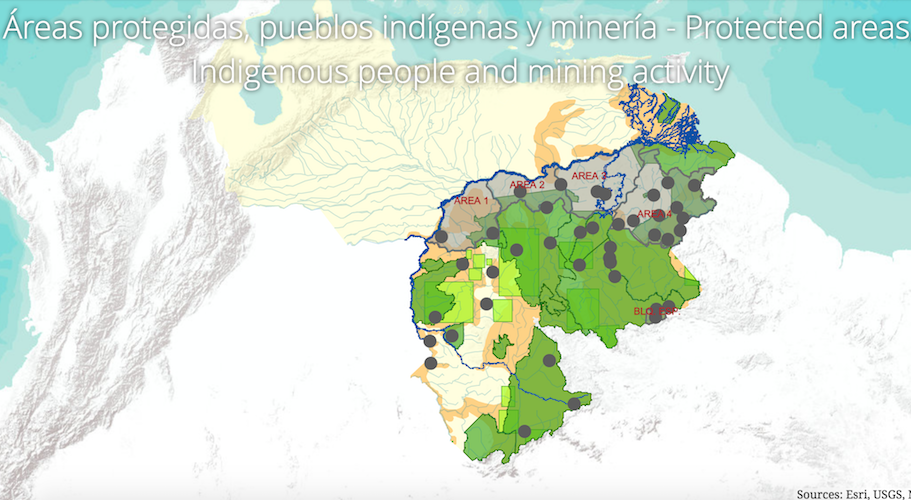
http://www.mining.com/venezuelan-government-defends-mining-a…
http://www.mining.com/ngos-want-venezuela-to-halt-mining-con…
http://www.mining.com/venezuelas-mining-arch-spotlight/
http://www.el-nacional.com/noticias/sociedad/los-estragos-de…
http://minci.gob.ve/2018/02/arco-minero-del-orinoco-avanza-m…
http://www.mining.com/following-detention-journalist-publish…
http://www.asambleanacional.gob.ve/actos/_informe-de-la-comi…
Antwort auf Beitrag Nr.: 57.143.604 von Popeye82 am 28.02.18 12:33:27Hugo Chavez
Come and invest in Mining in Venezuela. But if you do bring your own packed lunch. In our workers paradise we have EVERYthing, but food.
Come and invest in Mining in Venezuela. But if you do bring your own packed lunch. In our workers paradise we have EVERYthing, but food.
http://www.mining.com/web/ghana-tighten-controls-gold-export…
"Ghana to tighten controls on gold exports, to protect revenues
Reuters | about 3 hours ago | 157 | 0
ACCRA, Feb 27 (Reuters) – Ghana will certify the value of gold exports as part of efforts to tighten controls on the sector to ensure the state receives the revenues it is due, the vice president said on Tuesday.
Ghana, Africa's second largest gold miner after South Africa, earned $5.78 billion from exports of the metal last year, up 17.6 percent on 2016, central bank data showed.
Vice-President Mahamudu Bawumia told a regional meeting on the oil and mining sectors that Ghana's previous administration had allowed companies to assay gold produced from their mines themselves.
However, he said Ghanaian law required that the state-run Precious Minerals Marketing Company test and validate mineral production before export.
"We have now begun conversations about the process of making sure every single bar of gold leaving our shores is properly weighed, tested, valued and accounted for," Bawumia said.
The government was also considering passing legislation stating that at least 50 percent of Ghana's gold output would be refined locally within five years, he said.
Bawumia did not accuse any mining firms of wrongdoing and did not suggest past exports had been undervalued.
But President Nana Akufo-Addo, who took office last year, has said about $5 billion worth of revenues from gold exports to the United Arab Emirates were unaccounted for.
He did not give a timescale or details to support the claim, but industry watchers believe the unreported shipments represented smuggled gold produced by Ghana's thousands of artisanal miners, whose activities are not properly documented.
The government has banned small-scale mining as part of a general clamp-down on illegal miners last year. Their activities have heavily polluted some fresh water supplies and in some instances obstructed the operations of concession holders.
Mining firms operating in Ghana include Newmont Mining Corporation, Gold Fields, Anglogold Ashanti and Asanko Gold.
(Reporting by Kwasi Kpodo Editing by Joe Bavier and Edmund Blair)"
"Ghana to tighten controls on gold exports, to protect revenues
Reuters | about 3 hours ago | 157 | 0
ACCRA, Feb 27 (Reuters) – Ghana will certify the value of gold exports as part of efforts to tighten controls on the sector to ensure the state receives the revenues it is due, the vice president said on Tuesday.
Ghana, Africa's second largest gold miner after South Africa, earned $5.78 billion from exports of the metal last year, up 17.6 percent on 2016, central bank data showed.
Vice-President Mahamudu Bawumia told a regional meeting on the oil and mining sectors that Ghana's previous administration had allowed companies to assay gold produced from their mines themselves.
However, he said Ghanaian law required that the state-run Precious Minerals Marketing Company test and validate mineral production before export.
"We have now begun conversations about the process of making sure every single bar of gold leaving our shores is properly weighed, tested, valued and accounted for," Bawumia said.
The government was also considering passing legislation stating that at least 50 percent of Ghana's gold output would be refined locally within five years, he said.
Bawumia did not accuse any mining firms of wrongdoing and did not suggest past exports had been undervalued.
But President Nana Akufo-Addo, who took office last year, has said about $5 billion worth of revenues from gold exports to the United Arab Emirates were unaccounted for.
He did not give a timescale or details to support the claim, but industry watchers believe the unreported shipments represented smuggled gold produced by Ghana's thousands of artisanal miners, whose activities are not properly documented.
The government has banned small-scale mining as part of a general clamp-down on illegal miners last year. Their activities have heavily polluted some fresh water supplies and in some instances obstructed the operations of concession holders.
Mining firms operating in Ghana include Newmont Mining Corporation, Gold Fields, Anglogold Ashanti and Asanko Gold.
(Reporting by Kwasi Kpodo Editing by Joe Bavier and Edmund Blair)"
http://www.mining.com/platinum-price-crashes-1000-german-die…
"Platinum group metals were the hardest hit on generally weak precious metals markets Tuesday after a German court ruled that cities in Europe's largest economy and world's fourth largest automaker have the right to ban diesel cars.
The price of platinum were back in triple digit territory on New York futures markets on Wednesday falling 2% to a low of $983 an ounce. Palladium was also weaker at $1,033 an ounce as it continues to retreat from record highs of $1,138 an ounce hit in January.
“We’re witnessing the creeping death of diesel,” Stefan Bratzel, director of the Center of Automotive Management at the University of Applied Sciences in Bergisch Gladbach, Germany told Bloomberg News.
The technology will still survive in some segments like trucks, but “if you’re a private car buyer, it’s very hard to pick diesel. The insecurity is growing.”
"The technology will still survive in some segments like trucks, but “if you’re a private car buyer, it’s very hard to pick diesel. The insecurity is growing""
Diesel technology has been under relentless pressure since the September 2015 revelations that Volkswagen, the world's number two vehicle manufacturer, had cheated on emissions testing. Today's ruling affects more than 10 million vehicle owners in Germany and could have ripple effects across Europe.
Encouraged by government tax subsidies and loose regulations, the European auto industry invested heavily in diesel as a profitable stop-gap technology to meet tighter rules on carbon dioxide emissions. Standards will again tighten in 2021, which means carmakers risk fines as consumers desert diesel.
“This is a groundbreaking ruling, and one which we expect has set a strong precedent for similar action across Europe,” Arndt Ellinghorst, a London-based auto-industry analyst with Evercore ISI, said in a note to clients. The ruling is “damaging to already-battered diesel sentiment.”
The world's top PGM miners were under pressure on Wednesday with Anglo American Platinum giving up 2.2% in value in New York while Impala Platinum fell 4% and Sibanye Stillwater declined 2.7%.
Bane of the Autobahn
Europe's car manufacturers where diesel makes up around 50% of the market (but as a percentage of new sales is declining rapidly) are the top industrial consumers of platinum. The autocatalyst market represent more than 40% of platinum end user demand.Palladium mainly finds application in gasoline engines and the sector is responsible for 70% of overall palladium demand.
In a recent report, refiner Johnson Matthey said the platinum market is set for another surplus this year after recording oversupply of 110,000 ounces in 2017 while sister metal palladium is tipped to see another deficit.
Together Russia and South Africa control between 70% and 80% of the world’s supply of PGMs. Russia's state stockpiling organization called Gokhran sits on an disclosed amount of palladium built up during the Soviet era, which it releases onto the market from time to time.
The structure of supply has not altered in any substantial way since the 1970s when platinum and later palladium came to the fore as an important part of the world’s automobile industry."
the BIGGEST CHANGE IN ENERGY MANAGEMENT SINCE THE INDUSTRIAL REVOLUTION

http://www.australianmining.com.au/features/leading-the-char…

http://www.australianmining.com.au/features/leading-the-char…
GEILE news!!!!!!!!!!!!!!!!!!!!!!!!!!!!!!!!!!
S. Africa’s Mponeng gold mine COULD HOLD KEY TO SURVIVING IN SPACE
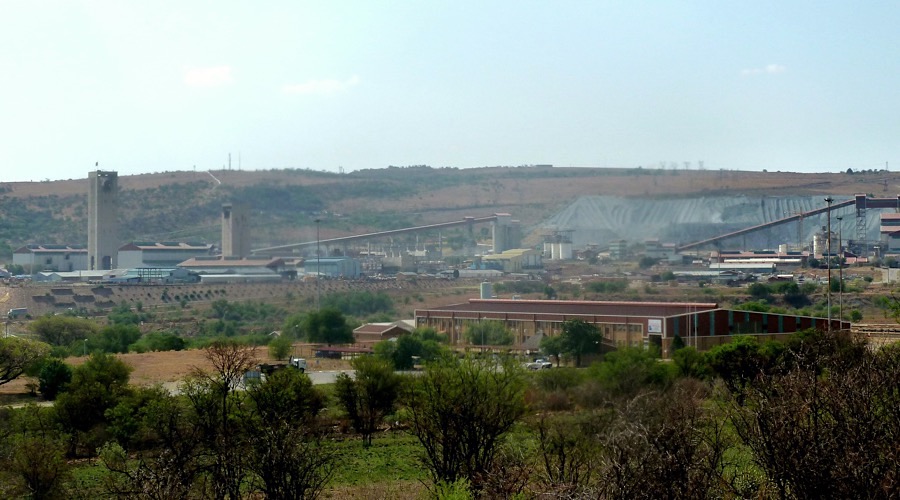
https://phys.org/news/2018-02-based-hydrothermal-sources-pos…
http://www.mining.com/s-africas-mponeng-gold-mine-hold-key-s…
https://www.popsci.com/nasa-europa-lander-alien-life
http://www.nature.com/articles/s41598-017-18470-z
"Brazilian researchers linked to the University of São Paulo (USP) have developed a model based on conditions found at Mponeng gold mine near Johannesburg, South Africa, at a depth of 2.8 km, to evaluate how habitable Jupiter’s icy moon Europa may be.
Based on the theory that Europa may host life in an ocean of liquid water hidden under its 10 km-deep ice crust, the team located a similar environment here on Earth to explore such possibility.
The chosen place was the Mponeng gold mine, which is leaking water full of radioactive uranium. The uranium’s presence breaks down water molecules into highly reactive free radicals, which then dissolves the surrounding rocks and releases sulfate. The researchers found that the bacteria could use that sulfate to create energy.
“This is THE FIRST TIME AN ECOSYSTEM HAS BEEN FOUND TO SURVIVE DIRECTLY ON THE BASIS OF NUCLEAR ENERGY,” said Douglas Galante, the study coordinator, in a press release.
By this method, the bacteria are able to survive without sunlight.
According to the study, published in the journal Scientific Reports, the environment colonized by bacteria in the Mponeng mine is an excellent analogue of the environment assumed to exist at the bottom of Europa’s ocean.
“The ocean bed on Europa appears to offer very similar conditions to those that existed on primitive Earth during its first billion years,” Galante notes. “So studying Europa today is to some extent like looking back at our own planet in the past.”
While the temperature in Europa’s surface is next to absolute zero, scientists have determined that there is an enormous amount of thermal energy in its core.
 "
"
S. Africa’s Mponeng gold mine COULD HOLD KEY TO SURVIVING IN SPACE

https://phys.org/news/2018-02-based-hydrothermal-sources-pos…
http://www.mining.com/s-africas-mponeng-gold-mine-hold-key-s…
https://www.popsci.com/nasa-europa-lander-alien-life
http://www.nature.com/articles/s41598-017-18470-z
"Brazilian researchers linked to the University of São Paulo (USP) have developed a model based on conditions found at Mponeng gold mine near Johannesburg, South Africa, at a depth of 2.8 km, to evaluate how habitable Jupiter’s icy moon Europa may be.
Based on the theory that Europa may host life in an ocean of liquid water hidden under its 10 km-deep ice crust, the team located a similar environment here on Earth to explore such possibility.
The chosen place was the Mponeng gold mine, which is leaking water full of radioactive uranium. The uranium’s presence breaks down water molecules into highly reactive free radicals, which then dissolves the surrounding rocks and releases sulfate. The researchers found that the bacteria could use that sulfate to create energy.
“This is THE FIRST TIME AN ECOSYSTEM HAS BEEN FOUND TO SURVIVE DIRECTLY ON THE BASIS OF NUCLEAR ENERGY,” said Douglas Galante, the study coordinator, in a press release.
By this method, the bacteria are able to survive without sunlight.
According to the study, published in the journal Scientific Reports, the environment colonized by bacteria in the Mponeng mine is an excellent analogue of the environment assumed to exist at the bottom of Europa’s ocean.
“The ocean bed on Europa appears to offer very similar conditions to those that existed on primitive Earth during its first billion years,” Galante notes. “So studying Europa today is to some extent like looking back at our own planet in the past.”
While the temperature in Europa’s surface is next to absolute zero, scientists have determined that there is an enormous amount of thermal energy in its core.
 "
" 
http://www.mining.com/german-scientists-build-machine-speeds…
https://horizon-magazine.eu/article/urban-mining-reduce-envi…
"Scientists at the Fraunhofer Institute for Laser Technology ILT in Aachen, Germany, want to build a machine that is able to disassemble two mobile phones in one minute and remove its components to, later on, extract metals from them.
The process is known as urban mining and it aims to recover raw materials such as copper, silver, gold, neodymium, and tantalum from old electronic devices. The metals would be destined to the production of new cellphones, computers, tablets, etc.
Following the extraction of individual, larger components, a laser would be used to unsolder them from the electronic circuit board before they are sorted by type and treated differently to make them reusable.
In an interview with Horizon Magazine, Cord Fricke-Begemann from the Fraunhofer Institute said that the main challenge his team is facing right now, when it comes to the machine's design, is figuring out how to make it work with all the different types of electronics that exist.
"There are hundreds of different types of mobile phones so we need a device that is flexible and can handle all of them," Fricke-Begemann told the institutional publication.
According to the researcher, turning to this type of mining and making it more efficient would not only support the EU efforts to move towards a low-carbon economy, but it would also reduce the bloc's dependence from foreign metal providers and shield it from fluctuating prices.
According to Horizon, some urban mining already takes place in the region but it involves melting devices together in a furnace and removing the most valuable metals."
http://www.proactiveinvestors.co.uk/companies/stocktube/8890…
- Apollo Minerals' (ASX:AON) Hugo Schumann runs Proactive through the exploration and development plans for their flagship Couflens tungsten-copper-gold Project in the South of France. ''There's two opportunities here - the first is to reopen the world's highest grade tungsten mine ... and the second opportunity is gold''. ''We think there's a very exciting gold opportunity along big fault systems in the region''. -
- Apollo Minerals' (ASX:AON) Hugo Schumann runs Proactive through the exploration and development plans for their flagship Couflens tungsten-copper-gold Project in the South of France. ''There's two opportunities here - the first is to reopen the world's highest grade tungsten mine ... and the second opportunity is gold''. ''We think there's a very exciting gold opportunity along big fault systems in the region''. -
Sebastián Piñera, quote: Chiles "Kupfer ist ALLES alle"
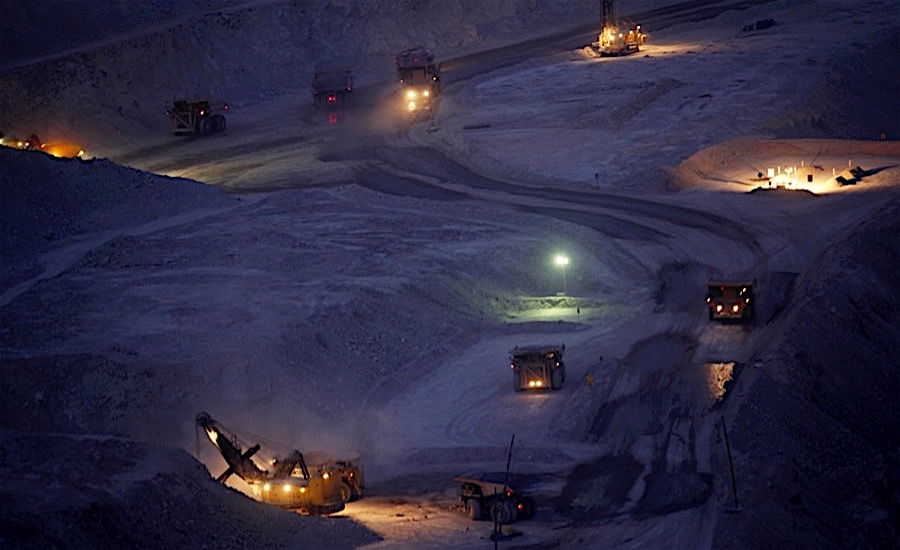
http://www.mining.com/worlds-no-1-copper-miner-codelco-made-…

http://www.mining.com/worlds-no-1-copper-miner-codelco-made-…
researchers: Lithium/Cobalt supply/demand is CRYSTALclear. bis 2050
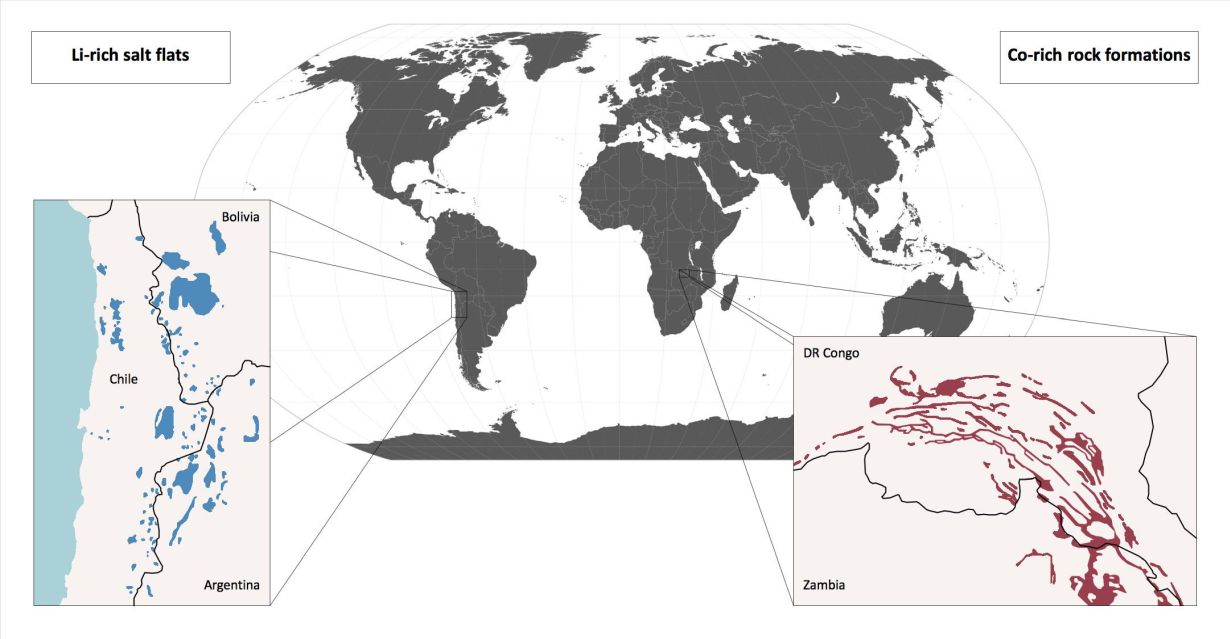
http://www.mining.com/electric-cars-dreams-may-shattered-205…
http://www.sciencedaily.com/releases/2018/03/180314110856.ht…
http://www.nature.com/articles/natrevmats201813
http://www.mining.com/new-study-rips-cobalt-lithium-price-bu…
http://www.kit.edu/kit/english/pi_2018_027_scenario-2050-lit…
http://www.mining.com/soaring-cobalt-prices-force-samsung-sd…

http://www.mining.com/electric-cars-dreams-may-shattered-205…
http://www.sciencedaily.com/releases/2018/03/180314110856.ht…
http://www.nature.com/articles/natrevmats201813
http://www.mining.com/new-study-rips-cobalt-lithium-price-bu…
http://www.kit.edu/kit/english/pi_2018_027_scenario-2050-lit…
http://www.mining.com/soaring-cobalt-prices-force-samsung-sd…
Toyota: for building EVs we need FOUR times more Rare Earths

http://www.mining.com/toyota-make-cheaper-electric-motors-ne…

http://www.mining.com/toyota-make-cheaper-electric-motors-ne…
Mali King, quote: We' "ll shut down ALL mines"

http://www.mining.com/web/mali-says-negotiating-mining-code-…
http://www.mining.com/web/mali-says-negotiating-mining-code-…
Antwort auf Beitrag Nr.: 57.309.310 von Popeye82 am 17.03.18 22:30:33Das Beispiel Kongo macht also Schule. Wenig verwunderlich. Aber die Ausgangssituation ist bei beiden Ländern doch sehr unterschiedlich. Die Konsequenzen könnten für Mail, in Abhängigkeit von den durchzuführenden Änderungen, weitaus gravierender sein. Auch hier gilt wohl die alte Börsenweisheit "Gier frisst Hirn".
B. Cook, quote: "ALL resouce stocks will go to ZERO"
Mr Terranova: I "LOVE 20g(/t) Silver deposits"

https://stockhead.com.au/resources/eric-sprott-backed-metals…
http://metals479.com/
https://stockhead.com.au/resources/eric-sprott-backed-metals…
http://metals479.com/
Antwort auf Beitrag Nr.: 57.325.268 von Popeye82 am 20.03.18 04:20:29
http://www.nextminingboom.com/tando-resources-asxtno-acquire…
http://www.tandoresources.com.au/sites/default/files/asx-ann…
http://www.nextminingboom.com/tando-resources-asxtno-acquire…
http://www.tandoresources.com.au/sites/default/files/asx-ann…
Antwort auf Beitrag Nr.: 56.786.929 von Popeye82 am 22.01.18 11:01:01LAAAAANGSAM blickenses

- Kellingley Colliery, once considered one of the most successful coal mines in the UK, was shut down in 2015. (Image from ITV News | Creative Commons.) -
http://www.theguardian.com/business/2018/jan/21/lloyds-of-lo…
"Lloyd's of London to divest from coal, over climate change; Firm follows other big UK and European insurers by excluding coal companies from 1 April; Lloyd’s of London, the world’s oldest insurance market, has become the latest financial firm to announce that it plans to stop investing in coal companies. Lloyd’s will start to exclude coal from its investment strategy from 1 April. The definition of what is a coal company and the criteria for divestment will be set over the coming months.
Lloyd’s of London, the world’s oldest insurance market, has become the latest financial firm to announce that it plans to stop investing in coal companies.
Lloyd’s will start to exclude coal from its investment strategy from 1 April. The definition of what is a coal company and the criteria for divestment will be set over the coming months.
The firm has long been vocal about the need to battle climate change, with insurance one of the worst affected industries by hurricanes, wildfires and flooding in recent years.
The insurance market decided last month to implement a coal exclusion policy as part of a responsible investment strategy for the central mutual fund that sits behind every insurance policy written by the Lloyd’s market.
Beyond Davos – in avalanche country – lies an inescapable fragility
Larry Elliott
Larry Elliott
Read more
Inga Beale, Lloyd’s of London chief executive, said: “That means that in the areas of our portfolio where we can directly influence investment decisions we will avoid investing in companies that are involved mainly in coal.
“Is there more the insurance sector could be doing to help the world transition to a low-carbon economy by choosing sustainable or low-carbon stocks?”
Lloyd’s does not underwrite operations directly, but offers a marketplace to almost 90 syndicates of other insurers.
Lloyd’s has been slower to take action than others. Other big UK and European insurance companies, including Aviva, Allianz, Axa, Legal & General, SCOR, Swiss Re and Zurich, have been shifting away from coal and other fossil fuels due to concerns about climate risks. About £15bn has been divested by insurers in the past two years, according to a recent report from Unfriend Coal Network, a global coalition of NGOs and campaigners including 350.org and Greenpeace. It said 15 companies – almost all in Europe – have fully or partially cut financial ties by selling holdings in coal companies and refusing to insure their operations.
France’s Axa was one of the first financial firms to reduce investments in coal in May 2015 and is still leading the way. It said last month it was ditching investments and ending insurance for controversial US oil pipelines. After being criticised by campaigners for applying a threshold of 50% of revenues to define coal companies, it lowered the threshold to 30%.
Lloyd’s of London starts paying out $4.5bn of Harvey and Irma claims
Read more
The Church of England has gone further, pulling out of investing in companies that make more than 10% of their revenues from thermal coal or oil from tar sands.
Analysis by the ClimateWise coalition of the world’s biggest insurers published in December 2016 found that more frequent extreme weather events were driving up uninsured losses and making some assets uninsurable. The report concluded that the “protection gap” – the difference between the costs of natural disasters and the amount insured – had quadrupled to $100bn (£79bn) a year since the 1980s.
Advertisement
Insurance companies are perhaps also mindful of the danger that they could suffer a huge loss if their investments in fossil fuel companies were rendered worthless by action on climate change, as the Bank of England warned in 2015. However, some banks are still investing in coal plants, according to research from campaign groups.
Beale told the Guardian that she would be discussing the group’s new investment strategy at the World Economic Forum’s annual meeting in Davos this week.
Climate change and what investors can do will feature prominently at the meeting of political and business leaders. Beale said: “It goes beyond climate change. The broader issue is how we clean up the planet.”
Investment companies and organisations divesting from coal
Allianz
Axa
Aviva
BMO Global Asset Management
Church of England
Generali
Legal & General
Munich Re
Natixis
SCOR
Storebrand
Swiss Re
Zurich
Follow Guardian Business on Twitter at @BusinessDesk, or sign up to the daily Business Today email here."
_______________________________________________________________________
Rio Tinto FULLY out of coal
http://www.mining.com/rio-tinto-fully-coal-sector-2-25bn-kes…
http://otp.investis.com/clients/uk/rio_tinto1/rns/regulatory…
http://www.australianmining.com.au/news/rio-tinto-continues-…
http://www.mining-journal.com/bulks/news/1334909/rio-tinto-f…

- Kellingley Colliery, once considered one of the most successful coal mines in the UK, was shut down in 2015. (Image from ITV News | Creative Commons.) -
http://www.theguardian.com/business/2018/jan/21/lloyds-of-lo…
"Lloyd's of London to divest from coal, over climate change; Firm follows other big UK and European insurers by excluding coal companies from 1 April; Lloyd’s of London, the world’s oldest insurance market, has become the latest financial firm to announce that it plans to stop investing in coal companies. Lloyd’s will start to exclude coal from its investment strategy from 1 April. The definition of what is a coal company and the criteria for divestment will be set over the coming months.
Lloyd’s of London, the world’s oldest insurance market, has become the latest financial firm to announce that it plans to stop investing in coal companies.
Lloyd’s will start to exclude coal from its investment strategy from 1 April. The definition of what is a coal company and the criteria for divestment will be set over the coming months.
The firm has long been vocal about the need to battle climate change, with insurance one of the worst affected industries by hurricanes, wildfires and flooding in recent years.
The insurance market decided last month to implement a coal exclusion policy as part of a responsible investment strategy for the central mutual fund that sits behind every insurance policy written by the Lloyd’s market.
Beyond Davos – in avalanche country – lies an inescapable fragility
Larry Elliott
Larry Elliott
Read more
Inga Beale, Lloyd’s of London chief executive, said: “That means that in the areas of our portfolio where we can directly influence investment decisions we will avoid investing in companies that are involved mainly in coal.
“Is there more the insurance sector could be doing to help the world transition to a low-carbon economy by choosing sustainable or low-carbon stocks?”
Lloyd’s does not underwrite operations directly, but offers a marketplace to almost 90 syndicates of other insurers.
Lloyd’s has been slower to take action than others. Other big UK and European insurance companies, including Aviva, Allianz, Axa, Legal & General, SCOR, Swiss Re and Zurich, have been shifting away from coal and other fossil fuels due to concerns about climate risks. About £15bn has been divested by insurers in the past two years, according to a recent report from Unfriend Coal Network, a global coalition of NGOs and campaigners including 350.org and Greenpeace. It said 15 companies – almost all in Europe – have fully or partially cut financial ties by selling holdings in coal companies and refusing to insure their operations.
France’s Axa was one of the first financial firms to reduce investments in coal in May 2015 and is still leading the way. It said last month it was ditching investments and ending insurance for controversial US oil pipelines. After being criticised by campaigners for applying a threshold of 50% of revenues to define coal companies, it lowered the threshold to 30%.
Lloyd’s of London starts paying out $4.5bn of Harvey and Irma claims
Read more
The Church of England has gone further, pulling out of investing in companies that make more than 10% of their revenues from thermal coal or oil from tar sands.
Analysis by the ClimateWise coalition of the world’s biggest insurers published in December 2016 found that more frequent extreme weather events were driving up uninsured losses and making some assets uninsurable. The report concluded that the “protection gap” – the difference between the costs of natural disasters and the amount insured – had quadrupled to $100bn (£79bn) a year since the 1980s.
Advertisement
Insurance companies are perhaps also mindful of the danger that they could suffer a huge loss if their investments in fossil fuel companies were rendered worthless by action on climate change, as the Bank of England warned in 2015. However, some banks are still investing in coal plants, according to research from campaign groups.
Beale told the Guardian that she would be discussing the group’s new investment strategy at the World Economic Forum’s annual meeting in Davos this week.
Climate change and what investors can do will feature prominently at the meeting of political and business leaders. Beale said: “It goes beyond climate change. The broader issue is how we clean up the planet.”
Investment companies and organisations divesting from coal
Allianz
Axa
Aviva
BMO Global Asset Management
Church of England
Generali
Legal & General
Munich Re
Natixis
SCOR
Storebrand
Swiss Re
Zurich
Follow Guardian Business on Twitter at @BusinessDesk, or sign up to the daily Business Today email here."
_______________________________________________________________________
Rio Tinto FULLY out of coal
http://www.mining.com/rio-tinto-fully-coal-sector-2-25bn-kes…
http://otp.investis.com/clients/uk/rio_tinto1/rns/regulatory…
http://www.australianmining.com.au/news/rio-tinto-continues-…
http://www.mining-journal.com/bulks/news/1334909/rio-tinto-f…
using atomic bombs to kill mosquitos
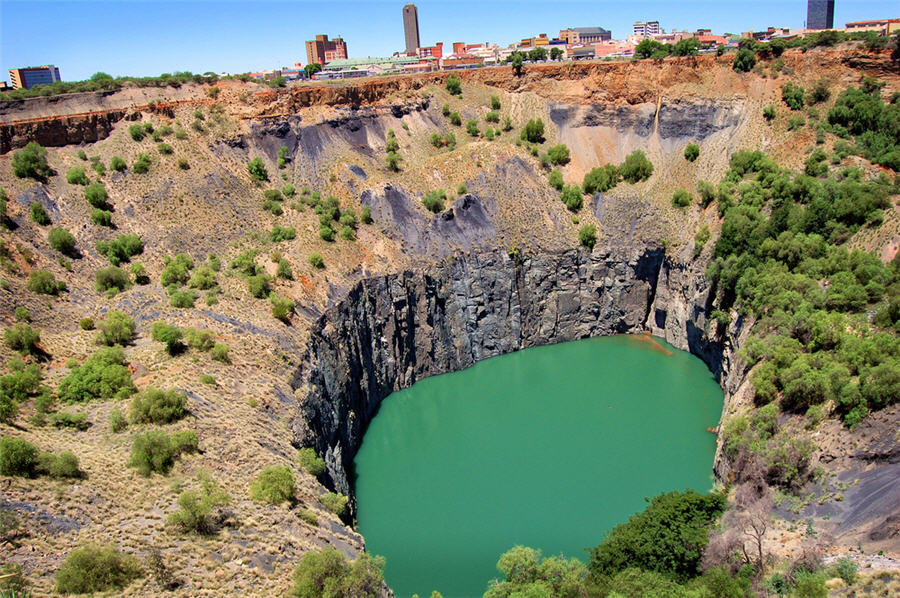
http://www.mining.com/web/unintended-environmental-consequen…
"By Tom Henry and Michael Sherman
The California State Mining and Geology Board (“Board”) recently took its first step to revise California’s backfill regulation that applies to the reclamation of open pit metallic mineral mines. On December 14, 2017, the Board voted to review the backfill regulation after hearing public comments as to why the regulation has increased, rather than reduced, environmental impacts associated with mining. The Board and the State Division of Mine Reclamation plan to hold several public meetings in 2018 during which it will hear comments from the mining industry and other stakeholders. The Board is expected to adopt revisions to the backfill regulation later this year.
The current backfill regulation has severely curtailed metallic mineral mining in California since it was adopted in 2002. The backfill regulation has two key requirements for open pit metallic mineral mines. First, the regulation requires all new open pit excavations to be backfilled to the original surface elevation as part of reclamation. Second, any excess material must be graded so that the resulting topography does not exceed the pre-mining surface elevation by more than 25 feet.
The regulations were originally adopted in 2002 in an action that has been described as using an atomic bomb to kill a mosquito. The mosquito in this case was Glamis Gold’s proposed Imperial Project, an open pit gold mine in Imperial County, California. The project was highly controversial within California. The project, which was located on federal lands, was originally disapproved by the federal Bureau of Land Management (“BLM”) in January 2001 during the last days of the Clinton administration. The BLM cited several key factors in reaching its decision, including the project’s impacts on Native American resources, unavoidable visual impacts and inconsistency with the federally designated California Desert Conservation Area (“CDCA”), an area within the Mojave Desert.
However, the Bush administration reversed the January 2001 decision and approved the Imperial Project in November 2001. In response, the State took several steps to prevent Glamis Gold from mining. First, on December 18, 2002, the Board adopted an emergency backfill regulation. The emergency regulation ostensibly would have reduced the impacts from the Imperial Project by returning the mined site to a condition close to what it was before mining. However, the practical, and likely intended, effect was to make the mine economically infeasible. Unfortunately, the regulation was adopted to apply to all new metallic mineral mines within the entirety of the State.
The California Legislature then acted in 2003 to adopt similar changes to the State’s Surface Mining and Reclamation Act, the statute that regulates mining in California. The Legislature’s changes were similar to the regulatory changes adopted by the Board with one critical difference. The statutory restriction only requires the backfilling of metallic mine pits when the mine is located within one mile of a Native American sacred site and within the CDCA in an “area of special concern.” The Imperial Project met both of these requirements under the backfill statute.
Even though the California Legislature’s changes were much more limited than the regulations previously adopted by the Board, the Board never amended the backfill regulation to encompass only those limited areas within the CDCA covered by the statute. Instead, the backfill regulation continues to apply to any new metallic mineral mine within the State.
Besides halting the Imperial Project, the backfill regulation had an immediate, detrimental impact on proposed metallic mineral mine projects in California. Only one metallic mineral mine has been approved under the new requirements in the 15 years since the regulation was adopted. That project, Golden Queen’s Soledad Mountain Mine, provides a good illustration of the problems posed by the regulation. In order to comply with the requirement to reduce all mined material to within 25 feet of the original topography, the mine’s reclamation plan requires reducing ore heaps to within 25 feet of the original contour by removing potentially hazardous material from a lined facility and spreading it over an otherwise undisturbed area of approximately one square mile. Other additional impacts include steep increases in air emissions, including greenhouse gases, associated with having to move mined material twice.
Other proposed project proponents have also struggled with the question of whether other material such as hazardous tailings would have to be deposited in an open pit, e.g., in the situation where there is insufficient material to backfill the pit.
Regulators eventually began to reassess the backfill regulation. The authors of this article, along with representatives of Golder Associates, provided a presentation to the Board in 2015. We reviewed the impacts associated with the backfill regulation and encouraged the Board to require backfilling and ore heap reduction only when an analysis under the State’s environmental review law, the California Environmental Quality Act, indicates that those options would be the best environmental option when compared with partial backfill or no backfill alternatives. In effect, the present requirements have elevated aesthetic concerns above all other impacts and effectively prevented agencies from approving alternatives that scientific analysis indicates would result in fewer environmental impacts. We have also encouraged the Board to preclude certain actions in all instances by, for example, not obligating mines to use tailings as pit backfill materials.
The Board committee responsible for amending regulations, along with the Division of Mine Reclamation, will begin scheduling three public workshop meetings in the next several months. The committee will also seek written comments from interested stakeholders, including the mining industry.
Tom Henry is a partner in the Environment, Land Use and Natural Resources group at Stoel Rives LLP specializing in land use, mining, and oil and gas matters. He can be reached at thomas.henry@stoel.com. Stoel Rives Partner Michael Sherman's practice focuses on land use, transactional, and federal and state wildlife issues for developers, farmers, and mining and oil and gas companies. He can be reached at michael.sherman@stoel.com."

http://www.mining.com/web/unintended-environmental-consequen…
"By Tom Henry and Michael Sherman
The California State Mining and Geology Board (“Board”) recently took its first step to revise California’s backfill regulation that applies to the reclamation of open pit metallic mineral mines. On December 14, 2017, the Board voted to review the backfill regulation after hearing public comments as to why the regulation has increased, rather than reduced, environmental impacts associated with mining. The Board and the State Division of Mine Reclamation plan to hold several public meetings in 2018 during which it will hear comments from the mining industry and other stakeholders. The Board is expected to adopt revisions to the backfill regulation later this year.
The current backfill regulation has severely curtailed metallic mineral mining in California since it was adopted in 2002. The backfill regulation has two key requirements for open pit metallic mineral mines. First, the regulation requires all new open pit excavations to be backfilled to the original surface elevation as part of reclamation. Second, any excess material must be graded so that the resulting topography does not exceed the pre-mining surface elevation by more than 25 feet.
The regulations were originally adopted in 2002 in an action that has been described as using an atomic bomb to kill a mosquito. The mosquito in this case was Glamis Gold’s proposed Imperial Project, an open pit gold mine in Imperial County, California. The project was highly controversial within California. The project, which was located on federal lands, was originally disapproved by the federal Bureau of Land Management (“BLM”) in January 2001 during the last days of the Clinton administration. The BLM cited several key factors in reaching its decision, including the project’s impacts on Native American resources, unavoidable visual impacts and inconsistency with the federally designated California Desert Conservation Area (“CDCA”), an area within the Mojave Desert.
However, the Bush administration reversed the January 2001 decision and approved the Imperial Project in November 2001. In response, the State took several steps to prevent Glamis Gold from mining. First, on December 18, 2002, the Board adopted an emergency backfill regulation. The emergency regulation ostensibly would have reduced the impacts from the Imperial Project by returning the mined site to a condition close to what it was before mining. However, the practical, and likely intended, effect was to make the mine economically infeasible. Unfortunately, the regulation was adopted to apply to all new metallic mineral mines within the entirety of the State.
The California Legislature then acted in 2003 to adopt similar changes to the State’s Surface Mining and Reclamation Act, the statute that regulates mining in California. The Legislature’s changes were similar to the regulatory changes adopted by the Board with one critical difference. The statutory restriction only requires the backfilling of metallic mine pits when the mine is located within one mile of a Native American sacred site and within the CDCA in an “area of special concern.” The Imperial Project met both of these requirements under the backfill statute.
Even though the California Legislature’s changes were much more limited than the regulations previously adopted by the Board, the Board never amended the backfill regulation to encompass only those limited areas within the CDCA covered by the statute. Instead, the backfill regulation continues to apply to any new metallic mineral mine within the State.
Besides halting the Imperial Project, the backfill regulation had an immediate, detrimental impact on proposed metallic mineral mine projects in California. Only one metallic mineral mine has been approved under the new requirements in the 15 years since the regulation was adopted. That project, Golden Queen’s Soledad Mountain Mine, provides a good illustration of the problems posed by the regulation. In order to comply with the requirement to reduce all mined material to within 25 feet of the original topography, the mine’s reclamation plan requires reducing ore heaps to within 25 feet of the original contour by removing potentially hazardous material from a lined facility and spreading it over an otherwise undisturbed area of approximately one square mile. Other additional impacts include steep increases in air emissions, including greenhouse gases, associated with having to move mined material twice.
Other proposed project proponents have also struggled with the question of whether other material such as hazardous tailings would have to be deposited in an open pit, e.g., in the situation where there is insufficient material to backfill the pit.
Regulators eventually began to reassess the backfill regulation. The authors of this article, along with representatives of Golder Associates, provided a presentation to the Board in 2015. We reviewed the impacts associated with the backfill regulation and encouraged the Board to require backfilling and ore heap reduction only when an analysis under the State’s environmental review law, the California Environmental Quality Act, indicates that those options would be the best environmental option when compared with partial backfill or no backfill alternatives. In effect, the present requirements have elevated aesthetic concerns above all other impacts and effectively prevented agencies from approving alternatives that scientific analysis indicates would result in fewer environmental impacts. We have also encouraged the Board to preclude certain actions in all instances by, for example, not obligating mines to use tailings as pit backfill materials.
The Board committee responsible for amending regulations, along with the Division of Mine Reclamation, will begin scheduling three public workshop meetings in the next several months. The committee will also seek written comments from interested stakeholders, including the mining industry.
Tom Henry is a partner in the Environment, Land Use and Natural Resources group at Stoel Rives LLP specializing in land use, mining, and oil and gas matters. He can be reached at thomas.henry@stoel.com. Stoel Rives Partner Michael Sherman's practice focuses on land use, transactional, and federal and state wildlife issues for developers, farmers, and mining and oil and gas companies. He can be reached at michael.sherman@stoel.com."
R. Duterte, quote: I "wish me all the best, and you the rest"





http://www.mining.com/web/nickel-market-eyes-philippines-min…






http://www.mining.com/web/nickel-market-eyes-philippines-min…
http://www.australianmining.com.au/news/icmm-identifies-four…
- March 26, 2018 – “There’s a lot of those macro metals that are going to very well through that increased focus on the transition to a low carbon future. Cobalt, lithium, these are going to be huge as well, as is nickel.” – states Aidan Davy, COO and Director of the International Council on Mining and Metals (ICMM), in an interview with InvestorIntel’s Jeff Wareham. Jeff Wareham: What are you seeing at PDAC this year? Aidan Davy: It has been a real interesting PDAC. I have been coming to PDAC for about 6-7 years now. I lived with PDAC through the best of times and the worst of times. Jeff Wareham: Especially the worst. Aidan Davy: It has been fascinating because I think even when the industry was going through the toughest times, and particularly we are thinking about 2015 still going into 2016, PDAC has remained resolutely kind of optimistic throughout that whole cycle. It still has been very, very different and I think very gratifying to see that there has been much more optimism here than we have had for a couple of years now. Jeff Wareham: From what I understand you have quite a background in the critical metals and in sustainability. What themes do you see in 2018? Aidan Davy: Interesting, for 2018, and my background is I am a sustainability professional. I have worked in this space for about 30 years. The organization I represent we work with 25 companies. They work across continents, across commodities and collectively they represent something like 30% to 50% of global production of major metals. When I look at the trends that I see for the industry there is four big trends that I am seeing as being really important in 2018. One is climate change. It is critically important, both in terms of the risk and the opportunity space. A second one is around the whole issue of contested ownership of resources. Some call it resource nationalism. I tend to avoid that term. That I think is a big, big issue for the sector. The third has got to be the rise in ethical consumer facing companies. The fourth is probably around gender, which is an issue that has been coming for this industry for a while and it is very much here. Jeff Wareham: Wow. Those are some pretty broad subjects. Let us pick one. What do you think of those trends is going to matter the most in 2018? Aidan Davy: I think they are all going to be critically important. Let us take the climate trend because that connects to the consumer facing company trend as well. I think historically this industry has been slow to engage on climate change, but in the past decade has really started to engage in a much, much more proactive way. Again, I think the initial entry point around this was very much looking at it through a risk lens. It has been around to, what extent are we contributing to carbon emissions? To what extent can we limit our impact in that space? But, also, to what extent can we make our operations more climate resilient? I think that has been a primary focus. What is changing now is the conversation increasingly is one around, what is the role of this industry in looking at the transition to a low-carbon future? That is very different for the mining and metals industry than oil and gas. Oil and gas is arguably faced with an existential crisis by the increasing attention around climate change, whereas for this industry there’s a huge opportunity. Jeff Wareham: And what sort of companies do you see benefiting from those opportunities?: Aidan Davy: There are a whole range of commodities that are going to be critically important in making that transition to a low carbon future. Whether you are talking about the critical metals and some of the rare earth metals. That’s essential, fundamental. Then some of the macro metals, for example, copper is a critical part of the solution here. Iron ore is a critical part because if you are building large scale infrastructure around low carbon economy then that’s an incredibly important commodity. Things like aluminum, fundamentally important. There’s a lot of those macro metals that are going to very well through that increased focus on the transition to a low carbon future. Cobalt, lithium, these are going to be huge as well, as is nickel...to access the complete interview click, ------>HERE<------ -
- March 26, 2018 – “There’s a lot of those macro metals that are going to very well through that increased focus on the transition to a low carbon future. Cobalt, lithium, these are going to be huge as well, as is nickel.” – states Aidan Davy, COO and Director of the International Council on Mining and Metals (ICMM), in an interview with InvestorIntel’s Jeff Wareham. Jeff Wareham: What are you seeing at PDAC this year? Aidan Davy: It has been a real interesting PDAC. I have been coming to PDAC for about 6-7 years now. I lived with PDAC through the best of times and the worst of times. Jeff Wareham: Especially the worst. Aidan Davy: It has been fascinating because I think even when the industry was going through the toughest times, and particularly we are thinking about 2015 still going into 2016, PDAC has remained resolutely kind of optimistic throughout that whole cycle. It still has been very, very different and I think very gratifying to see that there has been much more optimism here than we have had for a couple of years now. Jeff Wareham: From what I understand you have quite a background in the critical metals and in sustainability. What themes do you see in 2018? Aidan Davy: Interesting, for 2018, and my background is I am a sustainability professional. I have worked in this space for about 30 years. The organization I represent we work with 25 companies. They work across continents, across commodities and collectively they represent something like 30% to 50% of global production of major metals. When I look at the trends that I see for the industry there is four big trends that I am seeing as being really important in 2018. One is climate change. It is critically important, both in terms of the risk and the opportunity space. A second one is around the whole issue of contested ownership of resources. Some call it resource nationalism. I tend to avoid that term. That I think is a big, big issue for the sector. The third has got to be the rise in ethical consumer facing companies. The fourth is probably around gender, which is an issue that has been coming for this industry for a while and it is very much here. Jeff Wareham: Wow. Those are some pretty broad subjects. Let us pick one. What do you think of those trends is going to matter the most in 2018? Aidan Davy: I think they are all going to be critically important. Let us take the climate trend because that connects to the consumer facing company trend as well. I think historically this industry has been slow to engage on climate change, but in the past decade has really started to engage in a much, much more proactive way. Again, I think the initial entry point around this was very much looking at it through a risk lens. It has been around to, what extent are we contributing to carbon emissions? To what extent can we limit our impact in that space? But, also, to what extent can we make our operations more climate resilient? I think that has been a primary focus. What is changing now is the conversation increasingly is one around, what is the role of this industry in looking at the transition to a low-carbon future? That is very different for the mining and metals industry than oil and gas. Oil and gas is arguably faced with an existential crisis by the increasing attention around climate change, whereas for this industry there’s a huge opportunity. Jeff Wareham: And what sort of companies do you see benefiting from those opportunities?: Aidan Davy: There are a whole range of commodities that are going to be critically important in making that transition to a low carbon future. Whether you are talking about the critical metals and some of the rare earth metals. That’s essential, fundamental. Then some of the macro metals, for example, copper is a critical part of the solution here. Iron ore is a critical part because if you are building large scale infrastructure around low carbon economy then that’s an incredibly important commodity. Things like aluminum, fundamentally important. There’s a lot of those macro metals that are going to very well through that increased focus on the transition to a low carbon future. Cobalt, lithium, these are going to be huge as well, as is nickel...to access the complete interview click, ------>HERE<------ -
- SmallCap InvestorTV
Am 27.03.2018 veröffentlicht
- Frank, woher kommt eigentlich der Name?
- Wo ist das Projekt und was habt ihr bis jetzt damit gemacht?
- Von welchen Gehalten sprechen wir?
- Geht die Strip-Ratio im Untergrund so stark zurück?
- Wie tief geht derzeit die Vererzung?
- Was tut ihr jetzt?
- Wie hoch liegen die CAPEX für das Open-Pit-Projekt?
- Dh. wir können dieses Jahr mit einem sehr hohen Newsflow rechnen?
- Wie schaut die Aktienstruktur aus?
- Ihr habt bereits jetzt die Produktionsgenehmigung? -
http://www.granadagoldmine.com/en/news/2018/granada-gold-min…
http://www.granadagoldmine.com/site/assets/files/2466/granad…
argentinia König, quote: "stay AWAY with that Lithium crap"!
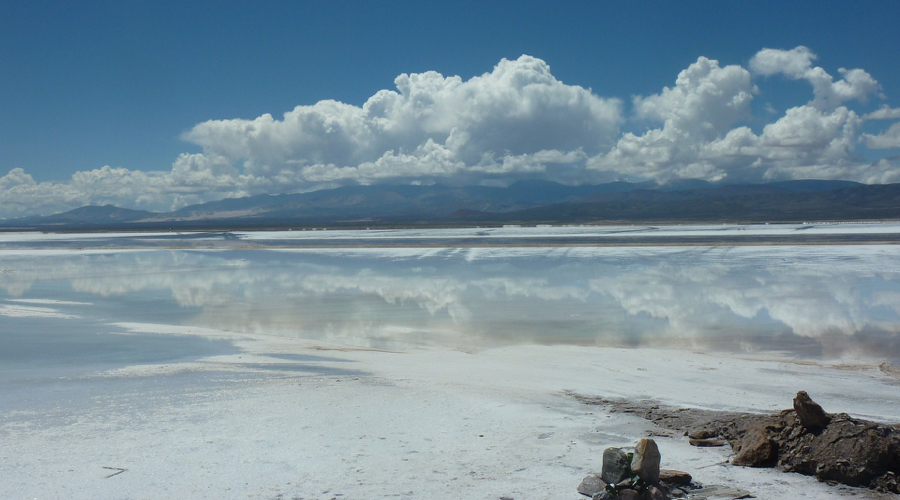
http://www.mining.com/argentinian-provinces-join-lithium-boa…
http://www.mining.com/web/argentina-wants-overtake-chile-sou…
http://www.ipsnews.net/2018/01/argentina-pursues-lithium-dre…
https://www.argentina.gob.ar/sites/default/files/presentacio…
http://www.infobae.com/politica/2018/03/31/avanza-la-guerra-…
http://www.mining.com/web/chile-open-increasing-sqm-lithium-…

http://www.mining.com/argentinian-provinces-join-lithium-boa…
http://www.mining.com/web/argentina-wants-overtake-chile-sou…
http://www.ipsnews.net/2018/01/argentina-pursues-lithium-dre…
https://www.argentina.gob.ar/sites/default/files/presentacio…
http://www.infobae.com/politica/2018/03/31/avanza-la-guerra-…
http://www.mining.com/web/chile-open-increasing-sqm-lithium-…
Antwort auf Beitrag Nr.: 57.409.673 von Popeye82 am 28.03.18 13:28:00
http://reneweconomy.com.au/greens-urge-end-coal-2030-turnbul…
http://reneweconomy.com.au/greens-urge-end-coal-2030-turnbul…
Reclassification of welding fume, as carcinogenic, from an AUSTRALIAN perspective

http://www.australianmining.com.au/whitepaper/reclassificati…

http://www.australianmining.com.au/whitepaper/reclassificati…
Ägypten has a STRATEGY; egypt king, quote: "5y plans are for LUTSCHER"
http://www.atonresources.com/news/2018/egyptian-ministry-of-…
https://sustainabledevelopment.un.org/content/documents/1526…
http://sdsegypt2030.com/?lang=en
http://www.sis.gov.eg/Story/127069?lang=en-us
http://www.atonresources.com/news/2018/egyptian-ministry-of-…
https://sustainabledevelopment.un.org/content/documents/1526…
http://sdsegypt2030.com/?lang=en
http://www.sis.gov.eg/Story/127069?lang=en-us
Antwort auf Beitrag Nr.: 57.409.673 von Popeye82 am 28.03.18 13:28:00
http://www.australianmining.com.au/news/bhp-parts-ways-world…

http://www.australianmining.com.au/news/bhp-parts-ways-world…
NEW productivity improvements arround the corner

http://www.hortonww.com/off-highway.html?utm_source=mining&u…

http://www.hortonww.com/off-highway.html?utm_source=mining&u…
http://www.australianmining.com.au/news/resource-exports-wil…
http://www.industry.gov.au/Office-of-the-Chief-Economist/Pub…
http://www.industry.gov.au/Office-of-the-Chief-Economist/Pub…
"Resource exports will hit $1 trillion within five years, says gov’t
April 9, 2018News Ewen Hosie
Latest News
The Australian Government has released its latest quarterly report for the national resources and energy sector, the Resources and Energy Quarterly, which projects the Office of the Chief Economist’s outlook until 2022–23.
While the report predicts export earnings to decline somewhat from current levels (with iron ore and coking coal prices expected to fall in particular), it expects the next five years to deliver over $1 trillion in income from resources and energy exports, which is about 60 per cent of Australia’s 2017 gross domestic product (GDP).
Annual export levels are expected to increase to a record $230 billion for 2017–18, buoyed by LNG prices, then sit around $213–216 billion from 2019–20, compared with annual earnings of $72 billion in the previous decade, which, according to Mark Cully, chief economist of the Department of Industry, Innovation and Science, validated a “long-held view that the mining boom would continue to reap dividends long after the price peak in 2011”.
By 2020, the rapid growth seen in Australia’s resources sector export volumes, driven by a mining investment boom, is expected to have “run its course”, however.
Iron ore exports grew 16 per cent last year to $63 billion, driven by high prices and export volume growth, while coking coal earnings for 2017–18 are forecast at around $40 billion. In 2018–19, LNG is expected to overtake coking coal as Australia’s second largest resource and energy export. Thermal coal export earning will hit a record $22.9 billion in 2017–18 before declining to $17.1 billion by 2022–23."
http://www.mining.com/iran-transfer-yellowcake-uranium-conve…
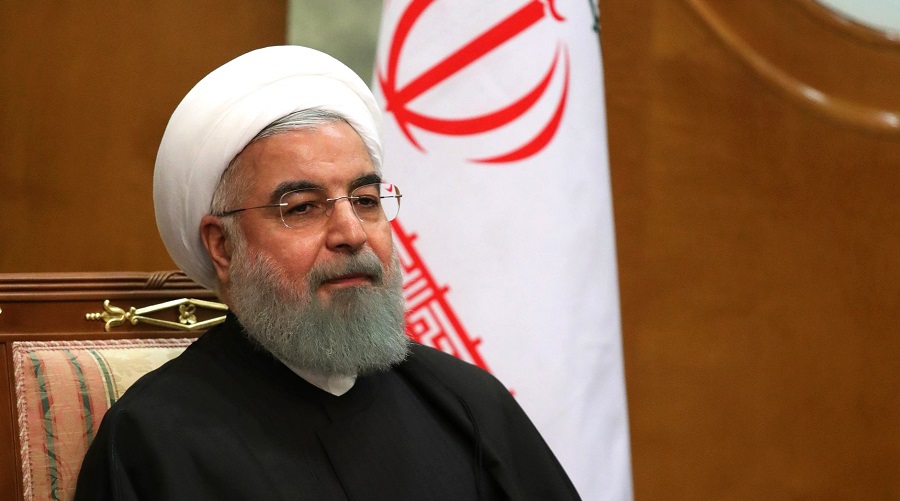
"Iran to transfer yellowcake, to uranium conversion facility
Valentina Ruiz Leotaud | about 9 hours ago |
Iran's President Hassan Rouhani. Photo from Wikimedia Commons.
During a ceremony held on Monday to mark Iran’s National Day of Nuclear Technology, President Hassan Rouhani issued an order to transfer yellowcake produced in the Ardakan factory, located in the central province of Yazd, to a uranium conversion facility in Isfahan.
According to the Tehran Times, the uranium from which the yellowcake was derived was originally extracted from the Saghand mine, also located in Yazd. The daily also stated that this is the first time the Iranian government makes a decision like this since it agreed to curb its nuclear activity in 2015 in exchange for the removal of nuclear sanctions.
At the event, the Head of the Atomic Energy Organization of Iran, Ali Akbar Salehi, unveiled the nation’s latest nuclear technological developments, which add up to 83 projects that include centrifuges and nuclear medicine.
Salehi said that, despite the large number of projects, the country is still complying with its obligation to scale back nuclear pursuits, as contemplated in the Joint Comprehensive Plan of Action it signed in Vienna three years ago together with China, France, Russia, the United Kingdom, the United States plus Germany, and the European Union.
However, Salehi is quoted as saying that is not acceptable that one side takes all the responsibility for implementing the deal and the other side refrains from fulfilling its legal commitments.
According to Reuters, Rouhani added to the former statement that Donald Trump will regret it if he pulls out of the nuclear deal. Back in January, Trump asked the rest of the signatories to “fix the terrible flaws” of the agreement by May 12 or risk a U.S. withdraw and a reinstatement of the sanctions against Tehran.
“Iran will not violate the nuclear deal, but if the United States withdraws from the deal, they will surely regret it. Our response will be stronger than what they imagine and they would see that within a week,” Rouhani is quoted as saying.


Earlier today, the spokesman of the Iran Atomic Energy Agency, Behrouz Kamalvandi, told the state-owned Islamic Republic News Agency that the country could ramp its uranium enrichment to 20 per cent in two days if it wanted to.

Gold
$1,335.720.64%
Silver
$16.511.04%
More in markets"

"Iran to transfer yellowcake, to uranium conversion facility

Valentina Ruiz Leotaud | about 9 hours ago |
Iran's President Hassan Rouhani. Photo from Wikimedia Commons.
During a ceremony held on Monday to mark Iran’s National Day of Nuclear Technology, President Hassan Rouhani issued an order to transfer yellowcake produced in the Ardakan factory, located in the central province of Yazd, to a uranium conversion facility in Isfahan.
According to the Tehran Times, the uranium from which the yellowcake was derived was originally extracted from the Saghand mine, also located in Yazd. The daily also stated that this is the first time the Iranian government makes a decision like this since it agreed to curb its nuclear activity in 2015 in exchange for the removal of nuclear sanctions.
At the event, the Head of the Atomic Energy Organization of Iran, Ali Akbar Salehi, unveiled the nation’s latest nuclear technological developments, which add up to 83 projects that include centrifuges and nuclear medicine.
Salehi said that, despite the large number of projects, the country is still complying with its obligation to scale back nuclear pursuits, as contemplated in the Joint Comprehensive Plan of Action it signed in Vienna three years ago together with China, France, Russia, the United Kingdom, the United States plus Germany, and the European Union.
However, Salehi is quoted as saying that is not acceptable that one side takes all the responsibility for implementing the deal and the other side refrains from fulfilling its legal commitments.
According to Reuters, Rouhani added to the former statement that Donald Trump will regret it if he pulls out of the nuclear deal. Back in January, Trump asked the rest of the signatories to “fix the terrible flaws” of the agreement by May 12 or risk a U.S. withdraw and a reinstatement of the sanctions against Tehran.
“Iran will not violate the nuclear deal, but if the United States withdraws from the deal, they will surely regret it. Our response will be stronger than what they imagine and they would see that within a week,” Rouhani is quoted as saying.



Earlier today, the spokesman of the Iran Atomic Energy Agency, Behrouz Kamalvandi, told the state-owned Islamic Republic News Agency that the country could ramp its uranium enrichment to 20 per cent in two days if it wanted to.


Gold
$1,335.720.64%
Silver
$16.511.04%
More in markets"
-The fallout from the US sanctions on Russian companies and individuals thought to have close links to Russian president
Vladimir Putin has led to changes at mining and commodities trading group Glencore.
Glencore has issued a stock exchange announcement saying it notes the US identification of United Company Rusal and EN+ as “specially-designated nationals” and is complying with “all applicable sanctions” and taking all necessary measures to mitigate any risks to its business.
The group has decided not to proceed with a previously-announced shares swap with EN+ and is evaluating its aluminium and alumina contracts with Rusal, where Glencore chief executive Ivan Glasenberg has resigned as a director.
EN+, a London-listed hydropower and aluminium conglomerate majority-owned by oligarch Oleg Deripaska, saw its shares lose 42% of their value on Monday as it admitted that it faced a “materially adverse” impact from the US sanctions. Two directors have quit the EN+ board. -
Vladimir Putin has led to changes at mining and commodities trading group Glencore.
Glencore has issued a stock exchange announcement saying it notes the US identification of United Company Rusal and EN+ as “specially-designated nationals” and is complying with “all applicable sanctions” and taking all necessary measures to mitigate any risks to its business.
The group has decided not to proceed with a previously-announced shares swap with EN+ and is evaluating its aluminium and alumina contracts with Rusal, where Glencore chief executive Ivan Glasenberg has resigned as a director.
EN+, a London-listed hydropower and aluminium conglomerate majority-owned by oligarch Oleg Deripaska, saw its shares lose 42% of their value on Monday as it admitted that it faced a “materially adverse” impact from the US sanctions. Two directors have quit the EN+ board. -
the IMPENDING (Energy) Revolution (99% votes coming, again)




http://www.livewiremarkets.com/wires/top-5-commodities-the-i…
http://www.livewiremarkets.com/wires/top-5-commodities-the-i…
new Technology COULD Wean the Battery World Off Cobalt

http://www.rdmag.com/news/2018/04/new-technology-could-wean-…

http://www.rdmag.com/news/2018/04/new-technology-could-wean-…
Antwort auf Beitrag Nr.: 57.517.844 von Popeye82 am 11.04.18 14:46:52
https://investorintel.com/sectors/gold-silver-base-metals/go…
"Copper experts call for new exploration push
Matt Craze | April 11, 2018 | No Comments
The copper market is in desperate need for more greenfield discoveries, said experts at a gathering of the world’s most important industry get-together in Chile.
More than 200 copper mines will run out of profitable ore by 2035, leaving a huge supply gap of about 15 million metric tons of copper, or about three-quarters of current supply, according to CRU, the London-based mining consultancy that organizes an annual conference every April in Santiago.
The supply gap requires that every single copper mining project with an approved feasibility study be developed, and over 90% of “potential” projects see the light of day, according to CRU. Several of the world’s biggest mines, like Chuquicamata in Chile and Bingham Canyon in Utah, are a century old and needs billions of dollars in investment to extend their useful lives.
“The challenge is in finding Tier I assets,” said Hamish Sampson, a CRU analyst. “The industry has entered a new age of optimism and growth.”
The good news is that major mining companies have massive exploration budgets in the billions of dollars to back junior exploration targets that show potential. As major mining companies have reduced exploration budgets in the down-cycle to acquiesce to investor demands for cost reductions, that in turn means they are now more willing to back juniors with a promising project.
One investor, Resource Capital Funds (RCF), said it plans to invest in earlier stage prospects to capture the higher growth that exploration companies enjoy when first unearthing a discovery.
{
Get our daily investorintel update
}
“We believe that we are entering a new cycle,” said Martin Valdes, a partner and managing director of RCF. “The highest returns are in the resource definition.”
Getting access to finance is one of the principal challenges facing copper exploration companies, said Joe Mazumdar, a former geologist analyst of Exploration Insights. Juniors have shied away from copper deposits because they are often harder to drill than gold, he said.
In general, exploration teams at both major mining companies and juniors are too focused on producing quick results using computer-driven data and are losing the art of geoscience to find deposits, said Angelo Peri, exploration manager at Sumitomo Metal Mining in Chile. The cyclicality of mining disbands exploration teams during bad times, meaning its harder to make progress in the good times, he said.
The prospect of shortages means the copper industry could lose current applications to substitution, said Fred McMahon of the Fraser Institute. In the eventuality that substitution risks depressing prices, risk premia is high for projects in more challenging jurisdictions, McMahon said.
CRU’s main copper analyst, Vanessa Davidson, backed this thought up. The cost of capital for developing a new project is high, with discount rates in the 15% range for a major discovery. This has led to majors teaming up on projects, such as BHP Billiton and Rio Tinto’s joint venture to develop the massive Resolution Copper project in Arizona.
Some of the winners in the new era of copper supply depletion might not be exploration teams, but innovators that figure out new ways of getting copper out of the ground, said Jose Pesce, vice president of resource development for massive Chilean state mining producer Codelco. By means of example, Pesce said mining companies should reevaluate drilling areas that are considered as riskier geological formations such as orebodies in unstable areas of mountains.
The CRU conference each April is one of two main events for the copper industry together with the London Metals Exchange (LME) Week in October in London. Both events happen to coincide with the twice yearly negotiations that are held between mining companies and Asia-based smelters and refineries to establish treatment and refining charges, known as TC/RCs.
We will keep you posted on another report from this year’s event in Santiago, on the prospect for automotive batteries boosting demand for copper and lithium."

https://investorintel.com/sectors/gold-silver-base-metals/go…
"Copper experts call for new exploration push
Matt Craze | April 11, 2018 | No Comments
The copper market is in desperate need for more greenfield discoveries, said experts at a gathering of the world’s most important industry get-together in Chile.
More than 200 copper mines will run out of profitable ore by 2035, leaving a huge supply gap of about 15 million metric tons of copper, or about three-quarters of current supply, according to CRU, the London-based mining consultancy that organizes an annual conference every April in Santiago.
The supply gap requires that every single copper mining project with an approved feasibility study be developed, and over 90% of “potential” projects see the light of day, according to CRU. Several of the world’s biggest mines, like Chuquicamata in Chile and Bingham Canyon in Utah, are a century old and needs billions of dollars in investment to extend their useful lives.
“The challenge is in finding Tier I assets,” said Hamish Sampson, a CRU analyst. “The industry has entered a new age of optimism and growth.”
The good news is that major mining companies have massive exploration budgets in the billions of dollars to back junior exploration targets that show potential. As major mining companies have reduced exploration budgets in the down-cycle to acquiesce to investor demands for cost reductions, that in turn means they are now more willing to back juniors with a promising project.
One investor, Resource Capital Funds (RCF), said it plans to invest in earlier stage prospects to capture the higher growth that exploration companies enjoy when first unearthing a discovery.
{
Get our daily investorintel update
}
“We believe that we are entering a new cycle,” said Martin Valdes, a partner and managing director of RCF. “The highest returns are in the resource definition.”
Getting access to finance is one of the principal challenges facing copper exploration companies, said Joe Mazumdar, a former geologist analyst of Exploration Insights. Juniors have shied away from copper deposits because they are often harder to drill than gold, he said.
In general, exploration teams at both major mining companies and juniors are too focused on producing quick results using computer-driven data and are losing the art of geoscience to find deposits, said Angelo Peri, exploration manager at Sumitomo Metal Mining in Chile. The cyclicality of mining disbands exploration teams during bad times, meaning its harder to make progress in the good times, he said.
The prospect of shortages means the copper industry could lose current applications to substitution, said Fred McMahon of the Fraser Institute. In the eventuality that substitution risks depressing prices, risk premia is high for projects in more challenging jurisdictions, McMahon said.
CRU’s main copper analyst, Vanessa Davidson, backed this thought up. The cost of capital for developing a new project is high, with discount rates in the 15% range for a major discovery. This has led to majors teaming up on projects, such as BHP Billiton and Rio Tinto’s joint venture to develop the massive Resolution Copper project in Arizona.
Some of the winners in the new era of copper supply depletion might not be exploration teams, but innovators that figure out new ways of getting copper out of the ground, said Jose Pesce, vice president of resource development for massive Chilean state mining producer Codelco. By means of example, Pesce said mining companies should reevaluate drilling areas that are considered as riskier geological formations such as orebodies in unstable areas of mountains.
The CRU conference each April is one of two main events for the copper industry together with the London Metals Exchange (LME) Week in October in London. Both events happen to coincide with the twice yearly negotiations that are held between mining companies and Asia-based smelters and refineries to establish treatment and refining charges, known as TC/RCs.
We will keep you posted on another report from this year’s event in Santiago, on the prospect for automotive batteries boosting demand for copper and lithium."
world’s FIRST, coal-to-hydrogen plant trial

http://www.australianmining.com.au/news/worlds-first-coal-hy…

http://www.australianmining.com.au/news/worlds-first-coal-hy…
Antwort auf Beitrag Nr.: 57.532.508 von Popeye82 am 13.04.18 03:03:58GREEN copper

http://www.mining-journal.com/events-coverage/news/1336189/c…
http://www.mining-journal.com/events-coverage/news/1336188/c…
http://www.mining-journal.com/events-coverage/news/1336189/c…
http://www.mining-journal.com/events-coverage/news/1336188/c…
Antwort auf Beitrag Nr.: 57.556.176 von Popeye82 am 16.04.18 18:39:08http://collapse-thedivisiongame.ubi.com/de/
FINDING giants
- Mates and Gold
Am 07.10.2014 veröffentlicht
This image is what all prospectors hope for - but for most this is just a dream. Some fortunate few prospectors do strike lucky and our video shows some nice large nuggets being found..
Matt is a professional gold prospector with over 35 years experience in Western Australia. In this short video he describes his recent experience of using the Garrett ATX and shows you some of the large gold nuggets he has found in the period of just a few days in 2014.
The nugget in the thumbnail is a cast of the 'Golden Eagle' nugget which was discovered at Larkinville, WA in 1931 and weighed 1135oz. With modern prospecting methods it's only a matter of time before another similar or even larger nugget is found. -
- Mates and Gold
Am 07.10.2014 veröffentlicht
This image is what all prospectors hope for - but for most this is just a dream. Some fortunate few prospectors do strike lucky and our video shows some nice large nuggets being found..
Matt is a professional gold prospector with over 35 years experience in Western Australia. In this short video he describes his recent experience of using the Garrett ATX and shows you some of the large gold nuggets he has found in the period of just a few days in 2014.
The nugget in the thumbnail is a cast of the 'Golden Eagle' nugget which was discovered at Larkinville, WA in 1931 and weighed 1135oz. With modern prospecting methods it's only a matter of time before another similar or even larger nugget is found. -
Hey Popeye82,
frage sagt dir das material BROMINE was kannte ich bisher noch nicht.
https://smallcaps.com.au/lithium-anson-resources-supersatura…
frage sagt dir das material BROMINE was kannte ich bisher noch nicht.
https://smallcaps.com.au/lithium-anson-resources-supersatura…
Antwort auf Beitrag Nr.: 57.555.576 von Popeye82 am 16.04.18 17:35:42Hamish Sampson, quote: "a copperFlood is COMING"

http://rohstoffbrief.com/2018/04/16/kupfer-analysten-200-min…
http://rohstoffbrief.com/2018/04/16/kupfer-analysten-200-min…
Antwort auf Beitrag Nr.: 57.580.980 von Montekaolino am 19.04.18 11:24:31Guten Tag Monte
"Aus"kennen Nein, absolut nicht.
Aber 2,3 DInge kann ich vielleicht sagen.
Bromine müssten glaube ich Brom sein.
Sagt Dir dann vielleicht mehr?
Hier steht drin
"Verwendung
- Chemisches Polieren von Galliumarsenid (als Lösung in Methanol)
- mehrfach bromierte Biphenyle bzw. Diphenylether als Flammschutzmittel in Verbundwerkstoffen wie FR-4, wie sie bei Leiterplatten eingesetzt werden. Im Jahr 2000 wurden 38 % des Broms für die Herstellung von bromierten Flammschutzmitteln verwendet.[21]
- Methylbromid als Schädlingsbekämpfungsmittel
- Desinfektionsmittel (milder als Chlor)
- in Form von Bromiden, beispielsweise Kaliumbromid, als Arzneimittel (Narkose-, Beruhigungs- und Schlafmittel; Behandlung therapieresistenter Epilepsien mit generalisiert tonisch-klonischen Anfällen, früher sehr beliebt – heute obsolet). 1928 wurde eins von fünf Rezepten in den USA für bromhaltige Medikamente ausgestellt.[22]
- Fotoindustrie (Silberbromid als Bestandteil der lichtempfindlichen Suspension)
- Alkalihypobromite als Bleichmittel
- im Labor als Indikator (ungesättigte Kohlenstoffverbindungen entfärben Bromwasser, d. h. Addition von Brom)
- Bromate als Oxidationsmittel
- bromhaltiger Kautschuk zur Herstellung „luftdichter“ Reifen
- Tränengas, z. B. in Form von Monobromaceton
- in Mitteln zum Schutz gegen das Nervengas Soman bei US-Soldaten im Irak-Krieg
- Früher in Form von Alkylbromiden als Scavenger zum Entfernen des Bleis aus Zylindern bei der Nutzung von verbleitem Benzin"
https://de.wikipedia.org/wiki/Brom#Verwendung
Es gab in Diesem Portal mal EInen User
https://www.wallstreet-online.de/userinfo/315207-raynar
(scheint nicht mehr aktiv zu sein??)
der eine Aktie gekauft hatte, die glaube ich Brom in China abgebaut hat(te?):
https://www.wallstreet-online.de/diskussion/500-beitraege/11…
Da könnten sich auch noch ein paar Informationen zu Diesem Rohstoff finden.
"Aus"kennen Nein, absolut nicht.
Aber 2,3 DInge kann ich vielleicht sagen.
Bromine müssten glaube ich Brom sein.
Sagt Dir dann vielleicht mehr?
Hier steht drin
"Verwendung
- Chemisches Polieren von Galliumarsenid (als Lösung in Methanol)
- mehrfach bromierte Biphenyle bzw. Diphenylether als Flammschutzmittel in Verbundwerkstoffen wie FR-4, wie sie bei Leiterplatten eingesetzt werden. Im Jahr 2000 wurden 38 % des Broms für die Herstellung von bromierten Flammschutzmitteln verwendet.[21]
- Methylbromid als Schädlingsbekämpfungsmittel
- Desinfektionsmittel (milder als Chlor)
- in Form von Bromiden, beispielsweise Kaliumbromid, als Arzneimittel (Narkose-, Beruhigungs- und Schlafmittel; Behandlung therapieresistenter Epilepsien mit generalisiert tonisch-klonischen Anfällen, früher sehr beliebt – heute obsolet). 1928 wurde eins von fünf Rezepten in den USA für bromhaltige Medikamente ausgestellt.[22]
- Fotoindustrie (Silberbromid als Bestandteil der lichtempfindlichen Suspension)
- Alkalihypobromite als Bleichmittel
- im Labor als Indikator (ungesättigte Kohlenstoffverbindungen entfärben Bromwasser, d. h. Addition von Brom)
- Bromate als Oxidationsmittel
- bromhaltiger Kautschuk zur Herstellung „luftdichter“ Reifen
- Tränengas, z. B. in Form von Monobromaceton
- in Mitteln zum Schutz gegen das Nervengas Soman bei US-Soldaten im Irak-Krieg
- Früher in Form von Alkylbromiden als Scavenger zum Entfernen des Bleis aus Zylindern bei der Nutzung von verbleitem Benzin"
https://de.wikipedia.org/wiki/Brom#Verwendung
Es gab in Diesem Portal mal EInen User
https://www.wallstreet-online.de/userinfo/315207-raynar
(scheint nicht mehr aktiv zu sein??)
der eine Aktie gekauft hatte, die glaube ich Brom in China abgebaut hat(te?):
https://www.wallstreet-online.de/diskussion/500-beitraege/11…
Da könnten sich auch noch ein paar Informationen zu Diesem Rohstoff finden.
Antwort auf Beitrag Nr.: 57.595.752 von Popeye82 am 21.04.18 00:47:18


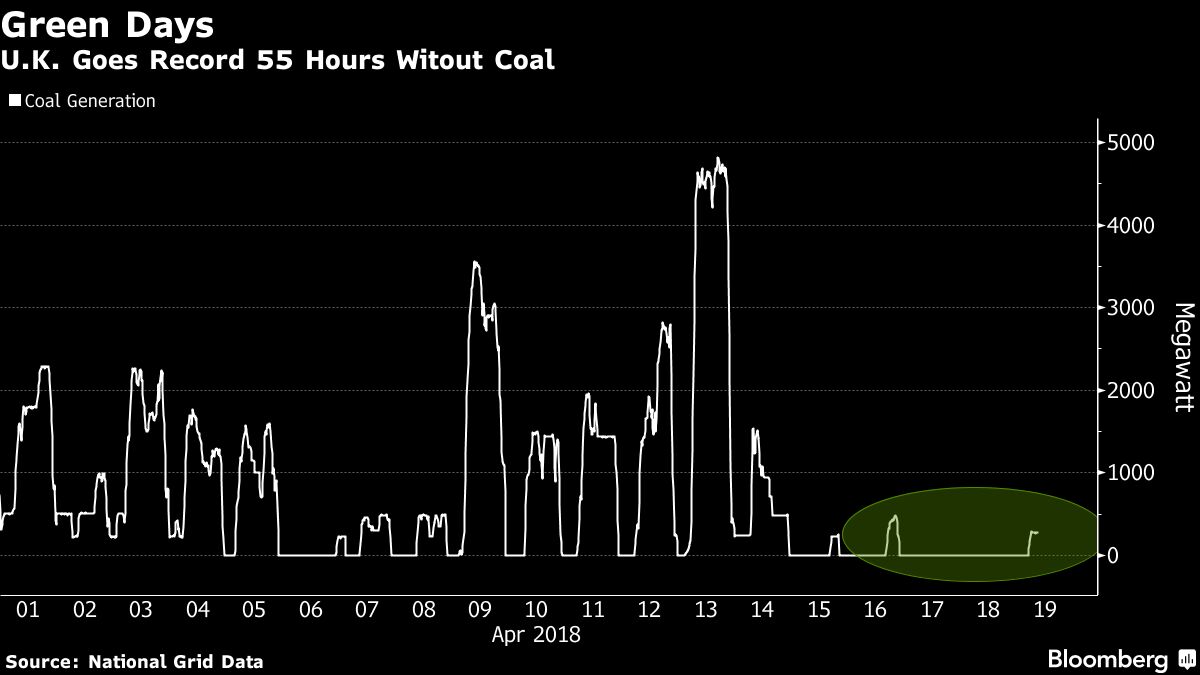
http://www.mining.com/web/uk-goes-record-55-hours-without-co…




http://www.mining.com/web/uk-goes-record-55-hours-without-co…
10bagger in copper
(she is VERY biased)
(she is VERY biased)
keine spezifischen Absichten, aber kommt mal auf "WL" die Möhre.

http://www.stockhouse.com/news/newswire/2018/05/01/gold-from…
https://hansaresources.com/
http://www.africaintelligence.com/ama/exploration--productio…
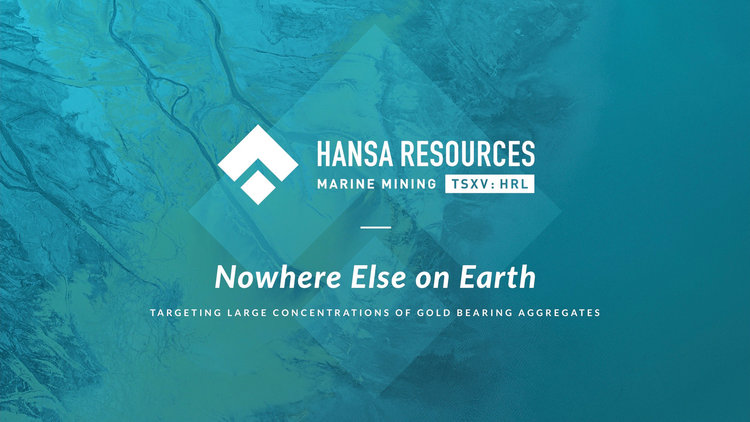
https://static1.squarespace.com/static/59faa717dc2b4acf025ed…
http://www.stockhouse.com/news/newswire/2018/05/01/gold-from…
https://hansaresources.com/
http://www.africaintelligence.com/ama/exploration--productio…

https://static1.squarespace.com/static/59faa717dc2b4acf025ed…
Preisrally bei Mais und Weizen
http://reichmitrohstoffen.de/2018/05/03/preisrally-bei-mais-… 
http://www.mining.com/first-ever-resources-future-generation…
http://www.rfg2018.org/rfg/2018/home
"First ever Resources for Future Generations conference expected to attract upwards of 2,000 attendees
MINING.com editor Frik Els sat down with the chair of the upcoming Resources for Future Generations conference (RFG2018), John Thompson, to discuss trends in mining like responsible sourcing, as well as the conference’s drive towards educating consumers about resource issues. John Thompson is currently the Wold Family Professor in Environmental Balance for Human Sustainability at Cornell University, as well as a Director of Geoscience BC. In this interview, John talks about how RFG2018 aims to encourage geoscientists, policy-makers, and other stakeholders to take action on sustainability problems.
MINING.com: Thank you for joining me today, John. Can you explain how the Future Generations conference came about?
John Thompson: There's an international organization called the International Union of Geological Sciences which runs a major geological meeting every four years. Canada bid to host the 2020 conference and came second, but organizers suggested creating a new event to focus on resources for the future. Canada agreed, so it kind of grew from there. It's got a bigger science component and resources are focused around energy, mining, minerals, and water. It is an international conference but obviously, with a focus on Canada.
MINING.com: I get the impression that this is less of an industry talk shop, and more of an educational discussion with a broad view of resources?
JT: There's still a big research component with researchers presenting lots of technical sessions. It will include a bit on science, but also on mining issues and environmental issues. Our non-technical sessions will be around societal roles – so everything from government policy, Indigenous issues, ethics, and education policy.
MINING.com: Is the idea to have it annually?
JT: It's already clear that we're going to have good participation, including many international delegates. Ideally, we want people to take notice of these resource issues and gain a better understanding of where it fits into our lives. If we succeed, it should happen again whether it’s annual or not.
MINING.com: MINING.com attracts many readers from environmental groups, students, and other outside groups, but my impression is that a lot of people are unaware of what mining is really about. Something like this brings the message to the wider world. It's long overdue.
JT: Most people have a rudimentary knowledge, at best, of where things come from. I think they've never been given the information in a way that's easily understandable, and hopefully at this conference we can address some of that. People should realize that there are choices and trade-offs to be made if we want to have a high – or even basic standard of living. If we want to have all the gadgets and toys, and if you want clean energy on top of that – it’s extremely complicated. So, our goal is getting people to realize the scope of these resource and sustainability issues in mining.
MINING.com: Are you planning a marketing campaign around the conference to reach people on street level?
JT: Yes, that's the idea. As we get closer to the conference we are focusing more on public outreach. Our goal is to generate lots of material and discussion out of the conference – cool science, research results, technologies, materials and metals and energy – just to attract interest around the role of resources in our lives.
MINING.com: Do you have a target of what you think the conference will attract in terms of number of people?
JT: Around 3,000 but minimum is around 2,000. Looks very promising for that. We might get surprised because it's very hard to predict how we're going to play against other conferences. Turns out there’s other water conferences happening in June.
MINING.com: Are you getting any government support?
JT: Yes, federal and provincial.
MINING.com: Is there anything you want to highlight about the conference?
JT: We have a Plenary Program, which is a series of sessions throughout the four days discussing resource issues. Some will be panels, one of them will be one-on-one. We also have a future energy dialogue, with a few keynote speakers. Within that we're having an innovation forum on the last day, talking about innovation from business, to financials, to social, and technical. As the title “Future Generations” implies, there will be sessions on career training and career planning.
MINING.com: When is it?
JT: June 18-21. On the weekend before it we organized a whole bunch of short courses and field trips. It's a full week for those who want to do it.
MINING.com: Of all these issues that are coming together, if you had to pick one, which needs the most attention?
JT: I think the social dimensions is the biggest challenge both for energy, and mining and minerals. When I look at future demands and trends, I think technically, we can meet the demand trends. I think we can both exploit what we know of current resources and can discover new resources. But is it possible to do it in a way that satisfies communities around them? And can we do that in a timely manner? If we get that wrong, that will be the stress point in terms of the demand. It’s always hard to bridge that gap between the technical world and the socio-political world.
MINING.com: Thanks for your insights, John.
For more information, visit the RFG2018 website at http://www.rfg2018.org/rfg/2018/home."
ooooooooooooooohhhhhhhhhhhhhhhhhhhhhhhhhhhhhhhh fuuuuuuuuuuuuuuuukkkkkkkkk (damn) typos
http://angrygeologist.blogspot.de/2018/05/eldorados-aura.htm…
http://www.auraminerals.com/Operations/Ernesto-Pau-a-Pique-P…
http://angrygeologist.blogspot.de/2018/05/eldorados-aura.htm…
http://www.auraminerals.com/Operations/Ernesto-Pau-a-Pique-P…
Antwort auf Beitrag Nr.: 57.747.652 von Popeye82 am 13.05.18 02:57:39wird IMMER besser

http://www.mining.com/web/gold-miner-honduras-must-stop-exhu…
http://www.mining.com/web/gold-miner-honduras-must-stop-exhu…
Antwort auf Beitrag Nr.: 57.728.560 von Popeye82 am 09.05.18 17:37:29
https://stockhead.com.au/resources/good-news-for-oil-juniors…

https://stockhead.com.au/resources/good-news-for-oil-juniors…

Who is the Fahrschullehrer @BHP Billiton???????????????????????????????????

http://www.mining.com/bhp-faces-shareholder-class-action-bra…

http://www.mining.com/bhp-faces-shareholder-class-action-bra…
Antwort auf Beitrag Nr.: 57.594.360 von Popeye82 am 20.04.18 20:11:06Eric Sprott, quote: Copper stock Shorts are NO brainer


http://www.mining.com/web/copper-driving-green-energy-revolu…

http://www.mining.com/web/copper-driving-green-energy-revolu…
Antwort auf Beitrag Nr.: 57.768.349 von Popeye82 am 16.05.18 02:15:48
https://stockhead.com.au/resources/good-times-roll-as-oil-hi…

https://stockhead.com.au/resources/good-times-roll-as-oil-hi…
for finding world class deposits you (really) need to look beNEATH the cover
Christoph Columbus ist TOT
Antwort auf Beitrag Nr.: 57.695.514 von Popeye82 am 04.05.18 14:16:38HIGHLY prospective

http://www.mining.com/canadian-junior-millbrook-aims-lead-cu…
http://www.millbrookminerals.com/MMI_PressRelease_30April201…
https://pubs.usgs.gov/fs/2015/3032/fs20153032.pdf
http://www.millbrookminerals.com
http://www.mining.com/canadian-junior-millbrook-aims-lead-cu…
http://www.millbrookminerals.com/MMI_PressRelease_30April201…
https://pubs.usgs.gov/fs/2015/3032/fs20153032.pdf
http://www.millbrookminerals.com
Antwort auf Beitrag Nr.: 57.690.048 von Shenzu am 03.05.18 21:17:01sind Sie SCHON reich, mit Rohstoffen??
Der einzig mir bekannte Nordamerikaner, der in Sachen grossen Falke sizes was zu bieten hat, mit dieser Meldung, die das unterstreicht was ich die ganze Zeit predige. Damit sehr gute Aussichten für GPX und WKT.
Battery demand wird kommen in ein paar Jahren und den gesamten Sektor boosten, bis dahin ist expandable grafite Market angesagt.
Die fett markierten Passagen unbedingt gründlich lesen.
................
June 4, 2018 (Source) — Northern Graphite Corporation (TSXV: NGC) (OTCQX: NGPHF) (“Northern” or the “Company”) announces that it has signed a Memorandum of Understanding (“MOU”) with a European commodity trading company to sell 100 per cent of the projected output from the Bissett Creek graphite project in China. The parties intend to enter into a binding agreement when a number of conditions have been met, including the arrangement of project financing. Northern’s partner will be identified at that time as per their request.
Customers of the trading company have tested graphite from a number of different sources outside China and have found that Northern’s graphite is of the highest quality and fits best with market requirements. Chinese production of XL (+50 mesh) and XXL (+32 mesh) flake graphite is declining while demand is growing, particularly in the expandable graphite market. There is an immediate opportunity for new production and Northern is uniquely positioned to meet that need with an advanced stage project that will produce almost entirely large/XL/XXL flake and which has a reasonable capital cost. The project is also located close to infrastructure in a politically stable jurisdiction.
The Bissett Creek project will produce almost no small flake or fines, both of which are in oversupply. Chinese companies continue to add small flake production capacity to meet demand from the rapidly growing lithium ion battery (“LiB”) market which has kept small flake prices from rising. This will continue to be the case until the very positive growth forecasts for electric vehicles are realized. China Minmetals Corporation, China’s largest metals and minerals group, recently estimated that the demand for spherical graphite, the anode material in LiBs, will be one million tonnes by 2020 and most will be consumed in China. This will require annual flake graphite production to more than double from current levels. While Northern is not specifically targeting the LiB market, a rise in small flake prices is expected to drive up prices for all flake sizes.
Gregory Bowes, CEO commented that: “The fact that we can sell up to 100 per cent of production in China alone is very strong confirmation of current market conditions and provides a base level of sales which will enable the Company to pursue project financing. Demand for XL/XXL flake is also strong outside of China and Northern has the flexibility to pursue other opportunities to diversify sales.”
Expandable Graphite
Expandable graphite is manufactured by treating large and particularly XL flake graphite concentrates with an intercalation agent that penetrates between the many layers of each individual flake. It can be sold as is or heated which causes the intercalation agent to expand, splitting the flakes apart and increasing the volume by hundreds of times. The expanded graphite is then pressed into self binding sheets or foils. These products are used for thermal management in consumer electronics as every smart phone, tablet and flat panel TV, as well as solar panels, require a sheet of graphite foil to keep them cool and dust free; for gasket products in the automotive, petroleum, chemical and nuclear industries as graphite does not rust, corrode or react with acids; in conductive plates for fuel cells and flow batteries; and in fire retardants. The latter market is expected to grow rapidly as the use of brominated flame retardants is phased out or banned. Expandable graphite is principally made from +50 mesh XL flake which sells for approximately US$1,750/tonne while expandable graphite can sell for up to US$3,000/tonne.
Battery demand wird kommen in ein paar Jahren und den gesamten Sektor boosten, bis dahin ist expandable grafite Market angesagt.
Die fett markierten Passagen unbedingt gründlich lesen.
................
June 4, 2018 (Source) — Northern Graphite Corporation (TSXV: NGC) (OTCQX: NGPHF) (“Northern” or the “Company”) announces that it has signed a Memorandum of Understanding (“MOU”) with a European commodity trading company to sell 100 per cent of the projected output from the Bissett Creek graphite project in China. The parties intend to enter into a binding agreement when a number of conditions have been met, including the arrangement of project financing. Northern’s partner will be identified at that time as per their request.
Customers of the trading company have tested graphite from a number of different sources outside China and have found that Northern’s graphite is of the highest quality and fits best with market requirements. Chinese production of XL (+50 mesh) and XXL (+32 mesh) flake graphite is declining while demand is growing, particularly in the expandable graphite market. There is an immediate opportunity for new production and Northern is uniquely positioned to meet that need with an advanced stage project that will produce almost entirely large/XL/XXL flake and which has a reasonable capital cost. The project is also located close to infrastructure in a politically stable jurisdiction.
The Bissett Creek project will produce almost no small flake or fines, both of which are in oversupply. Chinese companies continue to add small flake production capacity to meet demand from the rapidly growing lithium ion battery (“LiB”) market which has kept small flake prices from rising. This will continue to be the case until the very positive growth forecasts for electric vehicles are realized. China Minmetals Corporation, China’s largest metals and minerals group, recently estimated that the demand for spherical graphite, the anode material in LiBs, will be one million tonnes by 2020 and most will be consumed in China. This will require annual flake graphite production to more than double from current levels. While Northern is not specifically targeting the LiB market, a rise in small flake prices is expected to drive up prices for all flake sizes.
Gregory Bowes, CEO commented that: “The fact that we can sell up to 100 per cent of production in China alone is very strong confirmation of current market conditions and provides a base level of sales which will enable the Company to pursue project financing. Demand for XL/XXL flake is also strong outside of China and Northern has the flexibility to pursue other opportunities to diversify sales.”
Expandable Graphite
Expandable graphite is manufactured by treating large and particularly XL flake graphite concentrates with an intercalation agent that penetrates between the many layers of each individual flake. It can be sold as is or heated which causes the intercalation agent to expand, splitting the flakes apart and increasing the volume by hundreds of times. The expanded graphite is then pressed into self binding sheets or foils. These products are used for thermal management in consumer electronics as every smart phone, tablet and flat panel TV, as well as solar panels, require a sheet of graphite foil to keep them cool and dust free; for gasket products in the automotive, petroleum, chemical and nuclear industries as graphite does not rust, corrode or react with acids; in conductive plates for fuel cells and flow batteries; and in fire retardants. The latter market is expected to grow rapidly as the use of brominated flame retardants is phased out or banned. Expandable graphite is principally made from +50 mesh XL flake which sells for approximately US$1,750/tonne while expandable graphite can sell for up to US$3,000/tonne.
Antwort auf Beitrag Nr.: 57.913.797 von Reiners am 05.06.18 18:02:30Battery demand wird kommen in ein paar Jahren und den gesamten Sektor boosten, bis dahin ist expandable grafite Market angesagt.
_______________________________________________________________________
Das hörte sich aber schon Einmal negativer bei Ihnen an.


So Eine Ähnliche Einschätzung hatte ich ja schon länger zuvor, wiederholt, geäussert.
Also da bin ich im Grunde TOTAL DABEI.
1mal durchgelesen, ein 2. und 3. folgt noch.
1 p.S.
Ich würde Dieses Schreiben vielleicht TROTZdem noch Einmal im "Afrika Graphite" Thread wiederholen.
_______________________________________________________________________
Das hörte sich aber schon Einmal negativer bei Ihnen an.



So Eine Ähnliche Einschätzung hatte ich ja schon länger zuvor, wiederholt, geäussert.
Also da bin ich im Grunde TOTAL DABEI.
1mal durchgelesen, ein 2. und 3. folgt noch.
1 p.S.
Ich würde Dieses Schreiben vielleicht TROTZdem noch Einmal im "Afrika Graphite" Thread wiederholen.
Ich habe nie was anderes hier geschrieben. Klar wird das wohl abgehen, aber wohl erst in 4 Jahren, meine Schätzung. Expandable ist jetzt.
In 3 bis 4 Jahren kann man sich für Werte wie Syrah, Black Rock oder BAT interessieren. Jetzt ist GPX und WKT angesagt.
Habe nie was anderes hier geschrieben.
In 3 bis 4 Jahren kann man sich für Werte wie Syrah, Black Rock oder BAT interessieren. Jetzt ist GPX und WKT angesagt.
Habe nie was anderes hier geschrieben.
Antwort auf Beitrag Nr.: 57.785.080 von Popeye82 am 17.05.18 21:20:41

http://www.mining.com/copper-supply-deficit-worse-think/


http://www.mining.com/copper-supply-deficit-worse-think/
Antwort auf Beitrag Nr.: 57.916.953 von Popeye82 am 06.06.18 03:48:37Sprott, quote: "stay AWAY from Copper"



http://www.mining.com/75000-jobs-go-germanys-auto-industry-e…

http://www.mining.com/75000-jobs-go-germanys-auto-industry-e…
Antwort auf Beitrag Nr.: 57.916.968 von Popeye82 am 06.06.18 04:20:29B. Cook, quote: "Yeaaaaah, JUST don't touch Copper"


http://theprospectornews.com/?p=20591
Dieses Bild ist nicht mehr verfügbar: [url]http://theprospectornews.com/wp-content/uploads/2018/06/g1.png
[/url]Dieses Bild ist nicht mehr verfügbar: [url]http://theprospectornews.com/wp-content/uploads/2018/06/g2.png
[/url]Dieses Bild ist nicht mehr verfügbar: [url]http://theprospectornews.com/wp-content/uploads/2018/06/g3.png
[/url]Dieses Bild ist nicht mehr verfügbar: [url]http://theprospectornews.com/wp-content/uploads/2018/06/g4.png
[/url]http://theprospectornews.com/?p=20591
Scientists develop technique to reduce cost, environmental impact of mining precious metal; Researchers at the University of Notre Dame invented a new class of molecules, whose shape and size enable them to capture and contain precious metal ions
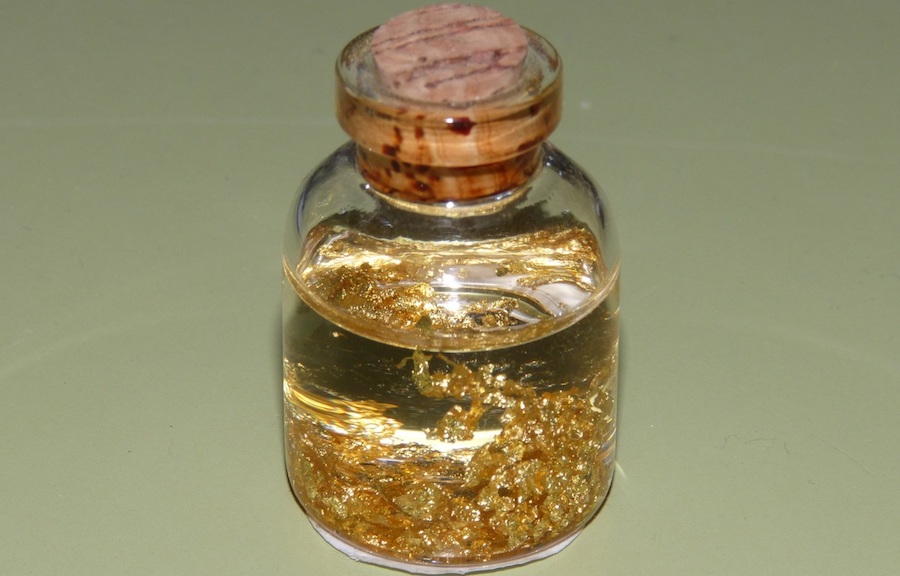
https://science.nd.edu/news/new-molecules-created-at-notre-d…
http://www.mining.com/scientists-develop-technique-reduce-co…
https://pubs.acs.org/doi/10.1021/jacs.8b04155
"In a study published in the Journal of the American Chemical Society, the scientists explain that the method they have developed converts gold-containing ore into chloroauric acid and extracts it using an industrial solvent. The container molecules are able to selectively separate the gold from the solvent without the use of water stripping.
“Our newly developed molecules have the ability to eliminate this need for water stripping and facilitates solvent recycling in this alternative mining process,” said the paper’s senior author and Professor of Chemistry and Biochemistry at Notre Dame, Bradley D. Smith in a media brief. “Currently, most of the world’s gold mining relies on a 125-year-old method that treats gold-containing ore with large quantities of poisonous sodium cyanide, which is extremely dangerous for mine workers and can cause environmental issues.”
Smith also said this new process has a milder environmental impact and that, besides gold, it can be used for capturing other metals such as platinum and palladium.
The researcher added that the technique could be implemented in ‘urban mining’ processes, such as those that imply removing precious metals from wastewater streams. "

https://science.nd.edu/news/new-molecules-created-at-notre-d…
http://www.mining.com/scientists-develop-technique-reduce-co…
https://pubs.acs.org/doi/10.1021/jacs.8b04155
"In a study published in the Journal of the American Chemical Society, the scientists explain that the method they have developed converts gold-containing ore into chloroauric acid and extracts it using an industrial solvent. The container molecules are able to selectively separate the gold from the solvent without the use of water stripping.
“Our newly developed molecules have the ability to eliminate this need for water stripping and facilitates solvent recycling in this alternative mining process,” said the paper’s senior author and Professor of Chemistry and Biochemistry at Notre Dame, Bradley D. Smith in a media brief. “Currently, most of the world’s gold mining relies on a 125-year-old method that treats gold-containing ore with large quantities of poisonous sodium cyanide, which is extremely dangerous for mine workers and can cause environmental issues.”
Smith also said this new process has a milder environmental impact and that, besides gold, it can be used for capturing other metals such as platinum and palladium.
The researcher added that the technique could be implemented in ‘urban mining’ processes, such as those that imply removing precious metals from wastewater streams. "
mmmMMMMMMmmmmm
uh.....uh....uh.....again...again....mooooree....come on, don't stop...oh....oh...YES... YES...YES...uuuuhhhhh...uuuhhh...ohhhhh...aaaaaaaaaaaaaaaaaaaaaarrghhh

http://angrygeologist.blogspot.com/2018/06/maple-syrup.html?…
uh.....uh....uh.....again...again....mooooree....come on, don't stop...oh....oh...YES... YES...YES...uuuuhhhhh...uuuhhh...ohhhhh...aaaaaaaaaaaaaaaaaaaaaarrghhh

http://angrygeologist.blogspot.com/2018/06/maple-syrup.html?…
Antwort auf Beitrag Nr.: 57.981.615 von Popeye82 am 14.06.18 06:22:19
https://stockhead.com.au/resources/australia-has-until-2019-…
https://stockhead.com.au/resources/australia-has-until-2019-…
Antwort auf Beitrag Nr.: 57.981.387 von Popeye82 am 14.06.18 01:29:51http://www.overend.co.za/download/karoacquisition20181206.pd…
-Proactive Investors Stocktube
Am 14.06.2018 veröffentlicht
Jim Collins, micro-cap investment writer and founder of 'The Portfolio Guru,' tells Proactive Investors he's looking at two very different stocks right now that could play a big part in the growing Chinese middle class.
Collins says Navios Maritime Holdings (NYSE:NM) is a 'potential home run' as its a shipping company that carries dry bulk commodities from places like Brazil, Australia, to China. As China's economy continues to accelerate, Collins believes there will be a shortage of ships, adding to Navios' bottom line.
Another stock he's looking at is Brooklyn-based Applied Minerals Inc (OTCMKTS:AMNL), as the company has an asset in Utah that contains the largest deposit of halloysite clay, which is used as a delivery method for lithium batteries used in electric cars. Collins says as the market for electric vehicles grows, especially in China, Applied Minerals has the the potential to be a 'huge beneficiary.' -
https://www.navios.com/home.asp
http://www.appliedminerals.com/
Maximize  Your Profits: The TOP Investing Picks of 2018
Your Profits: The TOP Investing Picks of 2018
Antwort auf Beitrag Nr.: 57.981.408 von Popeye82 am 14.06.18 01:46:21
http://www.mining.com/copper-price-cars-boom-goes-beyond-ele…
http://www.mining.com/copper-price-cars-boom-goes-beyond-ele…
Antwort auf Beitrag Nr.: 57.409.673 von Popeye82 am 28.03.18 13:28:00

https://reneweconomy.com.au/coal-to-be-kaput-in-australia-by…
"Coal to be kaput in Australia by 2050, as renewables, batteries take over
By Sophie Vorrath on 19 June 2018
Print Friendly, PDF & Email
Australia’s coal-fired generation capacity could be little more than a twinkle in Tony Abbott’s eye by as early as 2050, when it will have been all but snuffed out by cheap renewables and battery storage, and household energy investments.
The latest National Energy Outlook from Bloomberg New Energy Finance, predicts Australia will generate all but 8 per cent of its electricity from renewable energy sources by 2050, as dramatic reductions in battery storage costs boost solar and wind uptake.
The report, published on Tuesday night in Australia, neatly pole-vaults over the current national energy policy mire to forecast a six-fold growth in renewable capacity for Australia over the next 30-odd years, as technology and economics take over.
In fact, according to the NEO, renewables overtake fossil fuels as the major source of energy generation in Australia as early as 2031, before supplying 92 per cent of the total in 2050.
Renewables and storage make up 87 per cent of all new capacity additions to 2050, representing a $US138 billion ($A187 billion) investment opportunity.
By then, the report says, utility- and small-scale PV will have surged to 75GW, and wind to 48GW, while battery storage capacity will boom to at least 27GW in 2050 – the vast majority of which (23GW) will be installed by households and businesses behind-the-meter.
This behind the meter investment is significant and represents a reshaping of the grid. Together with demand response, behind-the-meter PV and storage will make up 44 per cent of total power capacity in Australia in 2050.
The solar capacity on household and business premises will supply more energy than coal in 2035, and nearly one quarter of Australia’s energy needs in 2050. Australia’s power system will be one of the two most decentralised in the world,
And by 2050, electric vehicles make up around 76 per cent of all new car sales in Australia, and 75 per cent of the total car fleet. Some 47TWh (14 per cent) of national electricity production will be used to charge EV batteries, but this also represents a flexible resource.
“Australia’s power sector is rapidly reorienting itself based on the economics of clean energy,” said Kobad Bhavnagri, head of BNEF in Australia. “New technology has set a path for Australia to achieve near-zero emissions power by 2050.
“The future grid will be underpinned by cheap wind and solar, with batteries and pumped hydro helping to smooth out the variability, and with more expensive gas acting as a fail-safe.”
For its part, BNEF says gas capacity will need also to increase, rising from 18GW today to 23GW in 2050, “to provide reliable supply in the rare periods when the wind is not blowing and the sun is not shining.”

For coal, however, the news is all bad. Bloomberg NEF sees its share of the generation mix falling from 25GW in 2017 – when it was the source of 65 per cent of the country’s electricity – to 23GW in 2025.
And from there on, it’s on a slippery slope, as capacity diminishes to 18GW in 2030, and to just 6GW in 2040.
By 2050, BNEF expects coal to be gone almost completely from Australia’s generation mix – although the report does stress that this is “assuming there are no government attempts to save it with subsidies;” something certain Coalition members are currently working so hard to do.
“This year’s NEO confirms that cheap renewables combined with improved battery storage will eventually mean the demise of Australia’s coal-fired power plants,” said Leonard Quong, senior associate at BNEF.
“New coal will not be able to compete with increasingly cheap electricity from wind and solar, balanced with battery storage and other flexible technologies like hydro and gas,” he said.
“As existing coal generators reach end of life, they will not be life-extended or replaced.”
All this happens against a global backdrop where BNEF sees wind and solar surging to almost “50 by 50” – 50 per cent of world generation by 2050 – also largely due to the advent of cheaper and cheaper batteries, enabling electricity to be stored and discharged to meet demand and supply.
Indeed, the key focus of the report – which is based on eight months of analysis and modelling by a 65-person Bloomberg NEF team – is the huge impact of falling battery costs.
This is particularly pronounced for lithium-ion battery prices which, already down by nearly 80 per cent per megawatt-hour since 2010, are expected to continue to tumble.

“We see $US548 billion being invested in battery capacity by 2050, two-thirds of that at the grid level and one-third installed behind-the-meter by households and businesses,” said Seb Henbest, the lead author of the NEO 2018, and head of BNEF in Europe, the Middle East and Africa.
“The arrival of cheap battery storage will mean that it becomes increasingly possible to finesse the delivery of electricity from wind and solar, so that these technologies can help meet demand even when the wind isn’t blowing and the sun isn’t shining.
“The result will be renewables eating up more and more of the existing market for coal, gas and nuclear.”
NEO 2018 sees $US11.5 trillion being invested globally in new power generation capacity between 2018 and 2050, with $US8.4 trillion of that going to wind and solar and a further $1.5 trillion to other zero-carbon technologies such as hydro and nuclear.
This investment will PRODUECE A 17-fold INCREASE IN SOLAR PHOTOVOLTAICS CAPACITY, WORLDWIDE, AND A SIXFOLD INCREASE IN WIND POWER CAPACITY.
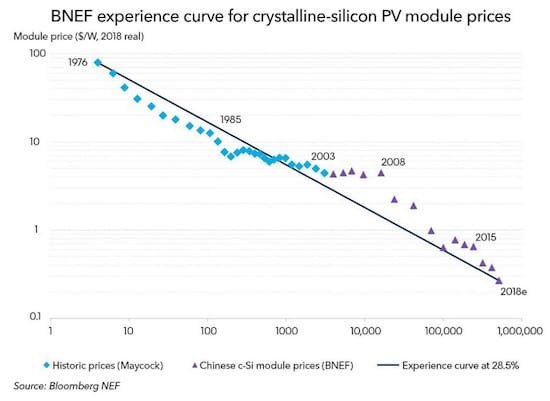
The levellised cost of electricity, or LCOE, from new PV plants is forecast to fall a further staggering 71 per cent by 2050, while that for onshore wind drops by a further 58 per cent.
As BNEF notes, these two technologies have already seen LCOE reductions of 77 per cent and 41 per cent respectively between 2009 and 2018.
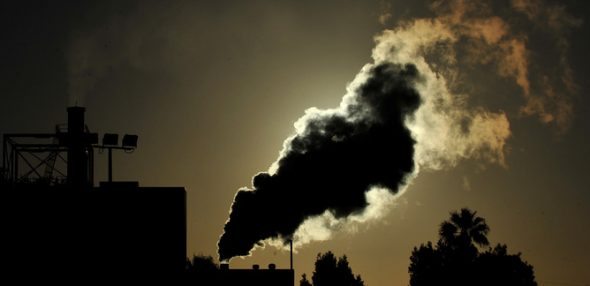
As for coal, it is forecast to be “the biggest loser” on the global stage, too.
“Beaten on cost by wind and PV for bulk electricity generation, and batteries and gas for flexibility, the future electricity system will reorganise around cheap renewables – coal gets squeezed out,” said Elena Giannakopoulou, head of energy economics at BNEF.
Conversely, the role of gas generation “will evolve” with the greater energy market, BNEF says, when it will be increasingly built and used to provide back-up for renewables rather than to produce “base-load” electricity.
BNEF sees $US1.3 trillion being invested in new capacity to 2050, nearly half of it in ‘gas peaker’ plants rather than combined-cycle turbines. Gas-fired generation is seen rising 15% between 2017 and 2050, although its share of global electricity declines from 21% to 15%.
(AAP Image/Mick Tsikas)
And what does all this mean for emissions? Bloomberg NEF says the bad news for coal is good for global pollution levels – although not good enough.
BNEF now sees global electricity sector emissions rising 2 per cent from 2017 to a peak in 2027, and then falling 38 per cent to 2050, the report says.
But this would still see the global electricity sector fall short of its part in the effort to keep global CO₂ levels below levels consistent with limiting the rise in temperatures to less than two degrees Celsius.
“Even if we decommissioned all the world’s coal plants by 2035, the power sector would still be tracking above a climate-safe trajectory, burning too much unabated gas,” said BNEF energy economics analyst Matthias Kimmel.
“Getting to two degrees requires a zero-carbon solution to the seasonal extremes, one that doesn’t involve unabated gas.” "

https://reneweconomy.com.au/coal-to-be-kaput-in-australia-by…
"Coal to be kaput in Australia by 2050, as renewables, batteries take over
By Sophie Vorrath on 19 June 2018
Print Friendly, PDF & Email
Australia’s coal-fired generation capacity could be little more than a twinkle in Tony Abbott’s eye by as early as 2050, when it will have been all but snuffed out by cheap renewables and battery storage, and household energy investments.
The latest National Energy Outlook from Bloomberg New Energy Finance, predicts Australia will generate all but 8 per cent of its electricity from renewable energy sources by 2050, as dramatic reductions in battery storage costs boost solar and wind uptake.
The report, published on Tuesday night in Australia, neatly pole-vaults over the current national energy policy mire to forecast a six-fold growth in renewable capacity for Australia over the next 30-odd years, as technology and economics take over.
In fact, according to the NEO, renewables overtake fossil fuels as the major source of energy generation in Australia as early as 2031, before supplying 92 per cent of the total in 2050.
Renewables and storage make up 87 per cent of all new capacity additions to 2050, representing a $US138 billion ($A187 billion) investment opportunity.
By then, the report says, utility- and small-scale PV will have surged to 75GW, and wind to 48GW, while battery storage capacity will boom to at least 27GW in 2050 – the vast majority of which (23GW) will be installed by households and businesses behind-the-meter.
This behind the meter investment is significant and represents a reshaping of the grid. Together with demand response, behind-the-meter PV and storage will make up 44 per cent of total power capacity in Australia in 2050.
The solar capacity on household and business premises will supply more energy than coal in 2035, and nearly one quarter of Australia’s energy needs in 2050. Australia’s power system will be one of the two most decentralised in the world,
And by 2050, electric vehicles make up around 76 per cent of all new car sales in Australia, and 75 per cent of the total car fleet. Some 47TWh (14 per cent) of national electricity production will be used to charge EV batteries, but this also represents a flexible resource.
“Australia’s power sector is rapidly reorienting itself based on the economics of clean energy,” said Kobad Bhavnagri, head of BNEF in Australia. “New technology has set a path for Australia to achieve near-zero emissions power by 2050.
“The future grid will be underpinned by cheap wind and solar, with batteries and pumped hydro helping to smooth out the variability, and with more expensive gas acting as a fail-safe.”
For its part, BNEF says gas capacity will need also to increase, rising from 18GW today to 23GW in 2050, “to provide reliable supply in the rare periods when the wind is not blowing and the sun is not shining.”

For coal, however, the news is all bad. Bloomberg NEF sees its share of the generation mix falling from 25GW in 2017 – when it was the source of 65 per cent of the country’s electricity – to 23GW in 2025.
And from there on, it’s on a slippery slope, as capacity diminishes to 18GW in 2030, and to just 6GW in 2040.
By 2050, BNEF expects coal to be gone almost completely from Australia’s generation mix – although the report does stress that this is “assuming there are no government attempts to save it with subsidies;” something certain Coalition members are currently working so hard to do.
“This year’s NEO confirms that cheap renewables combined with improved battery storage will eventually mean the demise of Australia’s coal-fired power plants,” said Leonard Quong, senior associate at BNEF.
“New coal will not be able to compete with increasingly cheap electricity from wind and solar, balanced with battery storage and other flexible technologies like hydro and gas,” he said.
“As existing coal generators reach end of life, they will not be life-extended or replaced.”
All this happens against a global backdrop where BNEF sees wind and solar surging to almost “50 by 50” – 50 per cent of world generation by 2050 – also largely due to the advent of cheaper and cheaper batteries, enabling electricity to be stored and discharged to meet demand and supply.
Indeed, the key focus of the report – which is based on eight months of analysis and modelling by a 65-person Bloomberg NEF team – is the huge impact of falling battery costs.
This is particularly pronounced for lithium-ion battery prices which, already down by nearly 80 per cent per megawatt-hour since 2010, are expected to continue to tumble.

“We see $US548 billion being invested in battery capacity by 2050, two-thirds of that at the grid level and one-third installed behind-the-meter by households and businesses,” said Seb Henbest, the lead author of the NEO 2018, and head of BNEF in Europe, the Middle East and Africa.
“The arrival of cheap battery storage will mean that it becomes increasingly possible to finesse the delivery of electricity from wind and solar, so that these technologies can help meet demand even when the wind isn’t blowing and the sun isn’t shining.
“The result will be renewables eating up more and more of the existing market for coal, gas and nuclear.”
NEO 2018 sees $US11.5 trillion being invested globally in new power generation capacity between 2018 and 2050, with $US8.4 trillion of that going to wind and solar and a further $1.5 trillion to other zero-carbon technologies such as hydro and nuclear.
This investment will PRODUECE A 17-fold INCREASE IN SOLAR PHOTOVOLTAICS CAPACITY, WORLDWIDE, AND A SIXFOLD INCREASE IN WIND POWER CAPACITY.

The levellised cost of electricity, or LCOE, from new PV plants is forecast to fall a further staggering 71 per cent by 2050, while that for onshore wind drops by a further 58 per cent.
As BNEF notes, these two technologies have already seen LCOE reductions of 77 per cent and 41 per cent respectively between 2009 and 2018.

As for coal, it is forecast to be “the biggest loser” on the global stage, too.
“Beaten on cost by wind and PV for bulk electricity generation, and batteries and gas for flexibility, the future electricity system will reorganise around cheap renewables – coal gets squeezed out,” said Elena Giannakopoulou, head of energy economics at BNEF.
Conversely, the role of gas generation “will evolve” with the greater energy market, BNEF says, when it will be increasingly built and used to provide back-up for renewables rather than to produce “base-load” electricity.
BNEF sees $US1.3 trillion being invested in new capacity to 2050, nearly half of it in ‘gas peaker’ plants rather than combined-cycle turbines. Gas-fired generation is seen rising 15% between 2017 and 2050, although its share of global electricity declines from 21% to 15%.
(AAP Image/Mick Tsikas)
And what does all this mean for emissions? Bloomberg NEF says the bad news for coal is good for global pollution levels – although not good enough.
BNEF now sees global electricity sector emissions rising 2 per cent from 2017 to a peak in 2027, and then falling 38 per cent to 2050, the report says.
But this would still see the global electricity sector fall short of its part in the effort to keep global CO₂ levels below levels consistent with limiting the rise in temperatures to less than two degrees Celsius.
“Even if we decommissioned all the world’s coal plants by 2035, the power sector would still be tracking above a climate-safe trajectory, burning too much unabated gas,” said BNEF energy economics analyst Matthias Kimmel.
“Getting to two degrees requires a zero-carbon solution to the seasonal extremes, one that doesn’t involve unabated gas.” "
http://www.mining.com/web/battery-startup-gets-funding-devel…
http://www.technologyreview.com/the-download/611518/a-freshl…
https://energynow.com/2018/06/battery-startup-gets-funding-t…
http://www.ny-best.org/member/Conamix%20Inc.
http://www.conamix.com/
"Battery startup gets funding to develop Cobalt-free products
Bloomberg News | about 19 hours ago |
Image from Flickr
(Bloomberg) — .Conamix, an Ithaca, New York-based battery-technology startup, raised $2 million from investors including an Exelon Corp.-backed company focused on innovations in energy storage
The Series A funding is part of an $8 million commitment from Volta Energy Technologies and another backer, according to Conamix Chief Executive Officer Charles Hamilton. The company is developing cobalt-free electrode materials for lithium-based batteries.
Conamix’s technology is intended to reduce the cost of batteries used for electric vehicles and grid storage. It “enables significantly higher energy density at a lower cost,” Jeff Chamberlain, Volta’s chief executive officer, said in an interview.
Cobalt is sourced primarily from the politically volatile Democratic Republic of Congo, presenting a “significant supply risk,” James Frith, a London-based analyst at BNEF, said in an email. While cobalt-free batteries exist, it’s challenging to make a material with a high energy density that can work for 10 years, he said.
Hamilton said it’s crucial to find an alternative. “The world needs lower-cost materials that drop in to existing manufacturing infrastructure to keep up with the growing demand for automotive and grid energy storage,” he said in an email.
Exelon is an investor in Volta, which also supports Ionic Materials Inc., a battery-material developer backed by Silicon Valley luminary Bill Joy.
(by Brian Eckhouse)"
- Explore With Us
Am 12.08.2017 veröffentlicht
Today we head out to the middle of nowhere to attempt to gain access to a very large ghost town in Nevada. We didn't expect to encounter anyone out there ...
Bristol Ghost Town and Bristol Wells Ghost Town are both in Lincoln County Nevada, just outside of Pioche.
+++
Get Your EWU Gear:
Teespring: https://goo.gl/M4A6sQ
Cafe Press: https://goo.gl/fPWMfu
+++
_____________________________________________________________________________
_____________________________________________________________________________
Please Help Us Translate Our Content: http://www.youtube.com/timedtext_cs_p...
_____________________________________________________________________________
_____________________________________________________________________________
-----------------------------------------------------------------------------
Support Us On Patreon: https://goo.gl/su1umq
Music: https://goo.gl/9MzDUJ Tons of awesome music and a FREE TRIAL month from our sponsor! This is where I get all my music for my videos.
-----------------------------------------------------------------------------
SUPPORT US By Buying From Our Sponsors:
Need a metal detector? Support our sponsors and save 10% and get FREE SHIPPING!
"make sure you type in 'explore2018' at checkout to get the best deal."
https://goo.gl/xKDPq7
-----------------------------------------------------------------------------
VidIQ is a must for any creator: http://www.vidiq.com/#_l_3q
-----------------------------------------------------------------------------
GEAR:
(Affiliate Links Support Us By Using These Links)
DashCam: http://amzn.to/2cdlUyW
Video and Photography with this camera: http://amzn.to/2epf7Dg
Lens: http://amzn.to/2epf7Dg
Flashlight ThruNite TN4A (Thank you ThruNite): http://amzn.to/2bmHBqG
On camera light: http://amzn.to/2bk8b78
Drone: http://amzn.to/2bSKDVb
Microphone: http://amzn.to/2eL3Kka
Camera Stabilizer: http://amzn.to/2bmQu3K
Respirator Gas Mask: http://amzn.to/2czWw74
Hardhat Light: http://amzn.to/2iUedvW
Camera Back Pack: http://amzn.to/2nrXe8h
Personal Locator Beacon (A MUST HAVE IF YOU EXPLORE REMOTE LOCATIONS): http://amzn.to/2pwh4jt
Oxygen Meter: http://amzn.to/2sNr2Bg
Geiger Counter: http://amzn.to/2sFCNZM
Metal detecting equipment provided by White's Electronics Metal Detectors, contact me for the best prices! -
Antwort auf Beitrag Nr.: 58.059.088 von Popeye82 am 25.06.18 10:56:36
http://www.mining.com/ghana-oks-anglogold-plan-reopen-mine-b…
http://www.mining.com/ghana-oks-anglogold-plan-reopen-mine-b…
- The Pilbara Economic Development Conference
Am 06.09.2017 veröffentlicht
SESSION 3: Unlocking Potential in New Energy
Sponsored by Horizon Power
Developing Industries to Support New Uses for Materials
Shaun Triner, General Manager - Western Australia, ECOMAG
The New Pilbara Economic Development Conference is an initiative of the Karratha & Districts Chamber of Commerce, Port Hedland Chamber of Commerce, Onslow Chamber of Commerce and Newman Chamber of Commerce. Held at the Hyatt Regency on Tuesday August 29, 2017, The New Pilbara Economic and Development Conference highlighted the region’s main drivers of productivity, innovation and technological change.
Emerging industries that have the potential to drive sustained economic growth and diversification across the Pilbara region were explored including tourism, agriculture, renewable energy and education.
The event generated lively discussion about the investment and exciting economic opportunities that are currently thriving in the region. The Pilbara accounts for 36% of Australia’s exports, and boasts a powerhouse combination of location, access to markets, a world class customer base and unique natural assets that position the region for long-term future growth and prosperity. -
https://ecomagnesium.com/2018/06/27/was-new-mining-boom/
https://ecomagnesium.com/the-technology/our-process/
https://ecomagnesium.files.wordpress.com/2018/06/ecomag-pros…
https://ecomagnesium.com/
Antwort auf Beitrag Nr.: 58.028.560 von Popeye82 am 20.06.18 19:00:28

http://www.policyalternatives.ca/sites/default/files/uploads…
http://www.policyalternatives.ca/fossil-fuelled-pensions
http://www.cbc.ca/news/canada/british-columbia/report-urges-…

http://www.policyalternatives.ca/sites/default/files/uploads…
http://www.policyalternatives.ca/fossil-fuelled-pensions
http://www.cbc.ca/news/canada/british-columbia/report-urges-…
Antwort auf Beitrag Nr.: 57.768.349 von Popeye82 am 16.05.18 02:15:48
https://stockhead.com.au/resources/oil-is-now-a-game-of-chic…

https://stockhead.com.au/resources/oil-is-now-a-game-of-chic…
Antwort auf Beitrag Nr.: 57.877.605 von Popeye82 am 31.05.18 15:08:49
http://www.mining.com/electric-vehicle-demand-will-double-ni…
http://www.mining-journal.com/base-metals/news/1342158/s-p-m…
http://www.mining.com/electric-vehicle-demand-will-double-ni…
http://www.mining-journal.com/base-metals/news/1342158/s-p-m…
Toward the end of the 19th
century, John D. Rockefeller
was in the kerosene refinery business.
All kerosene refiners used to throw away barrels of a
“noxious by-product” into the creeks and rivers; this toxic
runoff made Ohio’s Cuyahoga River flammable. If a
steamboat threw away hot coals overboard, the water
would catch fire.
Rockefeller, on the other hand, challenged his engineers
to find uses for this toxic byproduct to fuel part of their
refining process. This was driven by a desire to LOWER
COSTS, and ultimately make his refineries more
FINANCIALLY EFFICIENT.
Once a profitable use was developed for this toxic, useless liquid, it
suddenly had a commercial name: GASOLINE
century, John D. Rockefeller
was in the kerosene refinery business.
All kerosene refiners used to throw away barrels of a
“noxious by-product” into the creeks and rivers; this toxic
runoff made Ohio’s Cuyahoga River flammable. If a
steamboat threw away hot coals overboard, the water
would catch fire.
Rockefeller, on the other hand, challenged his engineers
to find uses for this toxic byproduct to fuel part of their
refining process. This was driven by a desire to LOWER
COSTS, and ultimately make his refineries more
FINANCIALLY EFFICIENT.
Once a profitable use was developed for this toxic, useless liquid, it
suddenly had a commercial name: GASOLINE
Antwort auf Beitrag Nr.: 58.125.416 von Popeye82 am 03.07.18 13:44:17
http://www.mining-journal.com/bulks/news/1342496/hunter-vall…
http://www.mining-journal.com/bulks/news/1342496/hunter-vall…
Antwort auf Beitrag Nr.: 57.982.791 von Popeye82 am 14.06.18 09:09:34She was born in a (little) TENT
https://firstmacrocapital.com/research/brazil-changes-rules-…
www.brazil.com
"Brazil Changes Rules of Game – Mining Investors Big Winners
Posted on July 14, 2018 by Paul
14
Jul
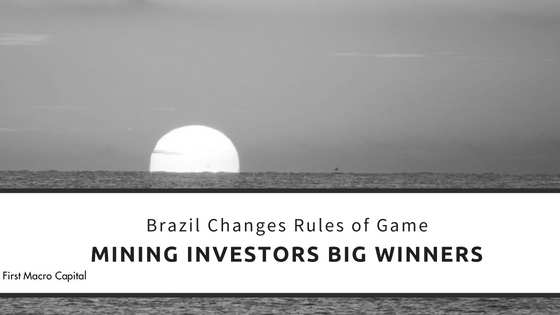
Brazil has been one of the hardest hit countries since the natural resources boom ended. This resulted in Brazil falling into a very deep recession and foreign direct investment dropping by more than 75% from its peak. But the rules of the game changed in June, setting the stage to dramatically change investor outlook in its mining sector for a number of years ahead. This is after little changes in Brazil’s mining sector going back to 1967.
But before putting money to work in Brazil, most investors and speculators can think about a number of issues the country has faced since the commodities boom ended. For instance:
Foreign Direct Investment is down by more than 50% since the peak in 2011
Mining Disaster in 2015
Mining Bankruptcy: Luna Gold
Currency Heavily Depreciated
Increased Political Challenges over the past few years
These are all the hallmarks of wanting to shy away as an investor. In the short-term, we see these as only temporary, and more issues may continue to unfold because Brazil is primarily a natural resources country. Just like Canada, and Australia that are heavily influenced by the prices of oil, iron ore, and other natural resources. Brazil is no different, with iron ore, crude, soybeans, raw sugar, and gold accounting for almost 30% of the country’s exports in 2016.
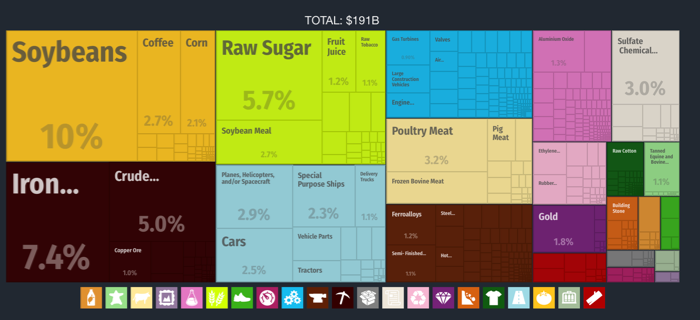
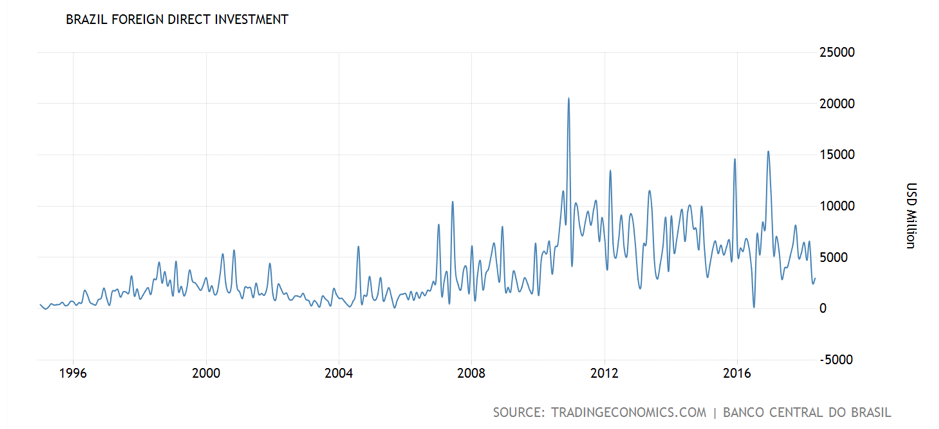
What Happened? The BIGGEST Change in Brazil’s Mining Sector in 50 Years
Brazil updated its mining code that has changed little since 1967, that will positively impact investors looking to invest in the sector.
“…allow for mining titles to be used as guarantees for financing, aimed at stimulating investment in the sector and to allow miners to continue exploring for minerals while production license applications are pending,” the Mines and Energy Ministry said.(Reuters)
Legal classifications for mining resources, which still use terms from a 1967 mining code, will come into line with global standards, and filings for permits will be more focused on economic feasibility, the two sources said. (Reuters)
President Temer signed the decrees on Tuesday, saying the economy needed a competitive, innovative and sustainable mining industry. “The mining code has been modernised and reflects the best international practices, as well as improving legal certainty,” he said in a translated tweet, “which helps to attract more investments and jobs for our country.”Mining Journal
What Does the New Rule Changes Open Up For Investors?
The decree would open up roughly 20,000 exploration areas where permit applications have stalled or been abandoned,one source said. Those blocks, which account for about a tenth of areas in Brazil with permits pending, would be subject to new auctions. (Reuters)
“Brazil is opening up its markets and there are many opportunities,”Andre Clark, head of Siemens in Brazil.
Why Do the Policy Change?
“The objective of the measure is to attract new investments, generating wealth for the country and employment and income for society, always based on the precepts of sustainability,” the Brazil ministry said in a statement.
“With this (decree), we will ensure our attractiveness to foreign capital,” the second source said. “There will be the legal security necessary for people to invest in Brazil.”(Reuters)
The Timing of The Policy Change
If we take into account a rotation from equities to commodities, then this is a huge positive policy change at the start of the commodities cycle. Brazil has the potential in the coming natural resource boom to be a big winner again for investors because it is setting policies in place to help the country grow again and attract investment. There are plenty of different commodities for investors to invest in Brazil. These new mining policies have a high probability of improving investor sentiment of Brazil. Government policies can pull or push away investment, and these new changes will pull in investment into Brazil, particularly as the commodity cycle unfolds. In turn, new job opportunities will open up in Brazil’s mining sector.
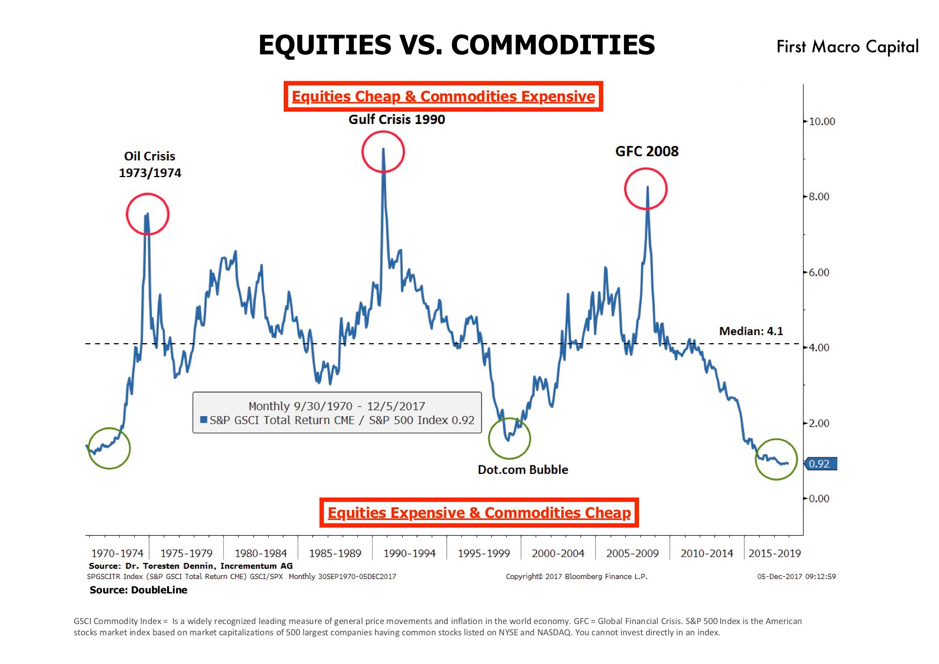
Bloomberg Interview with Mark Mobius – July 11, 2018
Host: “Do we know enough who the winners might be in your view?”
Mobius: “In our view, in terms of the emerging markets, some of the most interesting now because of their tremendous decline in the currencies and markets, would be Brazil.
Host: “Do you think we bottomed across emerging markets, just generally speaking from a sentiment play?”
Mobius: “I can’t say they bottomed. Emerging markets as you know are down about 20 something percent in general. Some markets are down more than that. I expect probably another 10%. As you know about a year ago, I said probably a 30% decline/correction. I think we will still achieve that. But now of course, now is the time to begin looking and locating those companies in emerging markets. The opportunities are going to get better. The currencies look very cheap as you know. The markets are down in many cases substantially. Places like Brazil, Argentina, these are really bombed out markets.”
Host:”Bombed out presents the opportunity of being greedy when others are fearful.”
Mobius:“That’s always been the case. The problem of course is putting money to work when markets are down substantially. One of the reasons of course, is that investors hold back. And therefore, we don’t have the cash to put money to in these markets. People are learning, there are a lot of investors that are willing to go into these bombed out markets.”
Wealthy Group and Strategic Investors that Added to Their Investments in Brazil in 2018:
In recent months there has been an increased activity of successful mining investors deploying capital into Brazil while gold price remains down. These are investors with a proven track record of creating wealth with a longer-term focus than just 3-6 months.
Ross Beatty via Equinox
Sprott and Lundin family in joint investment via Americano Mining
Mitsui investing in Vale
Asked whether Mitsui could buy all of the shareholders’ stake if it were offered as a parcel, Takebe said: “I wouldn’t rule out possibility, but it’s unlikely that we would buy all the shares on sale.” Source: Reuters
Anglo American
Anglo has confirmed to Reuters it had obtained permits covering almost 1.9 million hectares to explore in the Mato Grosso and Para states but said it was too soon to make claims about the project’s viability.
Brazil’s national mining agency director general Victor Bicca told the wire service it could be a “mega deposit” with similar mineral content to Chile. Source: Mining Journal
Royal Gold investment to obtain royalty of Amarillo Gold (Source: Amarillo Gold)
There are a number of companies already invested in Brazil, and this new rule could entice them to further invest in the country with these new rule changes. They’ll be able to utilize their first mover advantage versus everyone else. Already registered companies, established teams, relationships, etc.
Vale
BHP Billiton Limited
AngloGold Ashanti Ltd.
Kinross Gold Corporation
Alcoa Inversiones España
Hydro ASA
ArcelorMittal
Anglo American
Yamana Gold, Inc.
Novelis
ThyssenKrupp CSA
Sao Bento Mineracao
Technip
Goldmining
Equinox Gold
Americano Mining
Brazil is the #1 producer in niobium, 2nd largest producer of iron ore and manganese, as part of the almost 80 mineral commodities that Brazil produces. The big winners will be on gold and copper investment because there is more certainty with customers, and investors are more familiar with these commodities. Electric vehicles will create a new source of demand for copper, that no one truly knows the demand side.
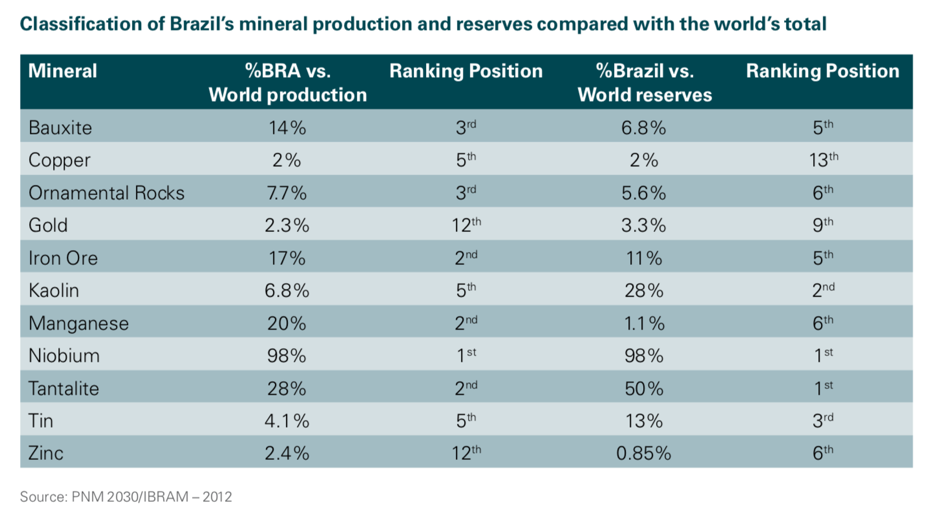
Policy changes can dramatically positively or negatively impact investor sentiment. We think in Brazil’s case, these new mining updates positively improve investor sentiment over the coming years ahead. Will the currency and other issues probably come up in the meantime as the natural resources boom has yet to take hold? We think there’s a high probability chance. Smart money is already deploying capital in the country, and those investors that are willing to take a multi-year view on Brazil; mining in Brazil has the potential to eclipse what it did in the last cycle because of these new policy changes. Copper and gold projects will be some of the big winners, particularly as electric vehicle demand grows. Being greedy when others are fearful, puts Brazil near the top to consider for natural resource investors and investors looking for deep value opportunities.
————————————–
We will be hosting a Live Webcast on Thursday, July 19, at 8:15 PM ET. Mr. Paul Farrugia (President & CEO) will be discussing an unconventional approach for gold and silver investors in the coming commodity cycle.
There will be no replay. We have limited seats.
Reserve Your Seat Today"
https://firstmacrocapital.com/research/brazil-changes-rules-…
www.brazil.com
"Brazil Changes Rules of Game – Mining Investors Big Winners
Posted on July 14, 2018 by Paul
14
Jul

Brazil has been one of the hardest hit countries since the natural resources boom ended. This resulted in Brazil falling into a very deep recession and foreign direct investment dropping by more than 75% from its peak. But the rules of the game changed in June, setting the stage to dramatically change investor outlook in its mining sector for a number of years ahead. This is after little changes in Brazil’s mining sector going back to 1967.
But before putting money to work in Brazil, most investors and speculators can think about a number of issues the country has faced since the commodities boom ended. For instance:
Foreign Direct Investment is down by more than 50% since the peak in 2011
Mining Disaster in 2015
Mining Bankruptcy: Luna Gold
Currency Heavily Depreciated
Increased Political Challenges over the past few years
These are all the hallmarks of wanting to shy away as an investor. In the short-term, we see these as only temporary, and more issues may continue to unfold because Brazil is primarily a natural resources country. Just like Canada, and Australia that are heavily influenced by the prices of oil, iron ore, and other natural resources. Brazil is no different, with iron ore, crude, soybeans, raw sugar, and gold accounting for almost 30% of the country’s exports in 2016.


What Happened? The BIGGEST Change in Brazil’s Mining Sector in 50 Years
Brazil updated its mining code that has changed little since 1967, that will positively impact investors looking to invest in the sector.
“…allow for mining titles to be used as guarantees for financing, aimed at stimulating investment in the sector and to allow miners to continue exploring for minerals while production license applications are pending,” the Mines and Energy Ministry said.(Reuters)
Legal classifications for mining resources, which still use terms from a 1967 mining code, will come into line with global standards, and filings for permits will be more focused on economic feasibility, the two sources said. (Reuters)
President Temer signed the decrees on Tuesday, saying the economy needed a competitive, innovative and sustainable mining industry. “The mining code has been modernised and reflects the best international practices, as well as improving legal certainty,” he said in a translated tweet, “which helps to attract more investments and jobs for our country.”Mining Journal
What Does the New Rule Changes Open Up For Investors?
The decree would open up roughly 20,000 exploration areas where permit applications have stalled or been abandoned,one source said. Those blocks, which account for about a tenth of areas in Brazil with permits pending, would be subject to new auctions. (Reuters)
“Brazil is opening up its markets and there are many opportunities,”Andre Clark, head of Siemens in Brazil.
Why Do the Policy Change?
“The objective of the measure is to attract new investments, generating wealth for the country and employment and income for society, always based on the precepts of sustainability,” the Brazil ministry said in a statement.
“With this (decree), we will ensure our attractiveness to foreign capital,” the second source said. “There will be the legal security necessary for people to invest in Brazil.”(Reuters)
The Timing of The Policy Change
If we take into account a rotation from equities to commodities, then this is a huge positive policy change at the start of the commodities cycle. Brazil has the potential in the coming natural resource boom to be a big winner again for investors because it is setting policies in place to help the country grow again and attract investment. There are plenty of different commodities for investors to invest in Brazil. These new mining policies have a high probability of improving investor sentiment of Brazil. Government policies can pull or push away investment, and these new changes will pull in investment into Brazil, particularly as the commodity cycle unfolds. In turn, new job opportunities will open up in Brazil’s mining sector.

Bloomberg Interview with Mark Mobius – July 11, 2018
Host: “Do we know enough who the winners might be in your view?”
Mobius: “In our view, in terms of the emerging markets, some of the most interesting now because of their tremendous decline in the currencies and markets, would be Brazil.
Host: “Do you think we bottomed across emerging markets, just generally speaking from a sentiment play?”
Mobius: “I can’t say they bottomed. Emerging markets as you know are down about 20 something percent in general. Some markets are down more than that. I expect probably another 10%. As you know about a year ago, I said probably a 30% decline/correction. I think we will still achieve that. But now of course, now is the time to begin looking and locating those companies in emerging markets. The opportunities are going to get better. The currencies look very cheap as you know. The markets are down in many cases substantially. Places like Brazil, Argentina, these are really bombed out markets.”
Host:”Bombed out presents the opportunity of being greedy when others are fearful.”
Mobius:“That’s always been the case. The problem of course is putting money to work when markets are down substantially. One of the reasons of course, is that investors hold back. And therefore, we don’t have the cash to put money to in these markets. People are learning, there are a lot of investors that are willing to go into these bombed out markets.”
Wealthy Group and Strategic Investors that Added to Their Investments in Brazil in 2018:
In recent months there has been an increased activity of successful mining investors deploying capital into Brazil while gold price remains down. These are investors with a proven track record of creating wealth with a longer-term focus than just 3-6 months.
Ross Beatty via Equinox
Sprott and Lundin family in joint investment via Americano Mining
Mitsui investing in Vale
Asked whether Mitsui could buy all of the shareholders’ stake if it were offered as a parcel, Takebe said: “I wouldn’t rule out possibility, but it’s unlikely that we would buy all the shares on sale.” Source: Reuters
Anglo American
Anglo has confirmed to Reuters it had obtained permits covering almost 1.9 million hectares to explore in the Mato Grosso and Para states but said it was too soon to make claims about the project’s viability.
Brazil’s national mining agency director general Victor Bicca told the wire service it could be a “mega deposit” with similar mineral content to Chile. Source: Mining Journal
Royal Gold investment to obtain royalty of Amarillo Gold (Source: Amarillo Gold)
There are a number of companies already invested in Brazil, and this new rule could entice them to further invest in the country with these new rule changes. They’ll be able to utilize their first mover advantage versus everyone else. Already registered companies, established teams, relationships, etc.
Vale
BHP Billiton Limited
AngloGold Ashanti Ltd.
Kinross Gold Corporation
Alcoa Inversiones España
Hydro ASA
ArcelorMittal
Anglo American
Yamana Gold, Inc.
Novelis
ThyssenKrupp CSA
Sao Bento Mineracao
Technip
Goldmining
Equinox Gold
Americano Mining
Brazil is the #1 producer in niobium, 2nd largest producer of iron ore and manganese, as part of the almost 80 mineral commodities that Brazil produces. The big winners will be on gold and copper investment because there is more certainty with customers, and investors are more familiar with these commodities. Electric vehicles will create a new source of demand for copper, that no one truly knows the demand side.

Policy changes can dramatically positively or negatively impact investor sentiment. We think in Brazil’s case, these new mining updates positively improve investor sentiment over the coming years ahead. Will the currency and other issues probably come up in the meantime as the natural resources boom has yet to take hold? We think there’s a high probability chance. Smart money is already deploying capital in the country, and those investors that are willing to take a multi-year view on Brazil; mining in Brazil has the potential to eclipse what it did in the last cycle because of these new policy changes. Copper and gold projects will be some of the big winners, particularly as electric vehicle demand grows. Being greedy when others are fearful, puts Brazil near the top to consider for natural resource investors and investors looking for deep value opportunities.
————————————–
We will be hosting a Live Webcast on Thursday, July 19, at 8:15 PM ET. Mr. Paul Farrugia (President & CEO) will be discussing an unconventional approach for gold and silver investors in the coming commodity cycle.
There will be no replay. We have limited seats.
Reserve Your Seat Today"
Antwort auf Beitrag Nr.: 58.028.560 von Popeye82 am 20.06.18 19:00:28good bye, goooooooooooooooooooooooooooooood bye, TIME TO GO HOME
Ireland VOTES IN FAVOUR OF LAW TO BECOME WORLD'S FIRST COUNTRY TO FULLY DIVEST FROM FOSSIL FUELS
https://nur-positive-nachrichten.de/positive-nachrichten/irl…
http://www.independent.co.uk/news/world/europe/ireland-votes…
https://financialtribune.com/articles/energy/89740/ireland-t…
Ireland VOTES IN FAVOUR OF LAW TO BECOME WORLD'S FIRST COUNTRY TO FULLY DIVEST FROM FOSSIL FUELS
https://nur-positive-nachrichten.de/positive-nachrichten/irl…
http://www.independent.co.uk/news/world/europe/ireland-votes…
https://financialtribune.com/articles/energy/89740/ireland-t…

https://stockhead.com.au/resources/aussie-scientists-are-tot…
" Aussie scientists are totally investigating whether big gum trees mean big gold deposits
Resources
4 hours ago | Emma Koehn
Gold miner Classic Minerals has convinced Australian scientists to investigate its theory that big trees indicate big gold deposits.
Classic (ASX:CLZ) says that in 2017, it noticed a correlation between the size of the trees in some parts of its West Australian Forrestania gold project — and the location of major gold deposits.
Areas of major gold deposits were covered with large gum trees, while more barren spots only had lower shrub on top of them, Classic believes.
“Classic has devoted much research and effort into proving this theory and has built up a considerable amount of data and knowledge underpinning the hypothesis that gold mineralisation is linked to tree size at Forrestania,” the miner told investors in an ASX announcement.
Now it’s convinced scientists from the CSIRO to contribute funding towards a major research project to “determine the relationship between the distribution of tree size in Forrestania, the landscape, the geology and the mineralisation at depth”.
Once the work is completed, Classic hopes the results will help guide its target generation processes.
Classic Minerals (ASX:CLZ) shares over the past 12 months.
The CSIRO Innovation Connections program, which is funding the research, provides insights and grants to small and medium enterprises across Australia with turnover of between $1.5 million and $100 million that operate in five key sectors, of which mining is one.
The month project will map tree sizes, do extensive rock chip sampling and generate datasets to help get a better picture of any relationship between tree size and gold mineralisation."
Antwort auf Beitrag Nr.: 58.238.493 von Popeye82 am 18.07.18 01:00:13


https://reneweconomy.com.au/rooftop-solar-may-overtake-coal-…


https://reneweconomy.com.au/rooftop-solar-may-overtake-coal-…
Antwort auf Beitrag Nr.: 58.108.830 von Popeye82 am 01.07.18 11:13:46

http://www.mining-journal.com/copper-news/news/1342749/%E2%8…
http://www.mining-journal.com/copper-news/news/1342749/%E2%8…
Antwort auf Beitrag Nr.: 58.250.928 von Popeye82 am 19.07.18 10:19:55Kupfer

http://rohstoffbrief.com/2018/07/19/kupfer-nevadacopper-riot…
http://rohstoffbrief.com/2018/04/16/kupfer-analysten-200-min…
http://rohstoffbrief.com/2018/06/01/kupfer-bmo-elektroautos-…
http://rohstoffbrief.com/2018/07/19/kupfer-nevadacopper-riot…
http://rohstoffbrief.com/2018/04/16/kupfer-analysten-200-min…
http://rohstoffbrief.com/2018/06/01/kupfer-bmo-elektroautos-…
Antwort auf Beitrag Nr.: 58.245.255 von Popeye82 am 18.07.18 17:57:53
https://reneweconomy.com.au/no-minister-canavan-coal-will-no…
https://reneweconomy.com.au/no-minister-canavan-coal-will-no…
-911 Mining & Prospecting
Am 28.04.2018 veröffentlicht
Prospecting two mine adits on an old railway grade. High grade gold, silver, copper and zinc ore from sampling. We also look at the old narrow gauge railway grade, an old drill hole and an mineralized outcropping. The mines are about 130 years old and struck along an old narrow gauge railway which was used in transporting high grade ore from another mine to a smelter 10km away. The old railway has multiple switchbacks up the mountain.
The area has mass amounts of mineralization and is in a silitified and pyritized fracture zone 11km long and several kilometers wide in BC Canada, which carries multple gold, gemstone, minerals and VMS deposits. There are hundreds of heavily mineralized outcrops and multiple large and smaller deposits. Some mined over a hundred years ago, some are new discoveries. This mountain has over 2 dozen old workings and new showing with free gold and sulphide deposits.
Three assay were we test four four elements were done and a single 35 element ICP assay was done at the old mine dump.
This video was made possible by our patrons listed below!
Chuck Preston, Brian Hollingshead, Cathy Speidel & Mi$fitrick-Ugly Thumb Prospecting, Donnie Young, Ian Mays, Rigo Tolentino, Lucky Minerals Man, Natural Ore & More, John Granholm, Mathew Keener, Loren Michael Vaughn, Chelsay B, Don Forum, Shawn Warford & Doityourselfman.
Here is the link if you want to help support us and win some prizes like gold, mineral samples and prospecting tools in our frequent giveaways:
https://www.patreon.com/911mining
Thank you to all the patrons who currently support us!!
Also don't forget to check out our site:
Website: https://911mining.com/
Stay tuned for more mineral exploration, gold mining & nuggets!!!!
Thank you & Enjoy!
911 Mining & Prospecting Co -
Antwort auf Beitrag Nr.: 58.283.366 von Popeye82 am 24.07.18 06:16:06
-911 Mining & Prospecting
Am 16.05.2018 veröffentlicht
Multiple oxidized outcrops With high grade mineral including, Gold, silver, platinum and palladium. Heavily mineralized rock grab and chip samples taken. Decent result for gold, silver, platinum, palladium and copper found from assays.
The area has mass amounts of mineralization and is in a silitified and pyritized fracture zone 11km long and several kilometers wide in BC, Canada, this zone carries multiple gold, gemstone, mineral and VMS deposits. There are hundreds of heavily mineralized outcrops and multiple large and smaller deposits. Some mined over a hundred years ago, some are new discoveries.
Host rock in the area consists greywacke, schists, quartz feldspar, these host a schist panel which has multiple outcrops with quartz veins with free mill gold along with multiple sulphides. Enjoy the video and happy gold mining!
Assays were done on seven samples and is part of a geochemical program we are doing (stream sediment, soil and rock sampling) Seven samples sent in yeilding some good gold, silver, platinum, copper, palladium values the results are at the end of the video!
This video was made possible by our patrons listed below!
Chuck Preston, Brian Hollingshead, Cathy Speidel, Donnie Young, Ian Mays, Rigo Tolentino, Lucky Minerals Man, Natural Ore & More, John Granholm, Mathew Keener, Loren Michael Vaughn, Chelsay B, Don Forum, Shawn Warford, Doityourselfman, Chris Sparkes, Nathan Bellagente & Josh Fraccaro
THERE WILL BE A PATREON GIVEAWAY FOR THE PAYDIRT WHEN WE ARE BACK FROM THE INTERIOR OF BC. IF THERE IS CELL SERVICE WE MAY BE ABLE TO UPLOAD A VIDEO DRAW IF NOT THERE WILL BE A DRAW ON THE 23RD OF MAY.
Here is the link if you want to help support us and win some prizes like gold, mineral samples and prospecting tools in our frequent giveaways:
https://www.patreon.com/911mining
Thank you to all the patrons who currently support us!!
Also don't forget to follow us on Facebook!
https://m.facebook.com/911mining
Website: https://911mining.com/
Stay tuned for more mineral exploration, gold mining & nuggets!!!!
Thank you & Enjoy!
911 Mining & Prospecting Co -
-911 Mining & Prospecting
Am 16.05.2018 veröffentlicht
Multiple oxidized outcrops With high grade mineral including, Gold, silver, platinum and palladium. Heavily mineralized rock grab and chip samples taken. Decent result for gold, silver, platinum, palladium and copper found from assays.
The area has mass amounts of mineralization and is in a silitified and pyritized fracture zone 11km long and several kilometers wide in BC, Canada, this zone carries multiple gold, gemstone, mineral and VMS deposits. There are hundreds of heavily mineralized outcrops and multiple large and smaller deposits. Some mined over a hundred years ago, some are new discoveries.
Host rock in the area consists greywacke, schists, quartz feldspar, these host a schist panel which has multiple outcrops with quartz veins with free mill gold along with multiple sulphides. Enjoy the video and happy gold mining!
Assays were done on seven samples and is part of a geochemical program we are doing (stream sediment, soil and rock sampling) Seven samples sent in yeilding some good gold, silver, platinum, copper, palladium values the results are at the end of the video!
This video was made possible by our patrons listed below!
Chuck Preston, Brian Hollingshead, Cathy Speidel, Donnie Young, Ian Mays, Rigo Tolentino, Lucky Minerals Man, Natural Ore & More, John Granholm, Mathew Keener, Loren Michael Vaughn, Chelsay B, Don Forum, Shawn Warford, Doityourselfman, Chris Sparkes, Nathan Bellagente & Josh Fraccaro
THERE WILL BE A PATREON GIVEAWAY FOR THE PAYDIRT WHEN WE ARE BACK FROM THE INTERIOR OF BC. IF THERE IS CELL SERVICE WE MAY BE ABLE TO UPLOAD A VIDEO DRAW IF NOT THERE WILL BE A DRAW ON THE 23RD OF MAY.
Here is the link if you want to help support us and win some prizes like gold, mineral samples and prospecting tools in our frequent giveaways:
https://www.patreon.com/911mining
Thank you to all the patrons who currently support us!!
Also don't forget to follow us on Facebook!
https://m.facebook.com/911mining
Website: https://911mining.com/
Stay tuned for more mineral exploration, gold mining & nuggets!!!!
Thank you & Enjoy!
911 Mining & Prospecting Co -
Antwort auf Beitrag Nr.: 58.266.890 von Popeye82 am 21.07.18 00:12:52
https://smallcaps.com.au/copper-prices-crash-but-for-how-lon…
https://smallcaps.com.au/copper-prices-crash-but-for-how-lon…
Antwort auf Beitrag Nr.: 58.362.489 von Popeye82 am 02.08.18 19:54:14
https://theprospectornews.com/wp-content/uploads/2018/08/201…

https://theprospectornews.com/wp-content/uploads/2018/08/201…
Antwort auf Beitrag Nr.: 58.438.555 von Popeye82 am 13.08.18 20:43:13
www.mining.com/web/russias-government-sees-windfall-tax-meta…
www.mining.com/web/russias-government-sees-windfall-tax-meta…
world's MOST durable metal alloy

https://newatlas.com/platinum-gold-alloy-worlds-most-durable…
"Platinum-gold mix becomes world's most durable metal alloy
Materials
Michael Irving
Michael Irving
August 17th, 2018
Sandia researchers Michael Chandross (left) and Nic Argibay, overseeing the testing of the platinum-gold alloy that's...
Sandia researchers Michael Chandross (left) and Nic Argibay, overseeing the testing of the platinum-gold alloy that's now the world's most durable alloy(Credit: Randy Montoya)
Engineers at Sandia National Laboratories have developed what they say is the most durable metal alloy ever created. Made up of a combination of platinum and gold, the new material is apparently 100

 times more wear-resistant than high-strength steel, which makes it the first metal alloy to join the same class as diamond
times more wear-resistant than high-strength steel, which makes it the first metal alloy to join the same class as diamond . Even better, it naturally produces its own lubricant that, under normal circumstances, is extremely fiddly and expensive to make.
. Even better, it naturally produces its own lubricant that, under normal circumstances, is extremely fiddly and expensive to make.
The Sandia alloy is made up of 90 percent platinum and 10 percent gold, and to illustrate how durable it is, the team uses a pretty colorful analogy. Imagine skidding on tires made of the new alloy – according to its inventors, only a single layer of atoms would be worn off after skidding for a mile , and you could drift around the Earth's equator 500 times before the tread would give out
, and you could drift around the Earth's equator 500 times before the tread would give out



 .
.
Interestingly, this particular platinum-gold alloy isn't new, but it had long been overlooked in terms of durability. That's because when engineers are developing or studying tough alloys, they usually look to the harder ones. This alloy isn't particularly hard, but was found to react to heat better, letting it resist damage from friction for longer.
"Many traditional alloys were developed to increase the strength of a material by reducing grain size," says John Curry, first author of the study. "Even still, in the presence of extreme stresses and temperatures many alloys will coarsen or soften, especially under fatigue. We saw that with our platinum-gold alloy the mechanical and thermal stability is excellent, and we did not see much change to the microstructure over immensely long periods of cyclic stress during sliding."
The researchers approached the problem using computer simulations to monitor what individual atoms were doing, and how that affected the overall properties of the material. From there, materials that have particularly desirable traits can be selected for further study, combined and eventually tested in the real world.
"We're getting down to fundamental atomic mechanisms and microstructure and tying all these things together to understand why you get good performance or why you get bad performance, and then engineering an alloy that gives you good performance," says Michael Chandross, co-author of the study.
But there's an even weirder wrinkle to the story. During testing, the researchers realized that a black film had started forming on top of the alloy. This stuff turned out to be diamond-like carbon, an effective lubricant that normally takes a pretty involved and expensive process to create.
"We believe the stability and inherent resistance to wear allows carbon-containing molecules from the environment to stick and degrade during sliding to ultimately form diamond-like carbon," says Curry. "Industry has other methods of doing this, but they typically involve vacuum chambers with high temperature plasmas of carbon species. It can get very expensive."
Not only could this spontaneous production of lubricant help the alloy last even longer, but it could be harnessed as a new, easier way to mass produce diamond-like carbon for other industrial uses.
The research was published in two papers, one appearing in Advanced Materials and the other in the journal Carbon.
Source: Sandia National Laboratories"

https://newatlas.com/platinum-gold-alloy-worlds-most-durable…
"Platinum-gold mix becomes world's most durable metal alloy
Materials
Michael Irving
Michael Irving
August 17th, 2018
Sandia researchers Michael Chandross (left) and Nic Argibay, overseeing the testing of the platinum-gold alloy that's...
Sandia researchers Michael Chandross (left) and Nic Argibay, overseeing the testing of the platinum-gold alloy that's now the world's most durable alloy(Credit: Randy Montoya)
Engineers at Sandia National Laboratories have developed what they say is the most durable metal alloy ever created. Made up of a combination of platinum and gold, the new material is apparently 100


 times more wear-resistant than high-strength steel, which makes it the first metal alloy to join the same class as diamond
times more wear-resistant than high-strength steel, which makes it the first metal alloy to join the same class as diamond . Even better, it naturally produces its own lubricant that, under normal circumstances, is extremely fiddly and expensive to make.
. Even better, it naturally produces its own lubricant that, under normal circumstances, is extremely fiddly and expensive to make.The Sandia alloy is made up of 90 percent platinum and 10 percent gold, and to illustrate how durable it is, the team uses a pretty colorful analogy. Imagine skidding on tires made of the new alloy – according to its inventors, only a single layer of atoms would be worn off after skidding for a mile
 , and you could drift around the Earth's equator 500 times before the tread would give out
, and you could drift around the Earth's equator 500 times before the tread would give out



 .
.Interestingly, this particular platinum-gold alloy isn't new, but it had long been overlooked in terms of durability. That's because when engineers are developing or studying tough alloys, they usually look to the harder ones. This alloy isn't particularly hard, but was found to react to heat better, letting it resist damage from friction for longer.
"Many traditional alloys were developed to increase the strength of a material by reducing grain size," says John Curry, first author of the study. "Even still, in the presence of extreme stresses and temperatures many alloys will coarsen or soften, especially under fatigue. We saw that with our platinum-gold alloy the mechanical and thermal stability is excellent, and we did not see much change to the microstructure over immensely long periods of cyclic stress during sliding."
The researchers approached the problem using computer simulations to monitor what individual atoms were doing, and how that affected the overall properties of the material. From there, materials that have particularly desirable traits can be selected for further study, combined and eventually tested in the real world.
"We're getting down to fundamental atomic mechanisms and microstructure and tying all these things together to understand why you get good performance or why you get bad performance, and then engineering an alloy that gives you good performance," says Michael Chandross, co-author of the study.
But there's an even weirder wrinkle to the story. During testing, the researchers realized that a black film had started forming on top of the alloy. This stuff turned out to be diamond-like carbon, an effective lubricant that normally takes a pretty involved and expensive process to create.
"We believe the stability and inherent resistance to wear allows carbon-containing molecules from the environment to stick and degrade during sliding to ultimately form diamond-like carbon," says Curry. "Industry has other methods of doing this, but they typically involve vacuum chambers with high temperature plasmas of carbon species. It can get very expensive."
Not only could this spontaneous production of lubricant help the alloy last even longer, but it could be harnessed as a new, easier way to mass produce diamond-like carbon for other industrial uses.
The research was published in two papers, one appearing in Advanced Materials and the other in the journal Carbon.
Source: Sandia National Laboratories"
Antwort auf Beitrag Nr.: 58.555.043 von IllePille am 28.08.18 21:18:06Besteht Kein Vollzugriff Darauf,
aber "Warning" oder "Poison" hätte m.E. jetzt Beides gepasst.
Es gab ja auch vor Ein paar Jahren in Australien die Heissdiskutierte "Super (resource) Tax"(oder wie Sie hiess, gar nicht mehr richtig im Kopf).
Dranerinnerte Mich Etwas Daran.
Die Musik: Das ist ein Stück vor Meiner Zeit(36 Jahre alt)
("rein" technisch gesehen(also vom Selber miterleben) eher "Queen, und Alles Was danach war", aber die Richtig Grossen waren dann ja eher nicht mehr Soviel),
aber von Musikrichtung: Ist Rock die GANZ Grosse Liebe.

aber "Warning" oder "Poison" hätte m.E. jetzt Beides gepasst.
Es gab ja auch vor Ein paar Jahren in Australien die Heissdiskutierte "Super (resource) Tax"(oder wie Sie hiess, gar nicht mehr richtig im Kopf).
Dranerinnerte Mich Etwas Daran.
Die Musik: Das ist ein Stück vor Meiner Zeit(36 Jahre alt)
("rein" technisch gesehen(also vom Selber miterleben) eher "Queen, und Alles Was danach war", aber die Richtig Grossen waren dann ja eher nicht mehr Soviel),
aber von Musikrichtung: Ist Rock die GANZ Grosse Liebe.


Antwort auf Beitrag Nr.: 58.564.859 von Popeye82 am 29.08.18 20:54:17Yeah, Rock ist unübertroffen. Für die anstehende Nachtschicht, falls die Äuglein schwer werden
eines der geilsten Gitarren-Soli; da habe ich zum Leidwesen meiner Mutter die Wände wackeln lassen
eines der geilsten Gitarren-Soli; da habe ich zum Leidwesen meiner Mutter die Wände wackeln lassen

Antwort auf Beitrag Nr.: 58.565.330 von IllePille am 29.08.18 21:30:47Danke. Bin gespannt.
Ein Anderes noch. Das Nickelding, @1.877, würde ich Mir vielleicht mal angucken.
Ich werds wohl; irgendwann; noch ein bisschen(mal Dahingestellt ob Das dann "3" Minuten wären, oder "ganz lange") machen.
Ich will da absolut Keine Staubsauger verkaufen, aber von der Resource/Geologieart scheint Das, so Wie ich Das bis Jetzt verstehe, wirklich Was ganz Besonderes zu sein(Länderrisiko=Kanada ).
).
Ohne Jegliche "Finale" (Be)Wertung, in Welcher Richtung auch immer, aber unter Einigen Aspekten scheint Das ein echt Besonderes Teil zu sein.
Und Dieses, Was Das ist, will ich auf Jeden Fall noch gern kapieren.
Ein Anderes noch. Das Nickelding, @1.877, würde ich Mir vielleicht mal angucken.
Ich werds wohl; irgendwann; noch ein bisschen(mal Dahingestellt ob Das dann "3" Minuten wären, oder "ganz lange") machen.
Ich will da absolut Keine Staubsauger verkaufen, aber von der Resource/Geologieart scheint Das, so Wie ich Das bis Jetzt verstehe, wirklich Was ganz Besonderes zu sein(Länderrisiko=Kanada
 ).
).Ohne Jegliche "Finale" (Be)Wertung, in Welcher Richtung auch immer, aber unter Einigen Aspekten scheint Das ein echt Besonderes Teil zu sein.
Und Dieses, Was Das ist, will ich auf Jeden Fall noch gern kapieren.
Antwort auf Beitrag Nr.: 58.565.981 von Popeye82 am 29.08.18 22:39:12(Länderrisiko=Kanada
nee, Nigeria

nee, Nigeria

www.mining.com/new-seven-powerhouses-drive-mineral-demand-em…
"New seven powerhouses to drive mineral demand: EMR exec
Valentina Ruiz Leotaud | about 14 hours ago |
Valley of the Seven. Photo by Bill Smith, Flickr, CC BY 2.0.
China, India, Brazil, Mexico, Russia, Indonesia, and Turkey will be leading the world’s mineral demand in the coming decades, Owen Hegarty, Executive Chairman of Australian private equity manager EMR Capital, predicts.
Speaking at the Paydirt 2018 Africa Down Under mining conference taking place in Perth, Hegarty said that the new top seven economies will lead the expected doubling of the global economy by 2050.
“You have to look at China – a country rebalancing, reforming and transforming – and that will make it the key driver of minerals commodity demand,” the investment expert said.
In his view, the Asian giant will need a large amount of construction and technology materials in the coming years as it ramps up its Belt and Road initiative, which is designed to improve infrastructure and connectivity between China and Eurasia.
"“Future supply constraints will parallel the more than halving in minerals exploration spend.""
“But it is not just China. India will derive 25 per cent of its GDP from manufacturing by 2022 and its Smart Cities Mission has committed $3 trillion to infrastructure spending to 2035,” Hegarty said. “This alone will create another wave of minerals commodities demand,” he added.
The EMR Capital Chairman foresees an increased demand for raw and processed minerals also taking place in Indonesia, given the country’s focus on developing its infrastructure to create a solid platform for growth.
According to Owen Hegarty, copper, gold, potash and coking coal are the minerals that these countries will be asking for. “The demand for copper has been robust for decades and there are emerging new uses but the existing supply is already stretched and there are limited new supply options,” he said.
Hegarty also said that, despite the current insufficient exploration, gold will continue to be seen as an alternative currency, while the limited supply of potash is creating strategic opportunities."
Liam Twigger: "YOU are UGLY"






Antwort auf Beitrag Nr.: 58.555.739 von Popeye82 am 28.08.18 22:40:48
www.rdmag.com/news/2018/08/using-uranium-create-order-disord…

www.rdmag.com/news/2018/08/using-uranium-create-order-disord…
Antwort auf Beitrag Nr.: 58.427.304 von Popeye82 am 11.08.18 20:16:11
http://rohstoffbrief.com/2018/08/29/kupfer-investitionen-auf…
http://rohstoffbrief.com/2018/08/29/kupfer-investitionen-auf…
www.mining-journal.com/research/news/1345966/peak-gold-getti…
"Peak gold getting nearer
The world is on the verge of peak gold production, with Australia expected to reach the summit sooner than others.
Peak gold getting nearer
Gold production is approaching its peak. Image: iStock/farakos
Gold And Silver > Research
04 September 2018
comments
share
Staff reporter
Global gold production reached an all-time high of 106.5 million ounces last year, and is expected to rise marginally to 108Moz this year before peaking at 111.7Moz in 2020, according to S&P Global Market Intelligence.
That would mark 12 consecutive years of growing gold production before it starts to decline, with S&P analyst Chris Galbraith saying falling output at existing operations would start to outpace new growth from 2021.
Current operations to fall short of 2017 production by as much as 3% and by almost 15% by 2022 - due to depletion or production decreasing due to falling grades
But Galbraith said some regions would see production fall sooner than others.
"In the case of Australia, despite production being on track to hit a 26-year high of 10.2Moz in 2019, we estimate that Australian gold production will start to decline thereafter," he said.
"We are forecasting a 9% fall year over year in 2020, and we expect country's production to reach a generational low of 6.8Moz by 2022, a 33% drop within only three years."
Australia had the most new mines start up in the past 18 months, with 10 operations commissioned between January 2017 and June 2018 out of 34 total new mines worldwide.
S&P said despite the high number of new mines, production would drop due to short mine lives and as large mines approach the end of their lives.
Data from gold consultancy Surbiton Associates showed that FY18 Australian gold production hit the highest level since the 1997-98 financial year at 310t, or just under 10Moz, up 12t and only 8t short of the record.
The June 2018 quarter was just 1.5t than the all-time quarterly record.
Surbiton director Dr Sandra Close said the S&P figures were "unduly pessimistic" and it seemed unlikely that Australian gold production would fall so steeply.
"Many analysts, particularly in South Africa and the US, fail to understand that Australia is a land of small-to-medium sized gold deposits," she said.
"Large gold deposits such as those in the Rand or Nevada are not typical here."
Meanwhile, Peru's gold production is expected to also slump, with no new gold mines since the start of 2017 and only one looking likely to begin in the next five years.
S&P said growth in production from Canada outpaced all other jurisdictions, with a potential 62% uplift in gold output above 2017 levels.
"Four new operations came online in Canada in the first half, and our database contains seven more projects set to come online in the next few years," it said.
"The Canadian assets are projected to be among those with the longest mine lives in our dataset, averaging 15 years."
West Africa is also on the rise, with the region the world's second-largest gold producer behind China - and with a healthy pipeline.
But S&P said the overall global gold pipeline looked fairly weak over the longer-term, particularly beyond 2022.
"Worryingly, discovery rates have fallen globally, and some of the larger undeveloped projects in the pipeline face significant delays, such as Donlin, discovered in 1990; Pebble, which was discovered in 1990 with Pebble West added in 2002; and KSM, discovered in 1988 with Mitchell and Iron Cap added in 2005," it said.
"As result, the pool of potential assets for development over the longer term looks very limited."
Precious metals consultancy Metals Focus said the outlook for global gold mine supply remained "finely balanced" with production expected to rise by just 1% this year and by even less next year.
"In evidence as to how finely balanced the situation is, a single operation, Grasberg, is expected to contribute the majority of the 2018 increase, with an additional 26t of gold of gold output versus 2017, produced from the final open-pit cutback," it said.
But Metals Focus said the three-year outlook presented a more complicated picture to determine with growth in some regions offsetting drops in others.
Metals Focus said the outlook also depended on developments in Africa, South America and central Asia - regions more prone to community opposition, conflict or political intervention.
"The major gold miners are currently constrained by shareholders' insistence that they reduce debt burdens and do not commit to large project developments, so little or no growth is expected from the larger players over the next three years," it said.
"In fact, declining production and loss of market share has been an ongoing theme for the top 10 major producers over the last decade; in 2010 34% of global supply came from the top 10; producers in 2017 this had fallen to 28%.
"This trend is set to continue with many of the top 10 miners prioritising shareholder return over production growth, resulting in little prospect of increased output over the next two to three years. Barrick and Newmont, the two largest producers, are currently budgeting for a 28.7t and 12.9t respective decrease in annual output by 2020."
Metals Focus noted that only one of the 40-odd greenfield projects under construction was owned by a global top 10 producer - Gold Fields' Gruyere joint venture with Gold Road Resources.
Northern Star Resources executive chairman Bill Beament highlighted the declining production at the company's strategy day last month, noting that there are only 17 300,000ozpa-plus mines in tier one jurisdictions, down from 23 a year earlier.
"Production is definitely declining," he said.
"Are we going through peak gold? I think we are at the moment."
Beament said you only needed to look at the shrinking production and reserves of the majors to see evidence.
"A magnitude of order [of exploration expenditure] is going to be required from those companies to even arrest that, let alone address it," he said.
Newcrest Mining CEO Sandeep Biswas suggested that declining gold production would be good for the price, which has weakened in the past two months.
"Gold is getting harder to find," he told reporters last month.
"There is declining production and that should bode well for the gold price."
Both S&P's Galbraith and Metals Focus head of mine economics Charles Cooper will deliver keynote presentations on the topic at the Denver Gold Forum later this month."
Antwort auf Beitrag Nr.: 58.554.242 von Popeye82 am 28.08.18 19:52:47
www.afr.com/business/mining/argentina-tax-may-boost-australi…
www.afr.com/business/mining/argentina-tax-may-boost-australi…
- HanfordSite
Am 18.04.2012 veröffentlicht
Hanford produced nearly two-thirds of the nation's plutonium from the 1940s to the 1980s, and the Plutonium Finishing Plant was a key part of that mission. Today, the plant is Hanford's most hazardous facility and poses a monumental cleanup challenge to the Department of Energy and contractor CH2M HILL Plateau Remediation Company -
- Wayne Devin
Am 25.09.2016 veröffentlicht
Take a tour inside the first large-scale nuclear reactor ever built in the world. Developed to make plutonium for the first nuclear weapons, Hanford was built in an isolated area in state of Washington. Now open to public, anyone can take a tour. I've included full tour footage. -
digging the Hearts OUT

- Ask Jeff Williams
Am 25.08.2018 veröffentlicht
Ever wanted to work in an underground Gold Mine, well now you can....and keep all the Gold you mine out....just click the link and make a $10 pledge https://www.patreon.com/askJeffWilliams
We go deep underground to mine out that Beautiful Yellow Metal..... . GOLD !!!!
and then we take it back to the Ranch to Mill it down and then run it over the Shaker table to get even the finest Gold particles.......
Then the Super cons are processed over a Multi sluice for final cleanup and what you have left is a Pan full of GOLD !!!!!!
We want to thank everyone that made it out for our underground mining adventures and we hope to see them all back here real soon.....
We also want to thank Jeff and Nic Nac out at the Ranch for taking care of us while we were not mining....
Can't wait to get back out there and do it again...
So you know what I am gonna say ...huh
So C'mon....Let's Go !!!!!!! -
- Ask Jeff Williams
Am 25.08.2018 veröffentlicht
Ever wanted to work in an underground Gold Mine, well now you can....and keep all the Gold you mine out....just click the link and make a $10 pledge https://www.patreon.com/askJeffWilliams
We go deep underground to mine out that Beautiful Yellow Metal..... . GOLD !!!!
and then we take it back to the Ranch to Mill it down and then run it over the Shaker table to get even the finest Gold particles.......
Then the Super cons are processed over a Multi sluice for final cleanup and what you have left is a Pan full of GOLD !!!!!!
We want to thank everyone that made it out for our underground mining adventures and we hope to see them all back here real soon.....
We also want to thank Jeff and Nic Nac out at the Ranch for taking care of us while we were not mining....
Can't wait to get back out there and do it again...
So you know what I am gonna say ...huh
So C'mon....Let's Go !!!!!!! -
Antwort auf Beitrag Nr.: 58.674.114 von Popeye82 am 11.09.18 20:21:59

ONE of the world’s largest deposits of vanadium+shale oil

https://stockhead.com.au/resources/ipo-watch-investors-pile-…
www.qldem.com.au/project/

https://stockhead.com.au/resources/ipo-watch-investors-pile-…
www.qldem.com.au/project/
Antwort auf Beitrag Nr.: 58.666.113 von Popeye82 am 11.09.18 02:02:13
https://stockhead.com.au/resources/investors-poured-2-4bn-in…

https://stockhead.com.au/resources/investors-poured-2-4bn-in…
Antwort auf Beitrag Nr.: 58.585.244 von Popeye82 am 31.08.18 17:14:15Bußler, quote: Verpfänden "Sie Ihr Haus, und gehen ALL in Short Kupfer"





www.miningweekly.com/article/22-big-new-copper-mines-likely-…





www.miningweekly.com/article/22-big-new-copper-mines-likely-…
Antwort auf Beitrag Nr.: 58.741.459 von Popeye82 am 19.09.18 18:57:40
www.mining-journal.com/capital-markets/news/1346701/copper-b…
www.mining-journal.com/capital-markets/news/1346701/copper-b…
Antwort auf Beitrag Nr.: 58.797.911 von Popeye82 am 25.09.18 21:55:59
https://stockhead.com.au/resources/oil-approaches-82-as-iran…
https://stockhead.com.au/resources/analysts-are-predicting-t…

https://stockhead.com.au/resources/oil-approaches-82-as-iran…
https://stockhead.com.au/resources/analysts-are-predicting-t…
Antwort auf Beitrag Nr.: 58.819.277 von Popeye82 am 28.09.18 05:08:35
www.marketscreener.com/BRENT-4948/news/Brent-hits-4-year-hig…

www.marketscreener.com/BRENT-4948/news/Brent-hits-4-year-hig…
Antwort auf Beitrag Nr.: 58.833.215 von Popeye82 am 29.09.18 20:10:49
https://smallcaps.com.au/oil-prices-four-year-high-geopoliti…

https://smallcaps.com.au/oil-prices-four-year-high-geopoliti…
Antwort auf Beitrag Nr.: 58.714.444 von Popeye82 am 17.09.18 03:35:39
www.mining-journal.com/base-metals/news/1348244/bullish-view…
www.mining-journal.com/base-metals/news/1348244/bullish-view…
Kanadajournalisten können sich Keine Neuen Mikros mehr leisten, die Weltpleite ist NAH

https://theprospectornews.com/?p=23142
https://theprospectornews.com/?p=23142
Antwort auf Beitrag Nr.: 58.776.671 von Popeye82 am 23.09.18 20:26:24
www.mining-journal.com/capital-markets/news/1350159/copper-o…
www.mining-journal.com/capital-markets/news/1350159/copper-o…
Antwort auf Beitrag Nr.: 58.238.493 von Popeye82 am 18.07.18 01:00:13IMPORTANT Worldnews
http://www.sharecafe.com.au/2018/11/13/lng-to-overtake-coal-…
http://www.sharecafe.com.au/2018/11/13/lng-to-overtake-coal-…
REVOLUTIONIZING open pit dewatering

www.miningreview.com/collaboration-revolutionize-open-pit-de…
http://carl-hamm.co.za/
http://www.solrock.co.za/

www.miningreview.com/collaboration-revolutionize-open-pit-de…
http://carl-hamm.co.za/
http://www.solrock.co.za/
EVERY Silver Producer >10($) AISC will go bancrupty
Antwort auf Beitrag Nr.: 59.223.478 von Popeye82 am 15.11.18 15:23:17
https://smallcaps.com.au/oil-price-plunges-uncertain-product…
https://smallcaps.com.au/oil-price-plunges-uncertain-product…
Antwort auf Beitrag Nr.: 59.207.755 von Popeye82 am 14.11.18 02:40:25
https://stockhead.com.au/resources/bhp-might-have-made-the-b…
www.mining.com/bhp-unveils-world-class-copper-find-near-olym…
www.bhp.com/media-and-insights/news-releases/2018/11/bhp-cop…
https://stockhead.com.au/resources/bhp-might-have-made-the-b…
www.mining.com/bhp-unveils-world-class-copper-find-near-olym…
www.bhp.com/media-and-insights/news-releases/2018/11/bhp-cop…
Antwort auf Beitrag Nr.: 57.566.994 von Popeye82 am 17.04.18 20:00:25
www.groupelevenresources.com/news/index.php?content_id=67
www.groupelevenresources.com/news/index.php?content_id=67
- Thoisoi2 - Chemical Experiments!
Am 10.12.2016 veröffentlicht
Chemical Elements: http://www.ebay.com
/usr/novaelementscom?_trksid=p2047675.l2559
NOVAELEMENTS: https://www.novaelements.com/
Mel Science chemical sets: https://goo.gl/SxwFlQ
Patreon: https://www.patreon.com/Thoisoi?ty=h
Facebook: https://www.facebook.com/thoisoi2
Interesting page about chemical experiments: http://m.chemicum.com/
Instagram: https://www.instagram.com/thoisoi/
So today I will tell you about the most rare metal on Earth - iridium.
Iridium is a transitional metal, which is located in the middle of the periodic table, below rhodium. If we take a look at the prevalence of all elements in the earth's crust, Iridium holds the last place, that is a billion atoms of all that there is and only one atom of iridium. This metal is 40 times rarer than gold.
In much higher concentrations iridium is found in meteorites and also in the depths of the Earth, in magma. Interestingly enough, in the layers of rock sediments, though more precisely in the formation of clay, that is aged about 66 million years there were found high concentrations of iridium and this can indicate the collision of Earth with a huge meteorite in the past, which in theory was the cause of the death of the dinosaurs. In it’s appearance iridium is a shiny metal that does not oxidize in air.
This metal has almost the highest density of all metals, just 0.12% lower than that of osmium - the most dense metal.
In this tiny tiny metal droplet, which is of the size of a match head, we have 1 gram of iridium. To help you understand how high is the density of iridium, I will show other metals with the same mass for comparison.
Lead, copper, gallium, zinc, magnesium, and the lightest metal - lithium.
The volumes of the first and last metal differ by about 30 times, although their mass is the same. Iridium is also a very hard metal that is firmer than the solid steel in 1.5 (one and a half) times. Iridium, in addition to its rarity is even the most stable metal that does not oxidize in air up to 2000 degrees, and is not soluble in either acid or aqua regia. Iridium can only react with the fluorine at temperatures of about 600 degrees.
Unfortunately, due to the low activity of iridium, I cannot conduct any chemical experiments or have quality reactions with it.
The only thing that I can do is make a fine powder of iridium and set it on fire in the air, but as you can see, in this case iridium dust is burning quite slowly and also requires dispersing it in the air. For the first time on youtube, you can observe a burning iridium. Also, due to the low activity of iridium, the metal does not tarnish in air, even when heated to above 1,000 degrees. The only thing that the drop of iridium got covered with is a partially evaporated ceramic layer, the one that the forceps are made from. Iridium compounds are can be either brown or yellow, such as the complex of Vasca, which is used as a catalyst in organic chemistry.
By the way, Iridium is the only element that can give away 9 electrons and form compounds with +9 (plus nine) oxidation state.
Iridium now finds many uses in science and technology.
In most cases, we will probably find iridium in spark plugs for vehicles, due to the high stability of iridium to oxidation under the influence of electric discharge.
Pure iridium is used for making crucibles for growing single crystals, foil for making non-amalgam cathodes, as well as as a part of the highly resistant to corrosion alloys.
The first standard of mass of one kilogram was created in 1889 using an alloy composition of 90% platinum and 10% iridium and is called the International Prototype Kilogram, it is still kept in the Paris Chamber of Weights and Measures.
Now you know more about one more of the elements, if you would like the scientific series of the elements to continue, please subscribe to my channel and also throw in some likes if you can! Thank you for watching.
Untertitelautor (Chinesisch)
Doctorgallium
Untertitelautor (Portugiesisch (Brasilien))
Luis Brudna
Untertitelautor (Russisch)
iBog video
Untertitelautor (Türkisch)
Hayberd
Untertitelautor (Englisch)
Luis Brudna
Untertitelautoren (Polnisch)
KusKusPL
andrzej prochowski
Kategorie
Wissenschaft & Technik -
Antwort auf Beitrag Nr.: 59.207.276 von Popeye82 am 13.11.18 21:08:02IMPORTANT Worldnews(2)
www.mining-journal.com/bulks/news/1353039/canada-world-bank-…
"Canada, UK, World Bank to help phase out coal; there has been a renewed push to move developing countries away from their dependence on coal, with the World Bank, Canada, and the UK announcing financial, technical and advisory support for any country willing to move towards cleaner sources of energy
The World Bank noted that the top three coal producing countries were China, India and Indonesia, so future coal mine closures would be concentrated in Asia.
To this end, the Canadian government pledged to give C$275 million (US$205.9 million) to fund the Energy Transition and Coal Phase-Out Programme, which will help developing countries in Asia slow coal production and scale up energy efficiency and low-carbon energy alternatives.
Canada's minister of environment and climate change Catherine McKenna said the phase-out of coal was required to meet the Paris Agreement targets.
"People need to be at the heart of our policies to tackle climate change. We know we have to phase out coal in a way that supports coal workers and coal communities, because the transition is not always easy," she said.
The UK government also pledged £20 million (US$25.3 million) to the World Bank's Energy Sector Management Assistance Programme, which provides knowledge and technical assistance to help low- and middle-income countries implement environmentally sustainable energy solutions.
The UK's minister for energy and clean growth Claire Perry pointed out that the UK had gone more than 1,700 hours without coal in 2018, but climate change was a global problem requiring a united response.
"This World Bank fund, backed by £20 million from UK Government, will allow world-leading expertise to be shared globally to encourage developing countries to move away from coal power and embrace renewable energy, helping them to save the planet while giving their economies a vital boost," she said.
The World Bank said both the programmes would support the uptake of solar and battery storage, geothermal and offshore wind development, coal plant closure, and improvement in energy efficiency.
It said the financial support from the two countries would also allow the bank to expand its work in helping countries address the socioeconomic impacts on workers and communities caused by closing coal mines.
"This means taking steps to protect jobs and skills and preserve the environment, including through strong social safety nets for coal mine workers and the reclamation and repurposing of coal mine areas," the World Bank said.
It has outlined the lessons learned from already completed coal mine closures and provided key steps for governments to take to minimise social conflict and economic distress in a report with COP24 in Poland: Managing Coal Mine Closure: Achieving a Just Transition for All.
The bank said, although coal mine closures had significant socioeconomic impacts, countries could mitigate some of the impacts through early engagement and strong social assistance programmes for workers, families and communities.
"Governments play a leading role in this transition, bearing the cost of physical closure of mines and labour transition programmes, even when coal mines are privately owned," it said.
The World Bank said governments could implement labour mobility schemes to move communities in coal mining areas to areas with stronger economies and new job prospects.
World Bank senior director and head of the energy and extractives global practice Riccardo Puliti said the bank's focus was on helping countries accelerate the energy transition.
"A just transition for all means people's livelihoods and communities need to be protected and that requires a carefully managed", sustained, long-term approach. Governments must prepare well in advance of any coal mine closures, implementing strong safety nets for workers ahead of job losses, he said."
www.mining-journal.com/bulks/news/1353039/canada-world-bank-…
"Canada, UK, World Bank to help phase out coal; there has been a renewed push to move developing countries away from their dependence on coal, with the World Bank, Canada, and the UK announcing financial, technical and advisory support for any country willing to move towards cleaner sources of energy
The World Bank noted that the top three coal producing countries were China, India and Indonesia, so future coal mine closures would be concentrated in Asia.
To this end, the Canadian government pledged to give C$275 million (US$205.9 million) to fund the Energy Transition and Coal Phase-Out Programme, which will help developing countries in Asia slow coal production and scale up energy efficiency and low-carbon energy alternatives.
Canada's minister of environment and climate change Catherine McKenna said the phase-out of coal was required to meet the Paris Agreement targets.
"People need to be at the heart of our policies to tackle climate change. We know we have to phase out coal in a way that supports coal workers and coal communities, because the transition is not always easy," she said.
The UK government also pledged £20 million (US$25.3 million) to the World Bank's Energy Sector Management Assistance Programme, which provides knowledge and technical assistance to help low- and middle-income countries implement environmentally sustainable energy solutions.
The UK's minister for energy and clean growth Claire Perry pointed out that the UK had gone more than 1,700 hours without coal in 2018, but climate change was a global problem requiring a united response.
"This World Bank fund, backed by £20 million from UK Government, will allow world-leading expertise to be shared globally to encourage developing countries to move away from coal power and embrace renewable energy, helping them to save the planet while giving their economies a vital boost," she said.
The World Bank said both the programmes would support the uptake of solar and battery storage, geothermal and offshore wind development, coal plant closure, and improvement in energy efficiency.
It said the financial support from the two countries would also allow the bank to expand its work in helping countries address the socioeconomic impacts on workers and communities caused by closing coal mines.
"This means taking steps to protect jobs and skills and preserve the environment, including through strong social safety nets for coal mine workers and the reclamation and repurposing of coal mine areas," the World Bank said.
It has outlined the lessons learned from already completed coal mine closures and provided key steps for governments to take to minimise social conflict and economic distress in a report with COP24 in Poland: Managing Coal Mine Closure: Achieving a Just Transition for All.
The bank said, although coal mine closures had significant socioeconomic impacts, countries could mitigate some of the impacts through early engagement and strong social assistance programmes for workers, families and communities.
"Governments play a leading role in this transition, bearing the cost of physical closure of mines and labour transition programmes, even when coal mines are privately owned," it said.
The World Bank said governments could implement labour mobility schemes to move communities in coal mining areas to areas with stronger economies and new job prospects.
World Bank senior director and head of the energy and extractives global practice Riccardo Puliti said the bank's focus was on helping countries accelerate the energy transition.
"A just transition for all means people's livelihoods and communities need to be protected and that requires a carefully managed", sustained, long-term approach. Governments must prepare well in advance of any coal mine closures, implementing strong safety nets for workers ahead of job losses, he said."
"Russia dashes plans to make its oil market alliance with OPEC permanent - The marriage between Russia and OPEC is off. Russian Energy Minister Alexander Novak on Friday poured cold water on long-simmering plans to make Moscow's alliance with OPEC and other oil producers permanent. The group of roughly two dozen producers has been managing global petroleum supply for the last two years in order to rebalance the market after a prolonged and punishing oil price downturn. The effort succeeded in shrinking global crude stockpiles and boosting prices to four-year highs — until the market suddenly crashed again in early October. The group has agreed to a fresh round of output cuts that begin Jan. 1, reports CNBC; "

https://gallery.mailchimp.com/92427d919e3b8560ba30b6bea/file…
https://gallery.mailchimp.com/92427d919e3b8560ba30b6bea/file…
Antwort auf Beitrag Nr.: 59.436.963 von Popeye82 am 14.12.18 08:23:21IMPORTANT Worldnews(3)
https://web.de/magazine/politik/kohle-regierungskommission-a…
https://web.de/magazine/politik/kohle-regierungskommission-a…
Antwort auf Beitrag Nr.: 59.716.584 von Popeye82 am 26.01.19 11:10:15
https://smallcaps.com.au/gas-demand-grow-world-moves-away-fr…
https://smallcaps.com.au/gas-demand-grow-world-moves-away-fr…
Antwort auf Beitrag Nr.: 59.740.821 von Popeye82 am 30.01.19 01:59:15
http://www.tai.org.au/content/new-coal-plants-even-more-unre…
http://www.tai.org.au/sites/default/files/P604%20Suboptimal%…
http://www.tai.org.au/content/new-coal-plants-even-more-unre…
http://www.tai.org.au/sites/default/files/P604%20Suboptimal%…
Antwort auf Beitrag Nr.: 59.741.079 von Popeye82 am 30.01.19 06:57:24

http://www.wallstreet-online.de/nachricht/11203629-licht-sch…

http://www.wallstreet-online.de/nachricht/11203629-licht-sch…
Beitrag zu dieser Diskussion schreiben
Zu dieser Diskussion können keine Beiträge mehr verfasst werden, da der letzte Beitrag vor mehr als zwei Jahren verfasst wurde und die Diskussion daraufhin archiviert wurde.
Bitte wenden Sie sich an feedback@wallstreet-online.de und erfragen Sie die Reaktivierung der Diskussion oder starten Sie eine neue Diskussion.
Meistdiskutiert
| Wertpapier | Beiträge | |
|---|---|---|
| 239 | ||
| 102 | ||
| 81 | ||
| 78 | ||
| 77 | ||
| 53 | ||
| 40 | ||
| 38 | ||
| 36 | ||
| 34 |
| Wertpapier | Beiträge | |
|---|---|---|
| 33 | ||
| 31 | ||
| 26 | ||
| 25 | ||
| 24 | ||
| 24 | ||
| 24 | ||
| 23 | ||
| 19 | ||
| 19 |


